Panama City
Panama
Panama is a Central American country at the crossroads of North and South America. It’s home to Caribbean beaches, Pacific marine reserves, lush rain forests, an urban metropolis, the Panama Canal and a diversity of cultural backgrounds.
Panama City
Panama City is a sprawling city on the Pacific side of the country with towering skyscrapers, colonial architecture and historic ruins. It’s a starting point to reach many of the country’s nature reserves, and hub for other destinations across Central and South America.
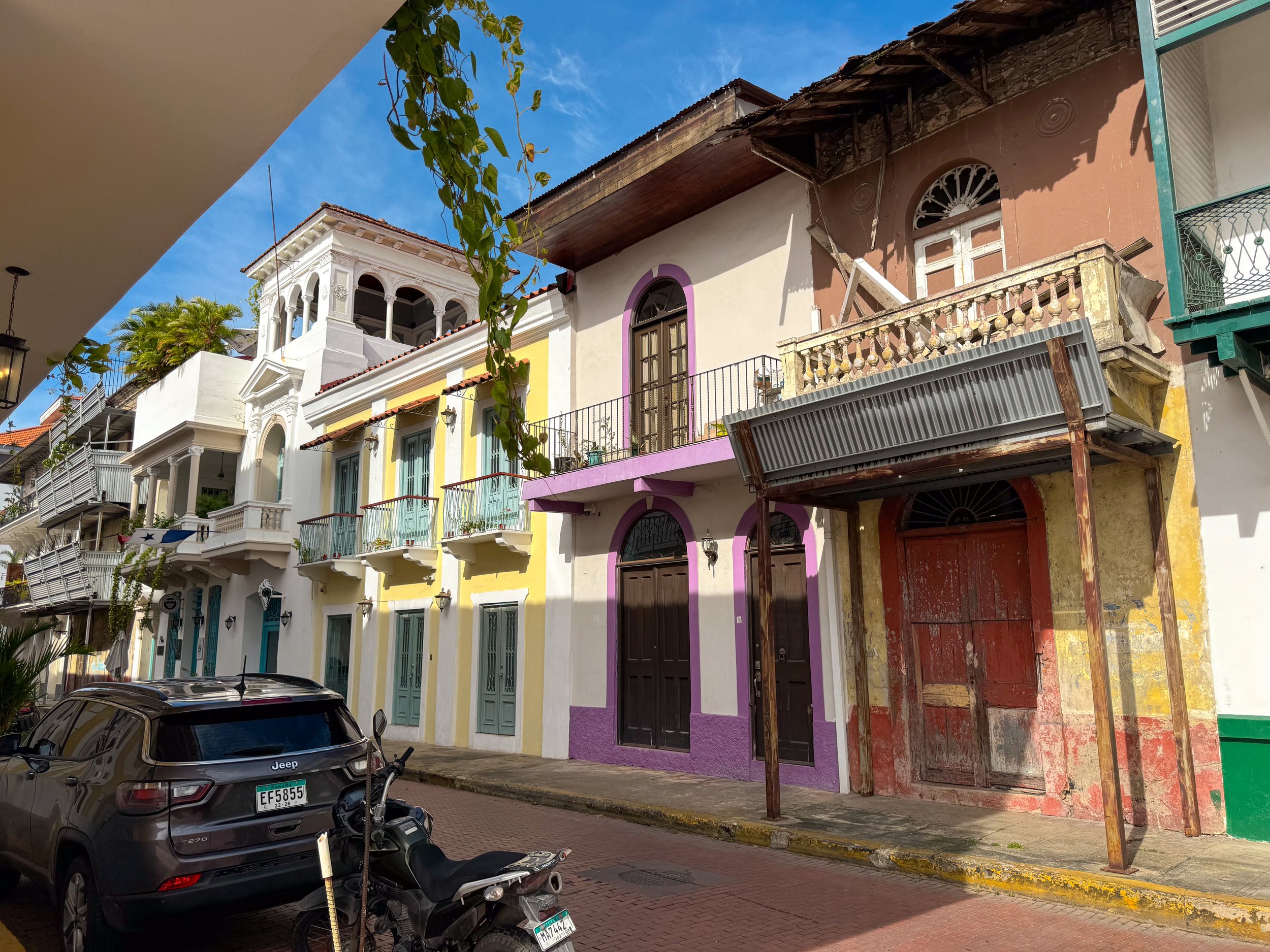
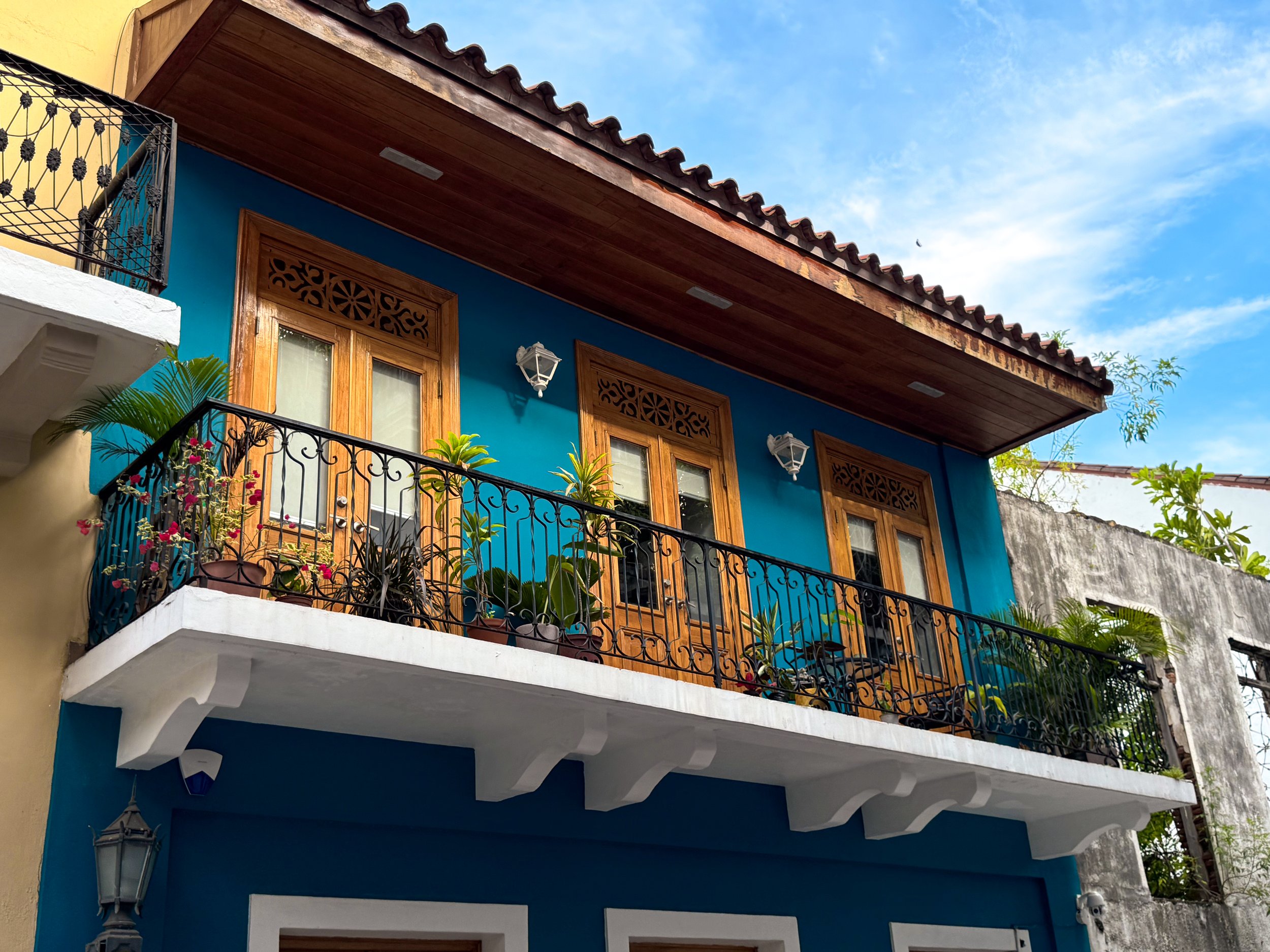
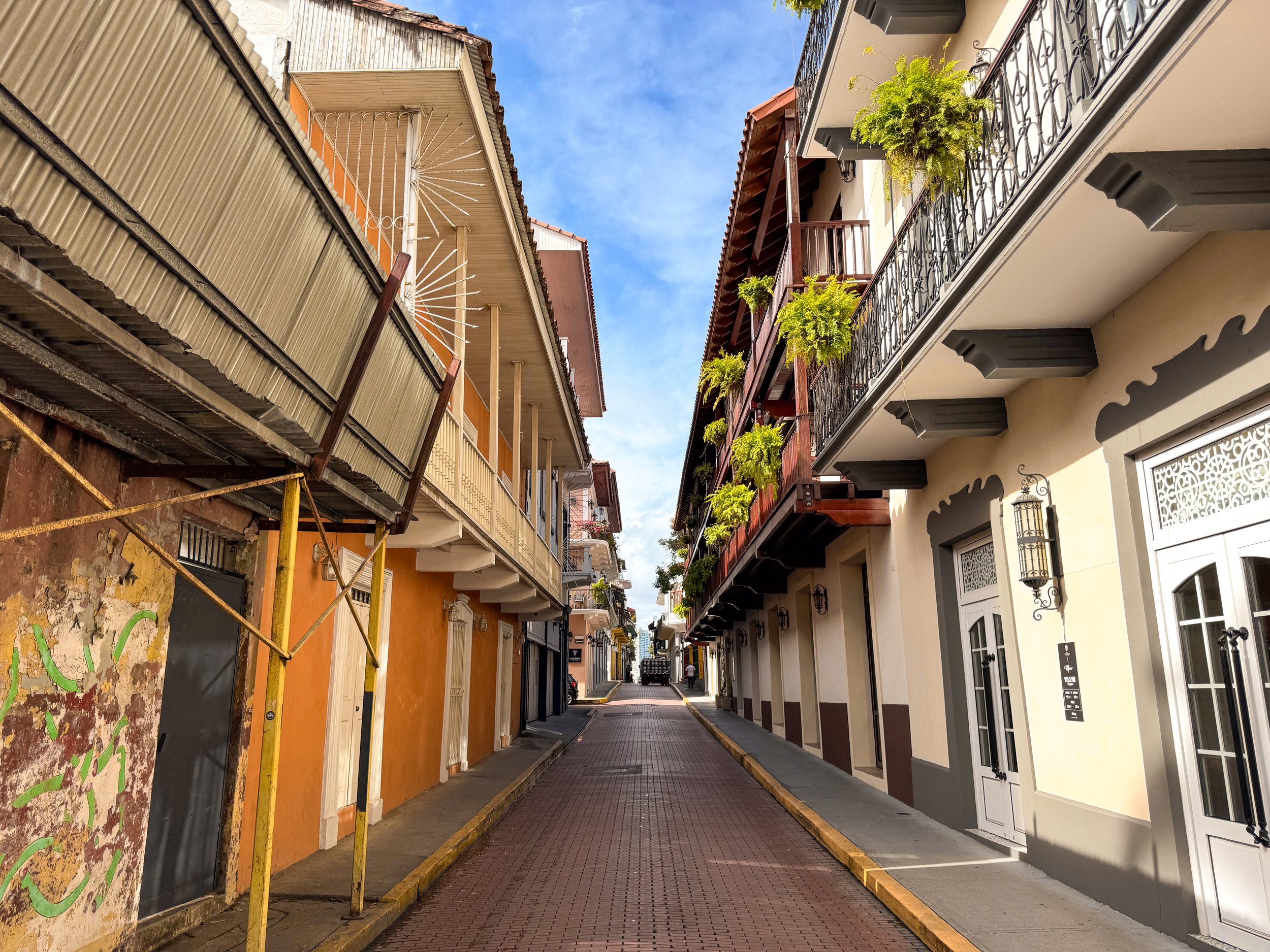
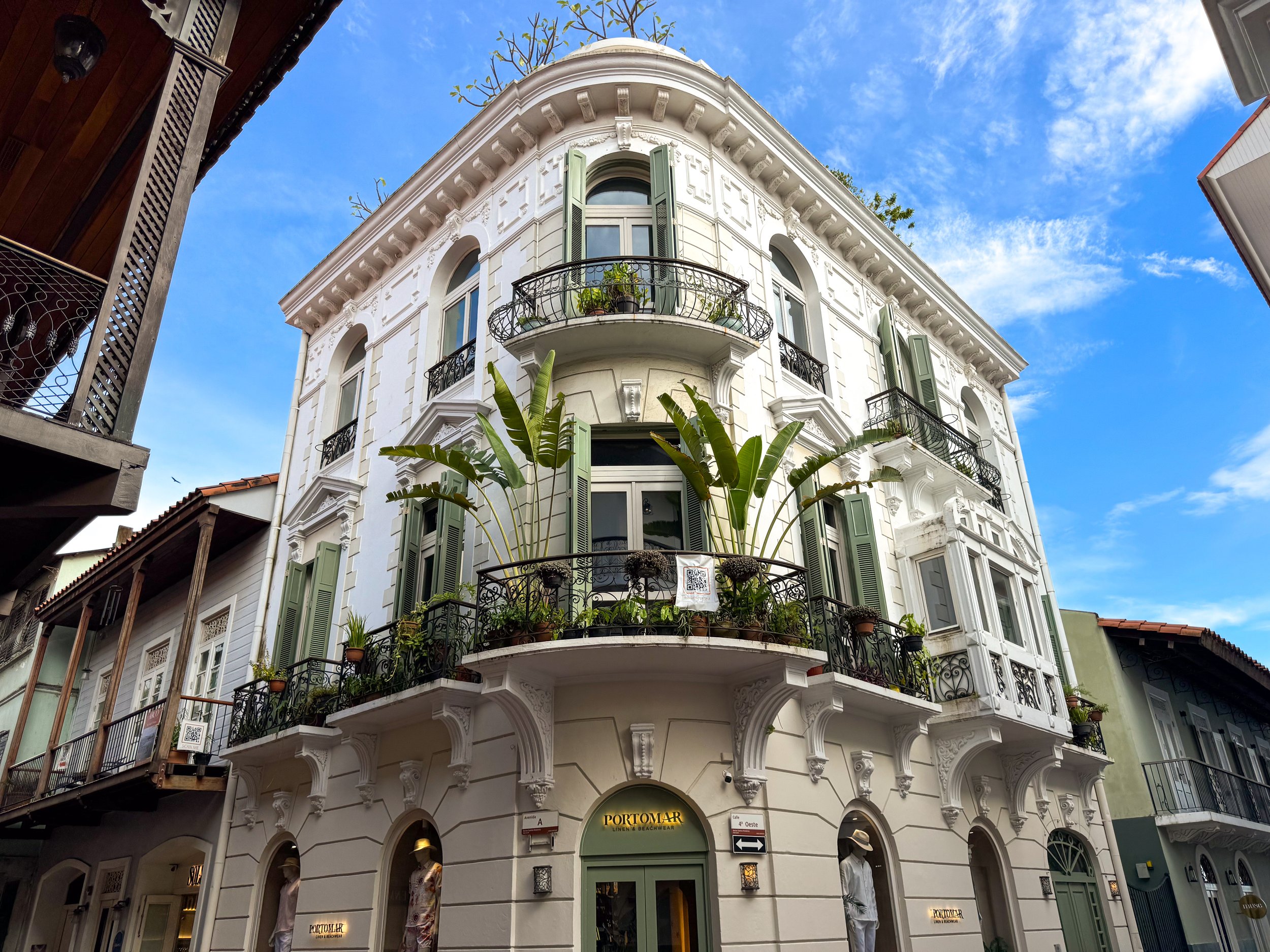
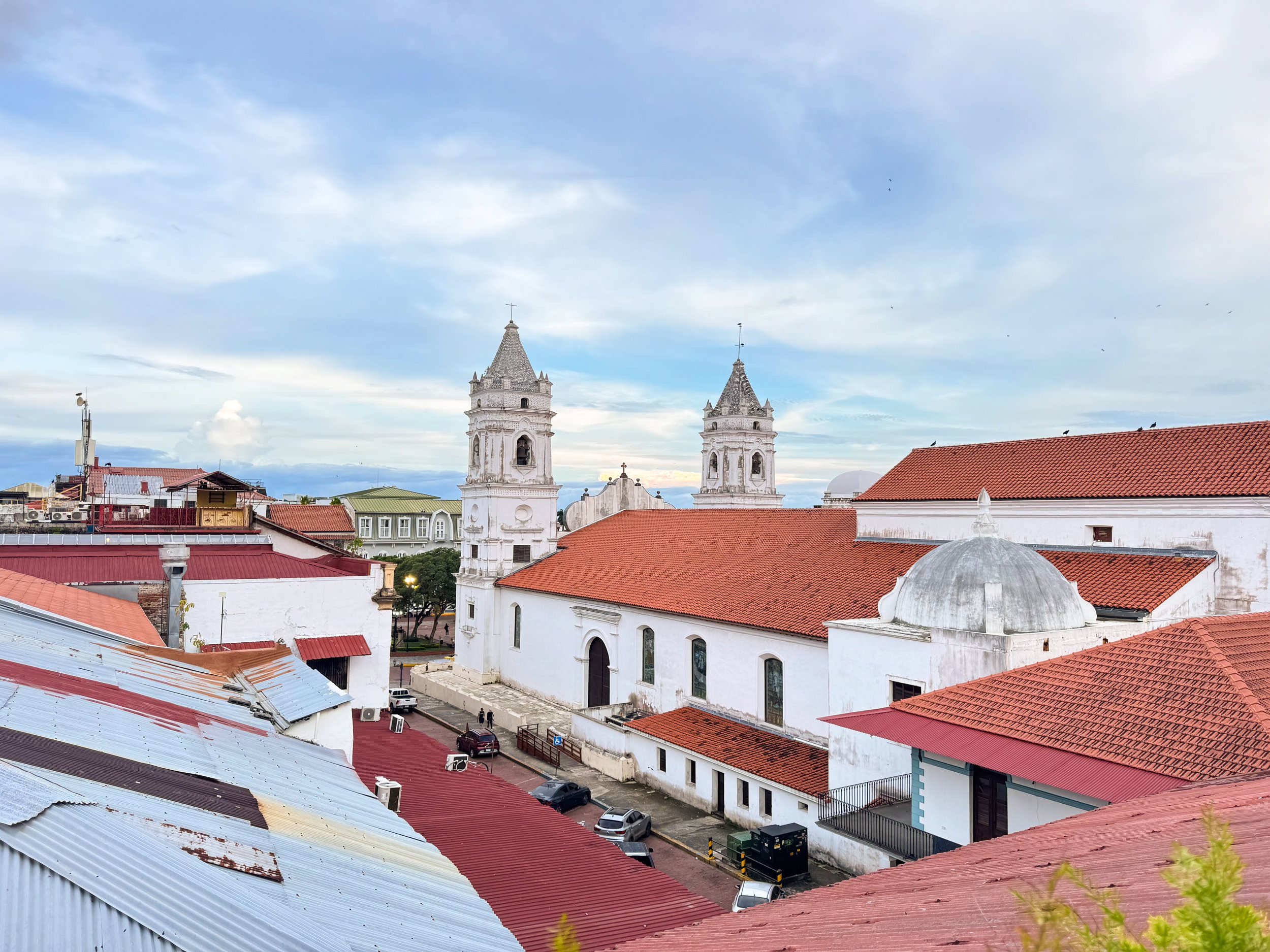
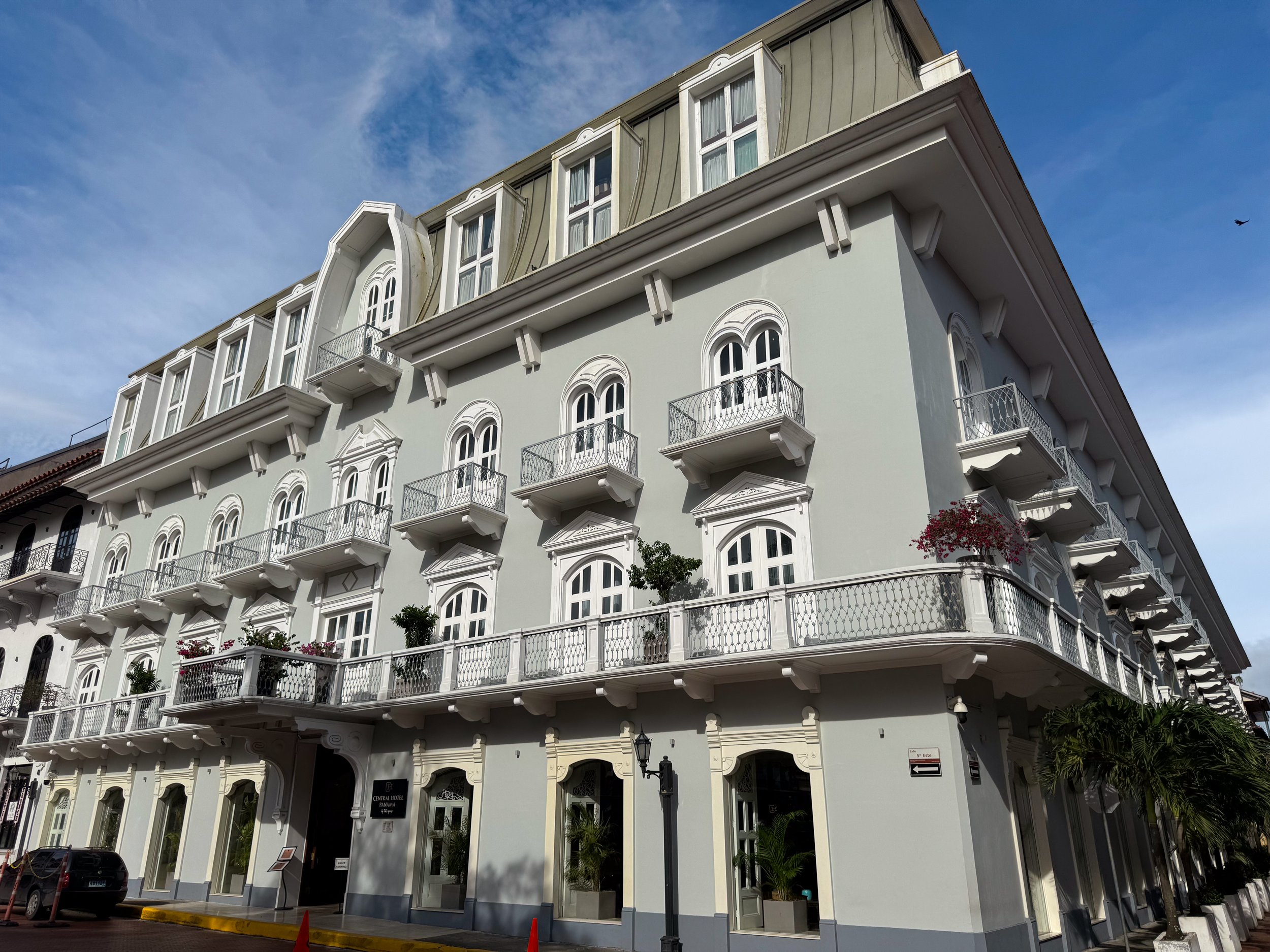
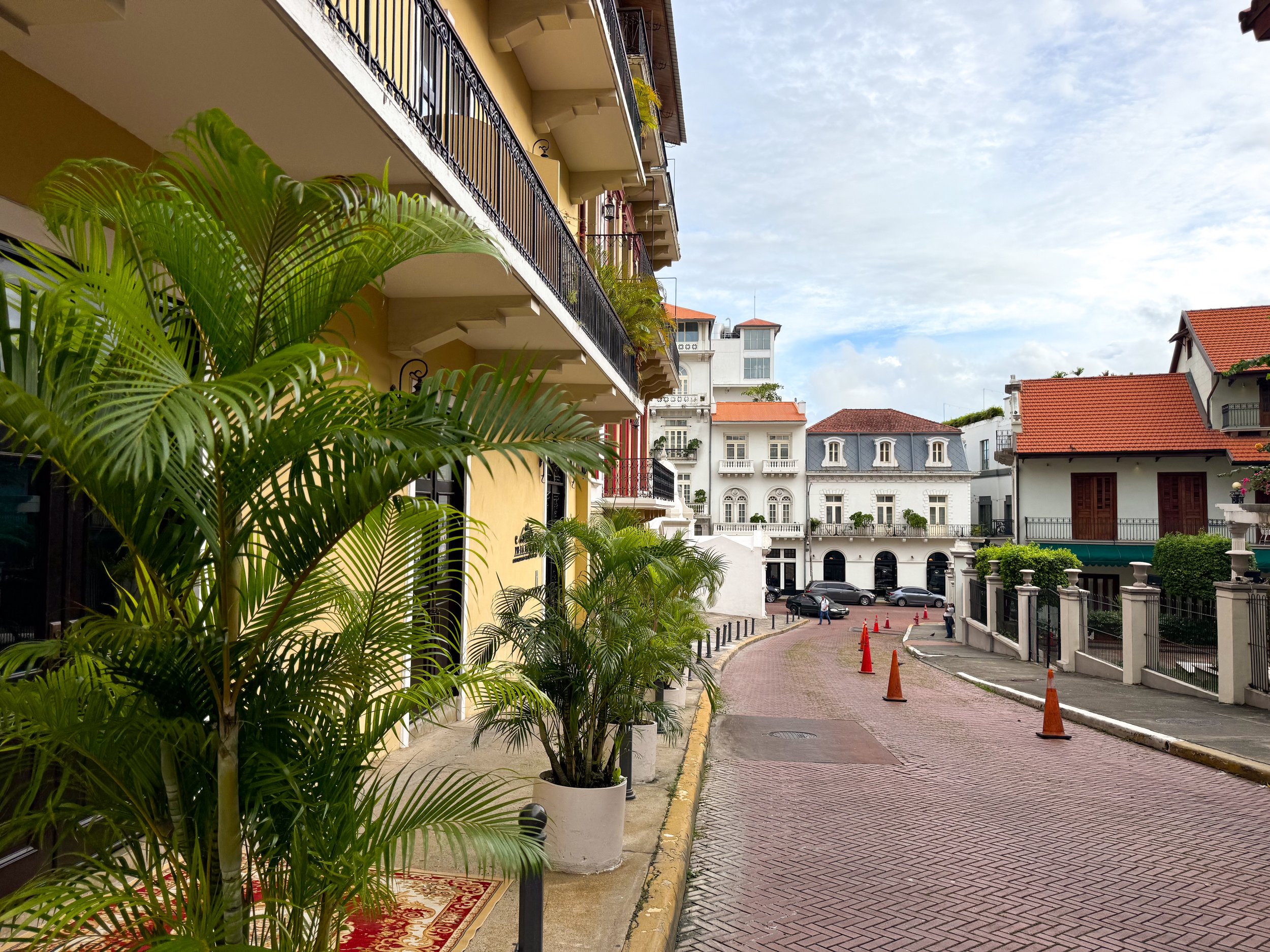
Casco Viejo
Panama City’s old town is a beautiful colonial era neighborhood built on a peninsula overlooking the Panama Bay with walled sections, seafood restaurants, rooftop bars, clothing shops, lush plazas, free museums, beautiful cathedrals and cultural sights.
Elegant Architecture
Walking down the narrow brick streets with the rails of the old street cars still visible feels like stepping through a time capsule. The elegant architecture is akin to the historic neighborhoods of Madrid with ornate facades painted in muted neutrals and pops of color, thin balconies decorated with tropical plants, warmly lit antique lanterns and clay tiled roofs. Some buildings have been well preserved while others juxtapose them as ruins now overtaken by nature.
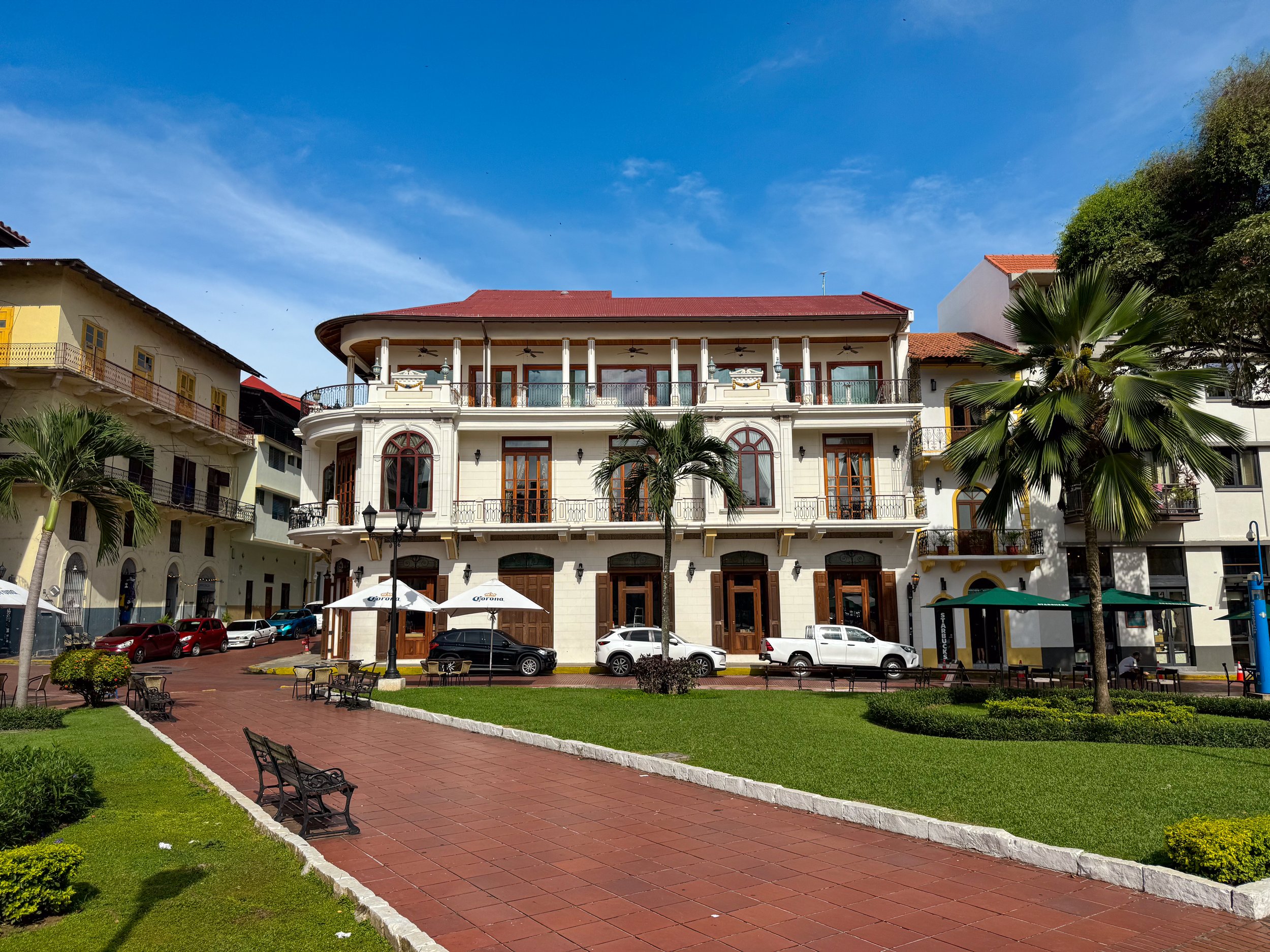
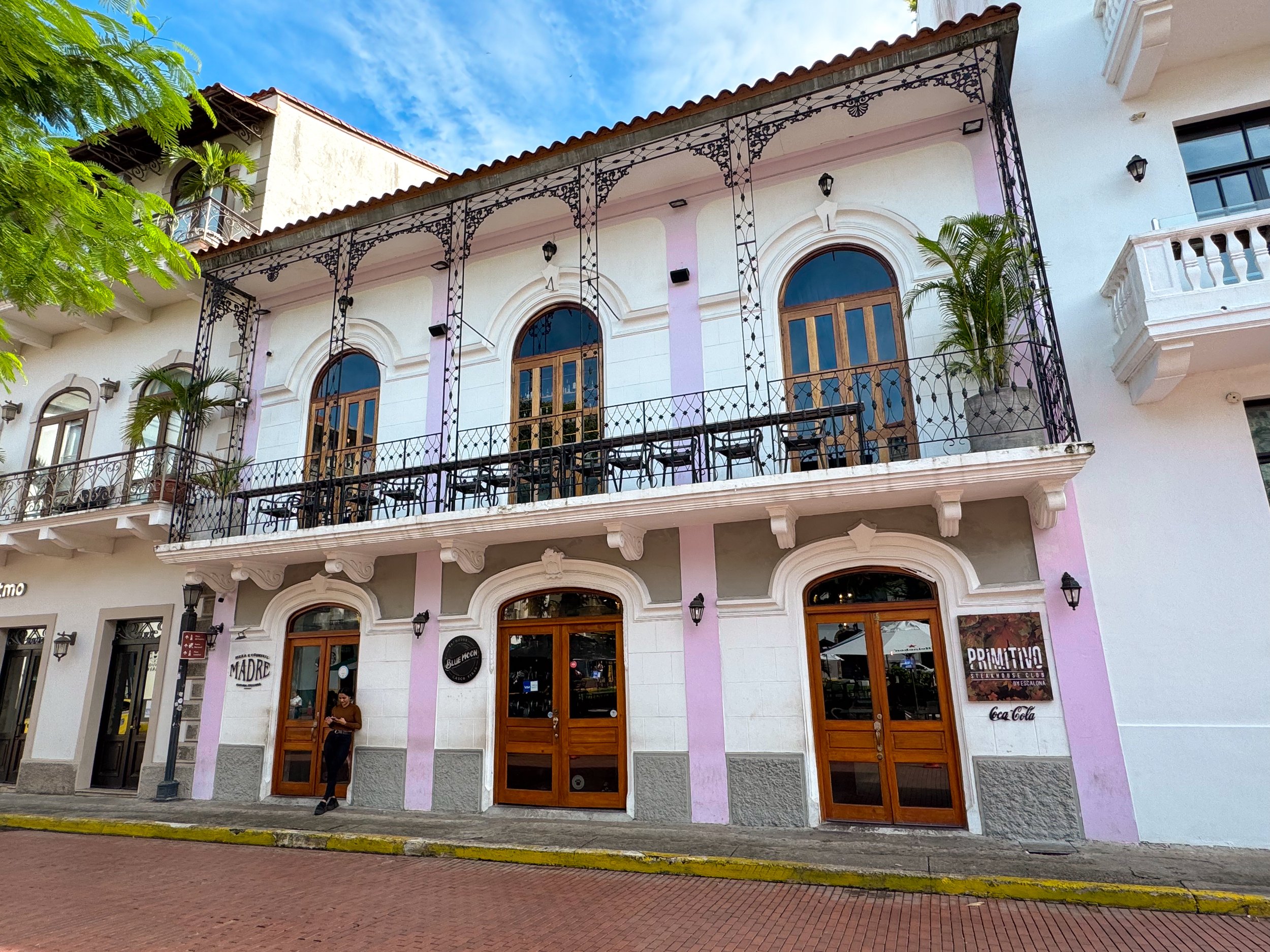
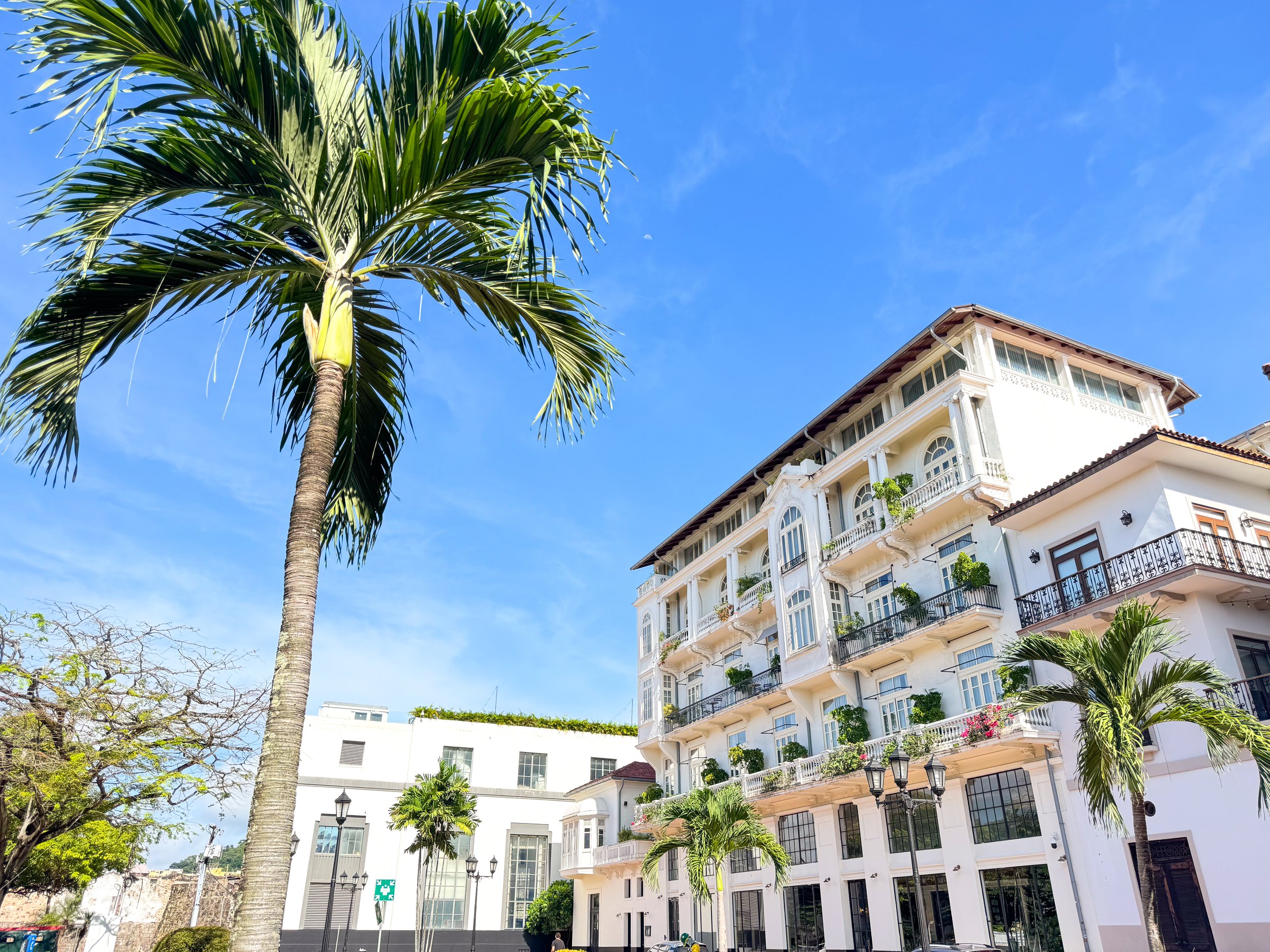

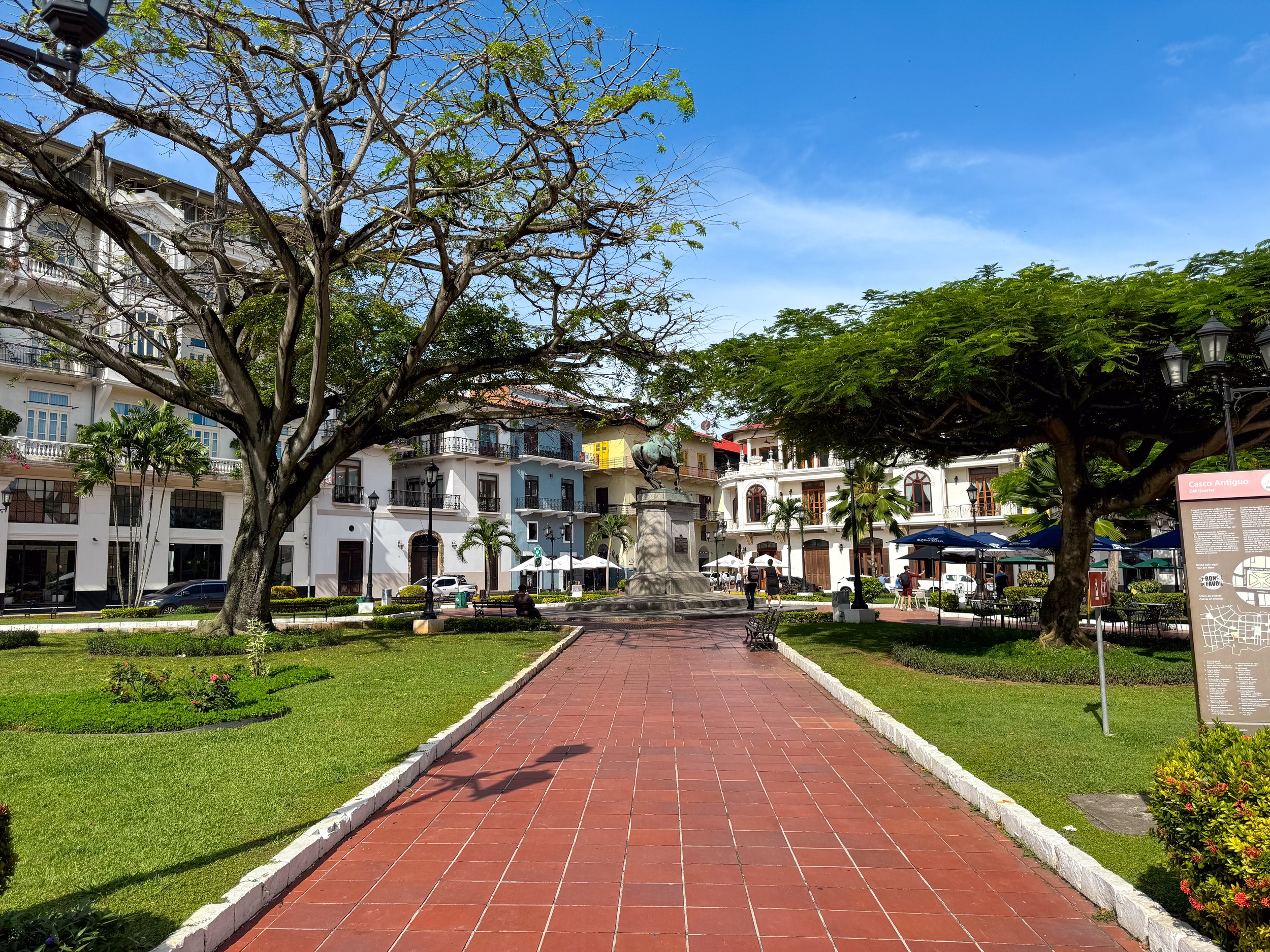
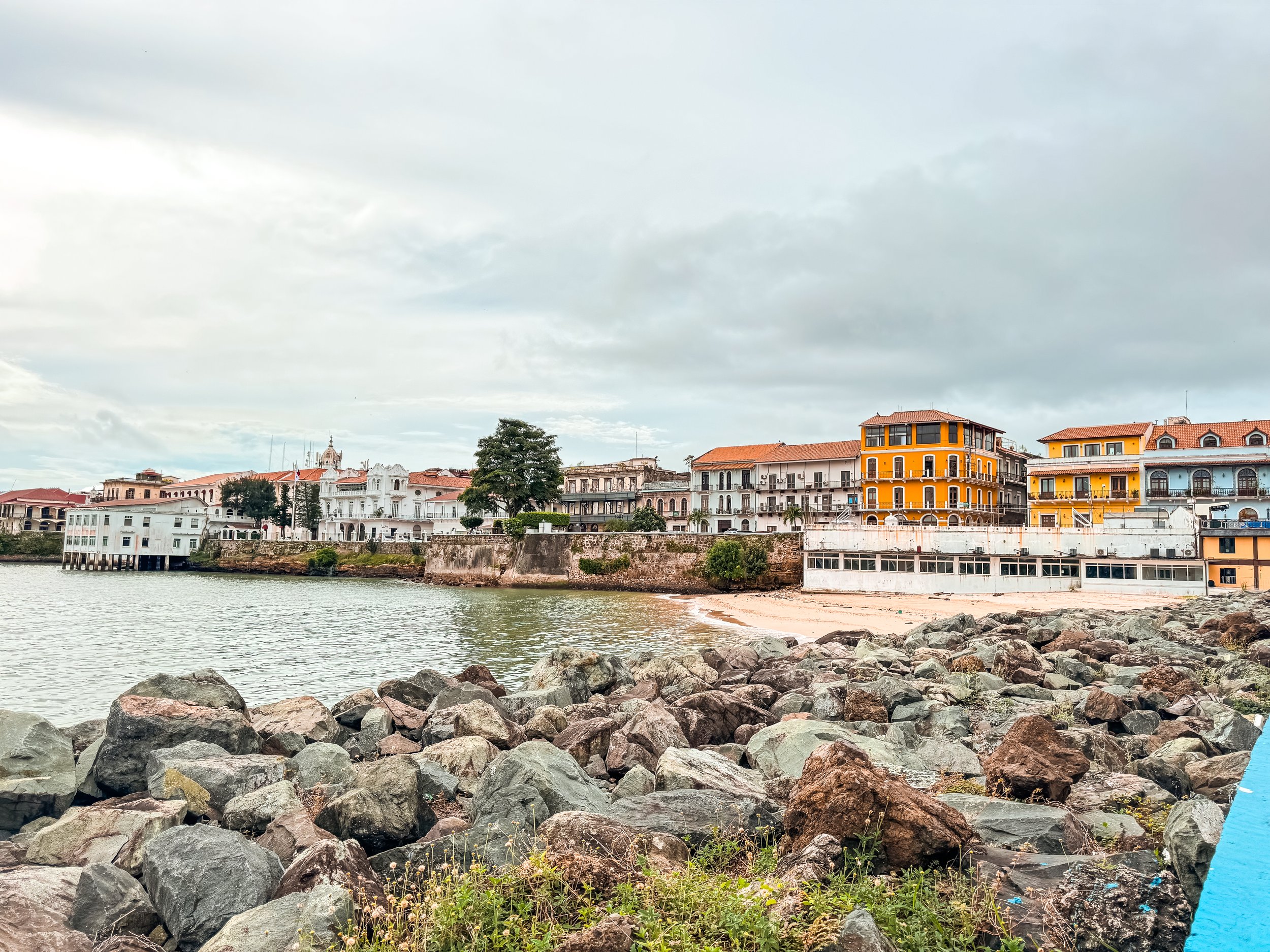
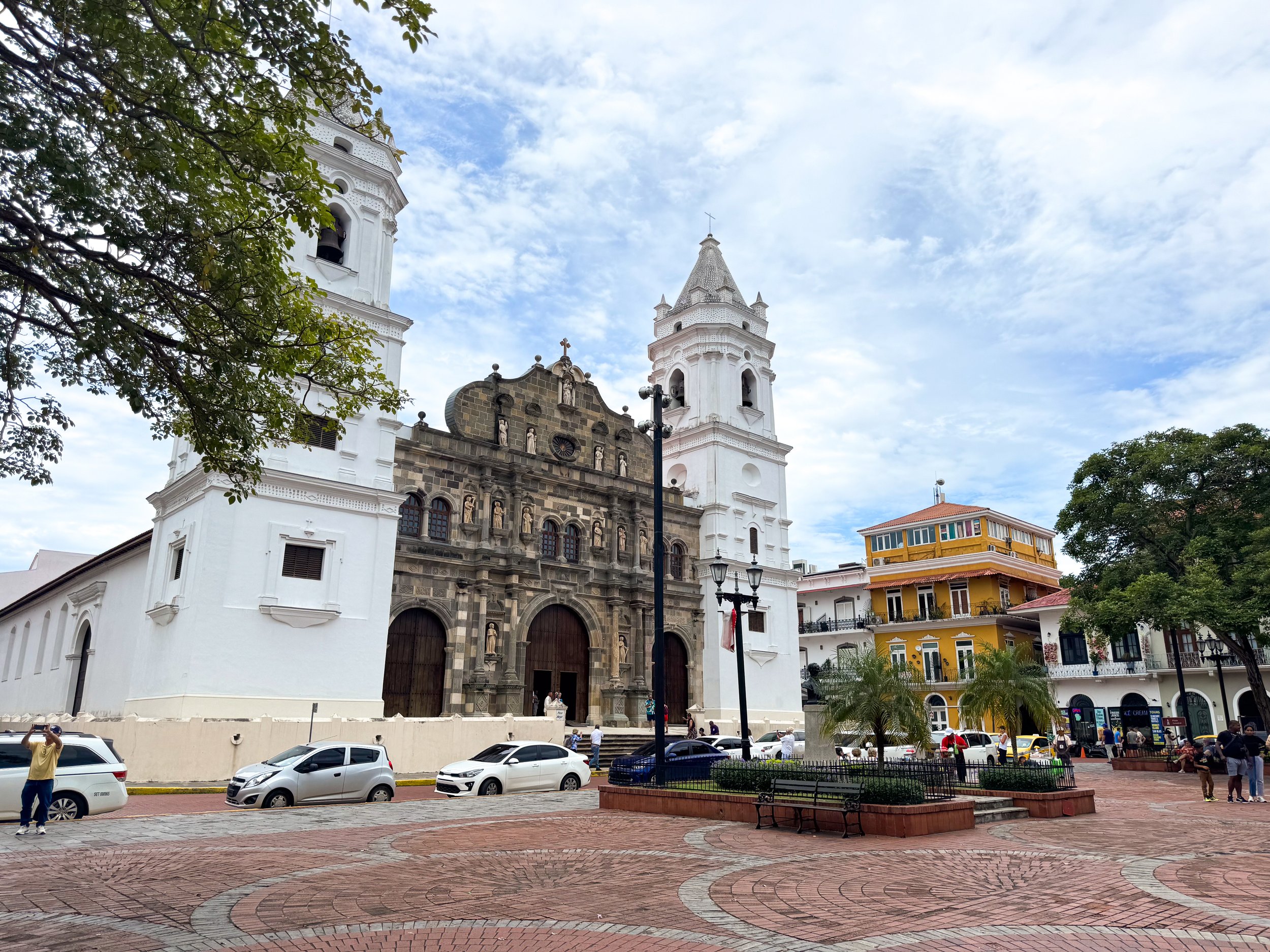
Sights
Plaza Herrera. A romantic and scenic plaza surrounded by elegant architecture, luxury hotels, boutiques and restaurants.
Plaza de la Catedral. A brick paved plaza in the center of Casco Viejo with a gazebo, trees and park benches. It’s flanked by the La Catedral de Panama, colonial architecture and museums. Artists often come here in the early morning with sketchbooks to draw the sights around the plaza.
La Catedral de Panama. The city’s main cathedral built with an ornate stone facade, large wooden door and two white bell towers.
Cintra Costera. A road and walkway several miles along the coast from the modern financial center to the old town of Casco Viejo with city views.
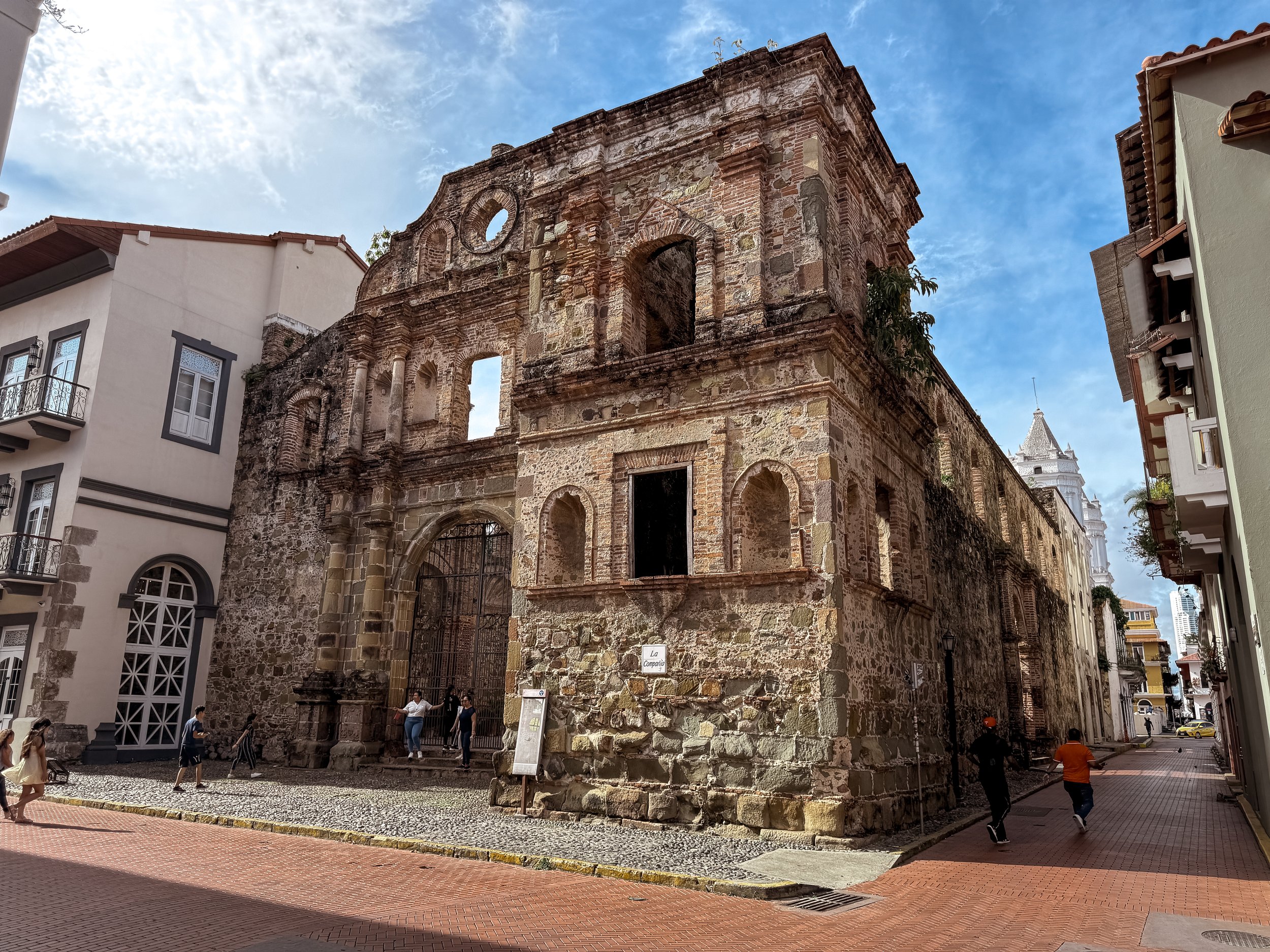
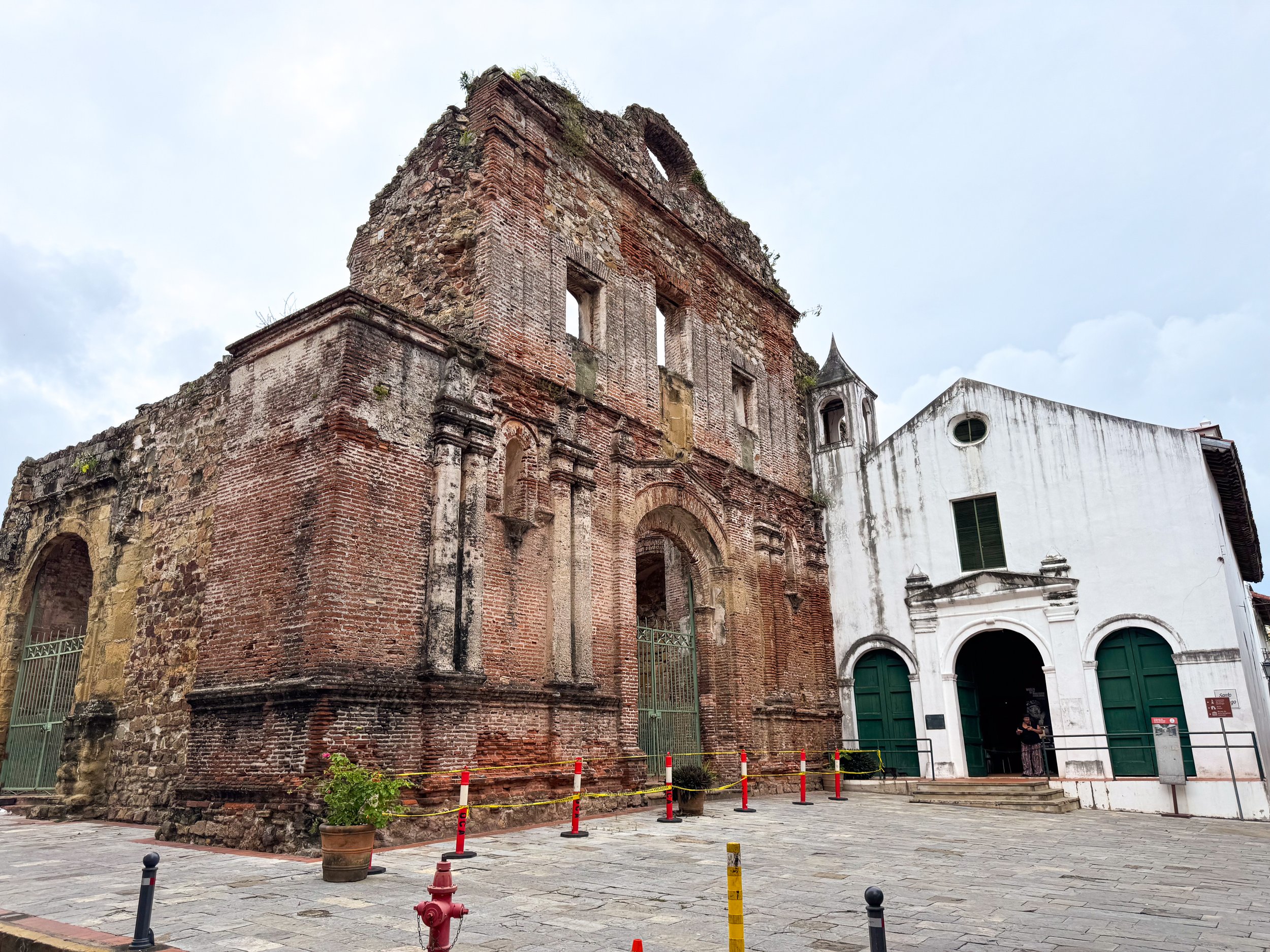
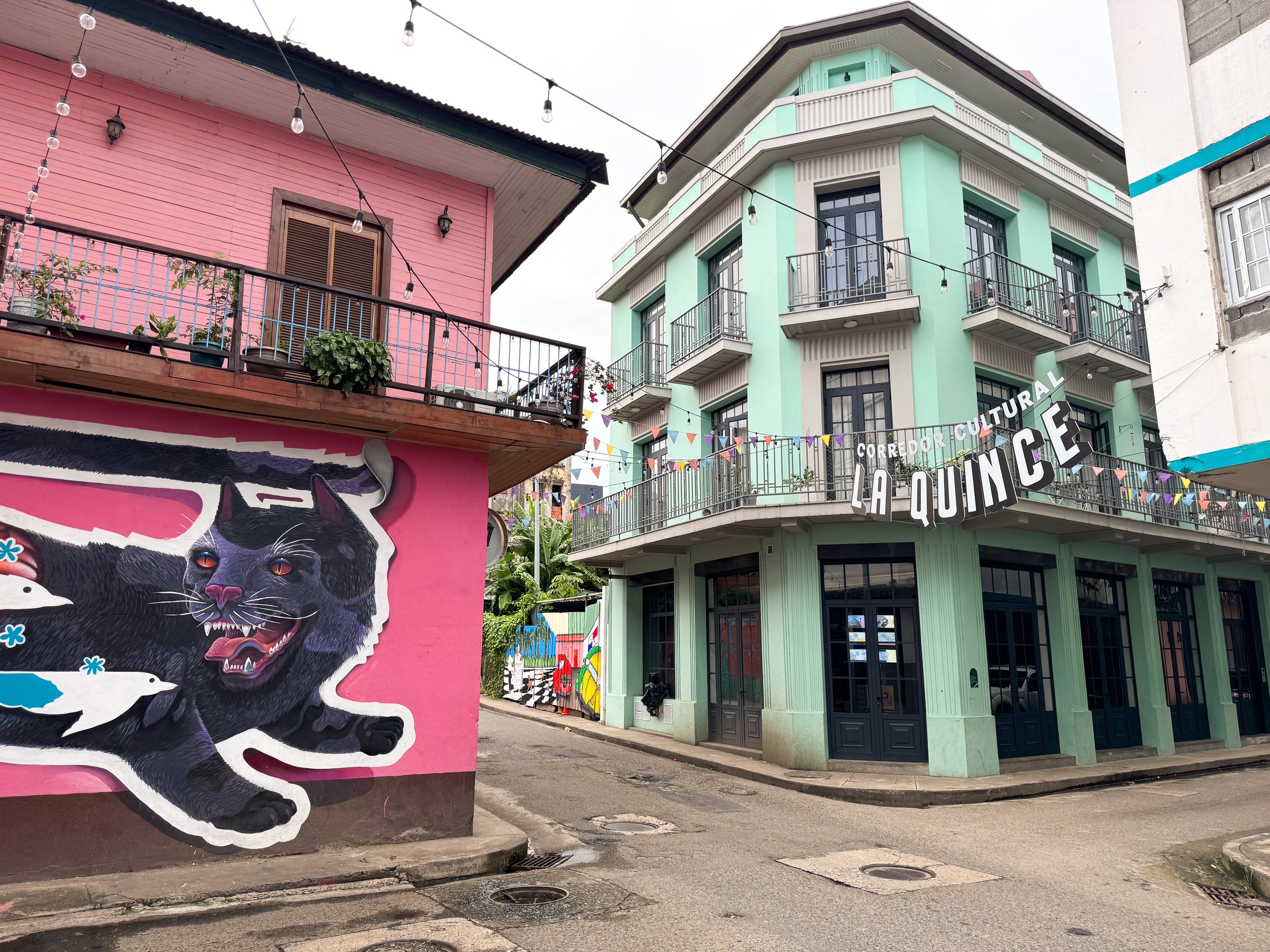
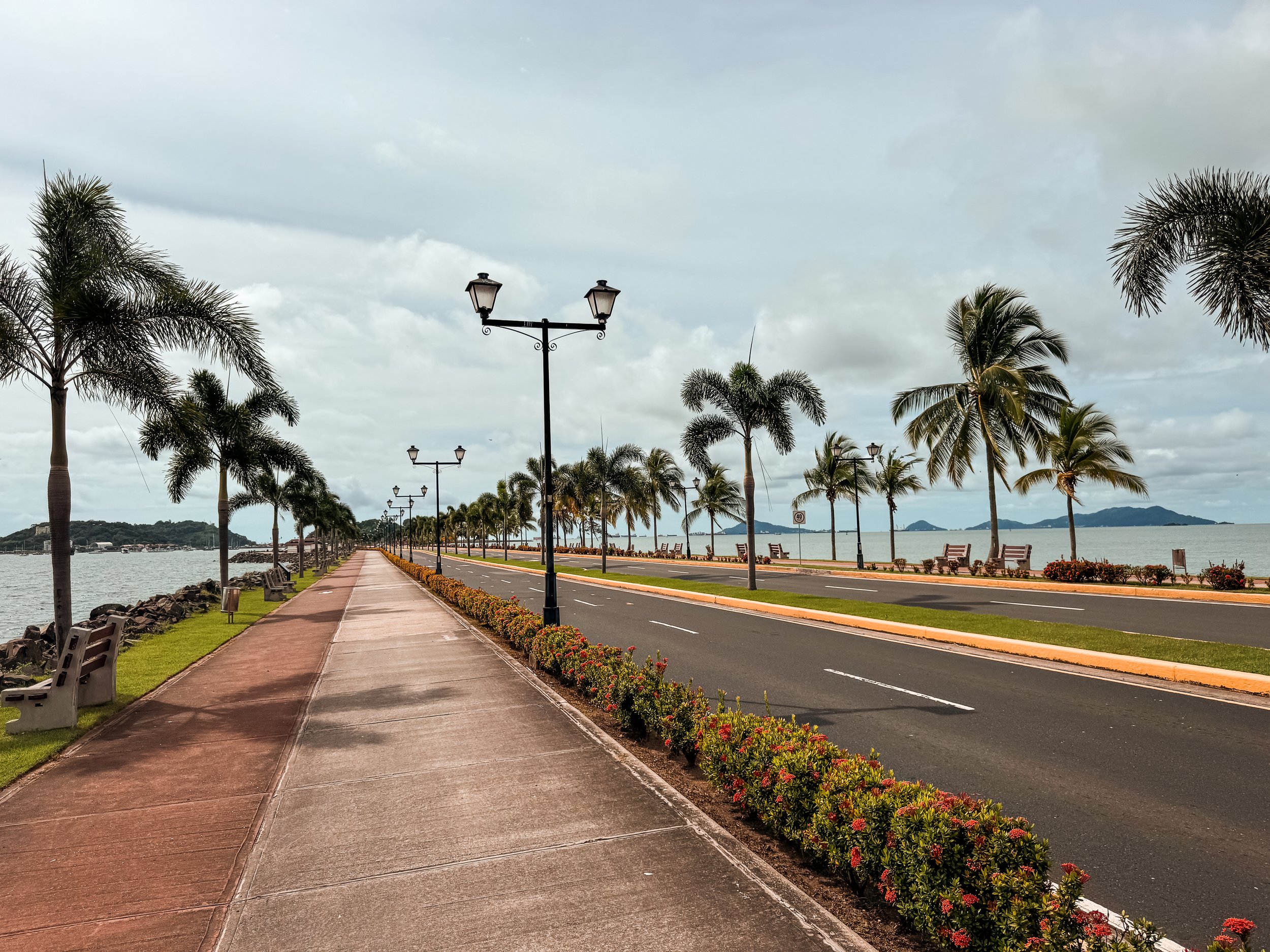
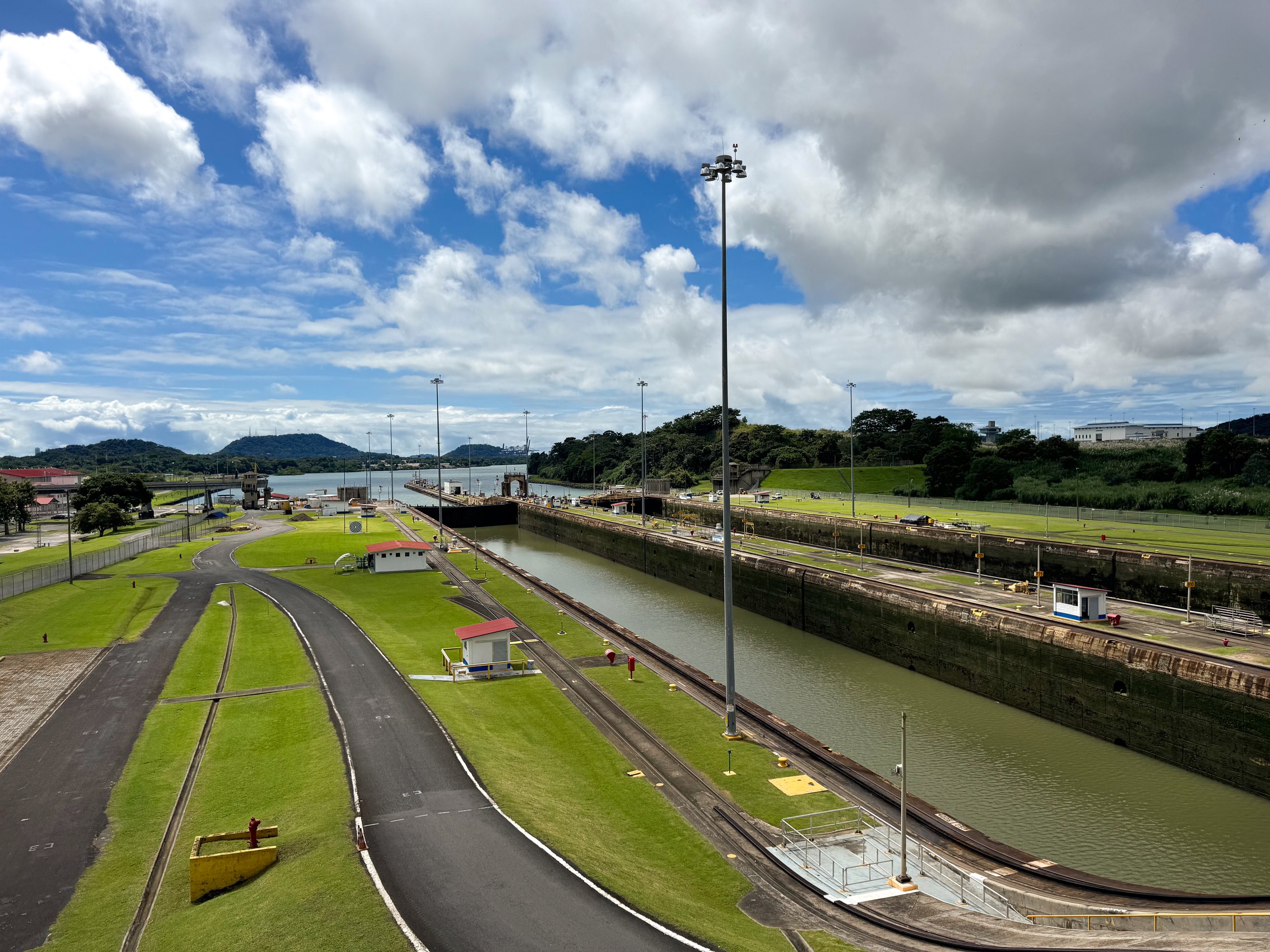
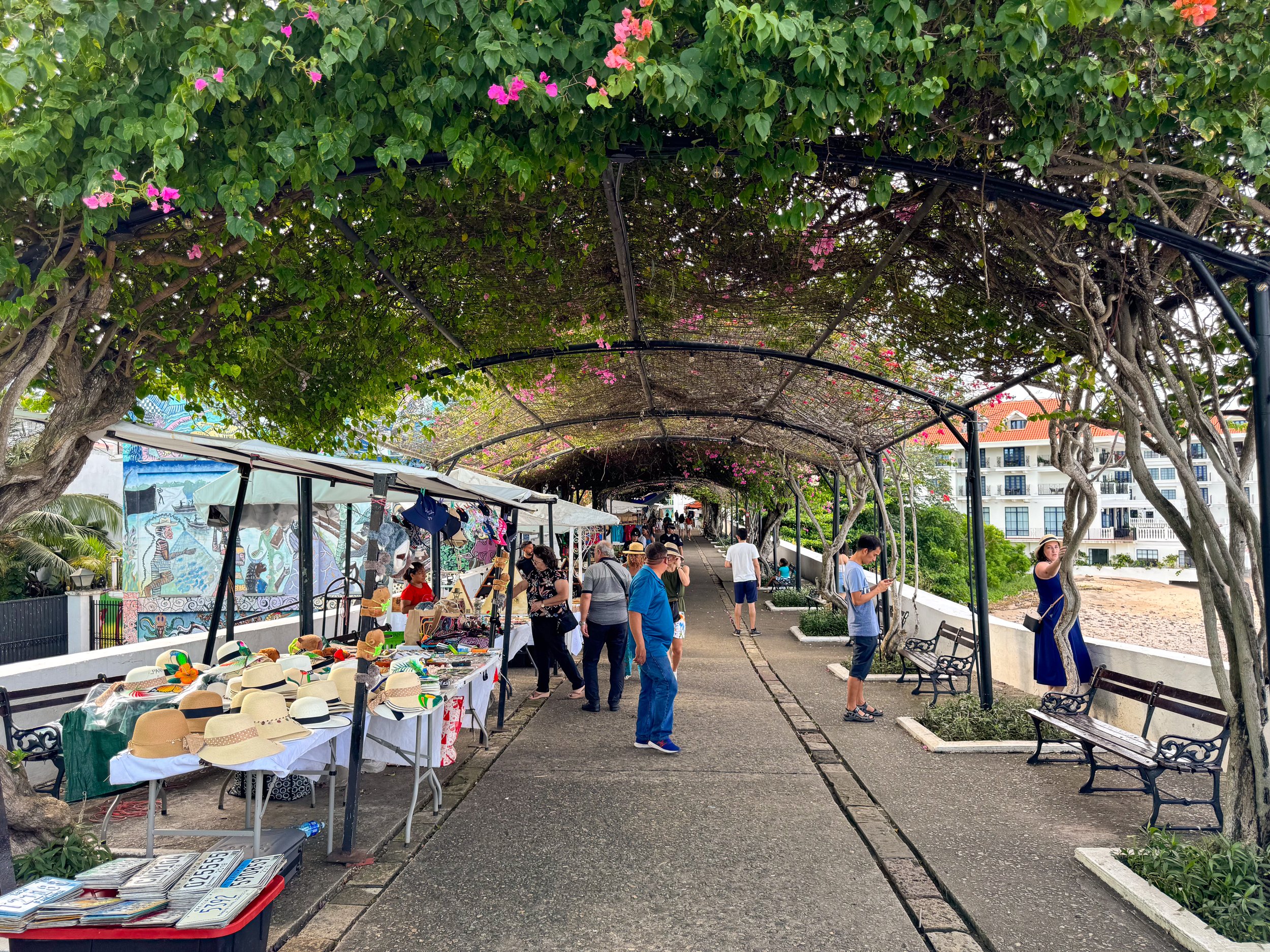
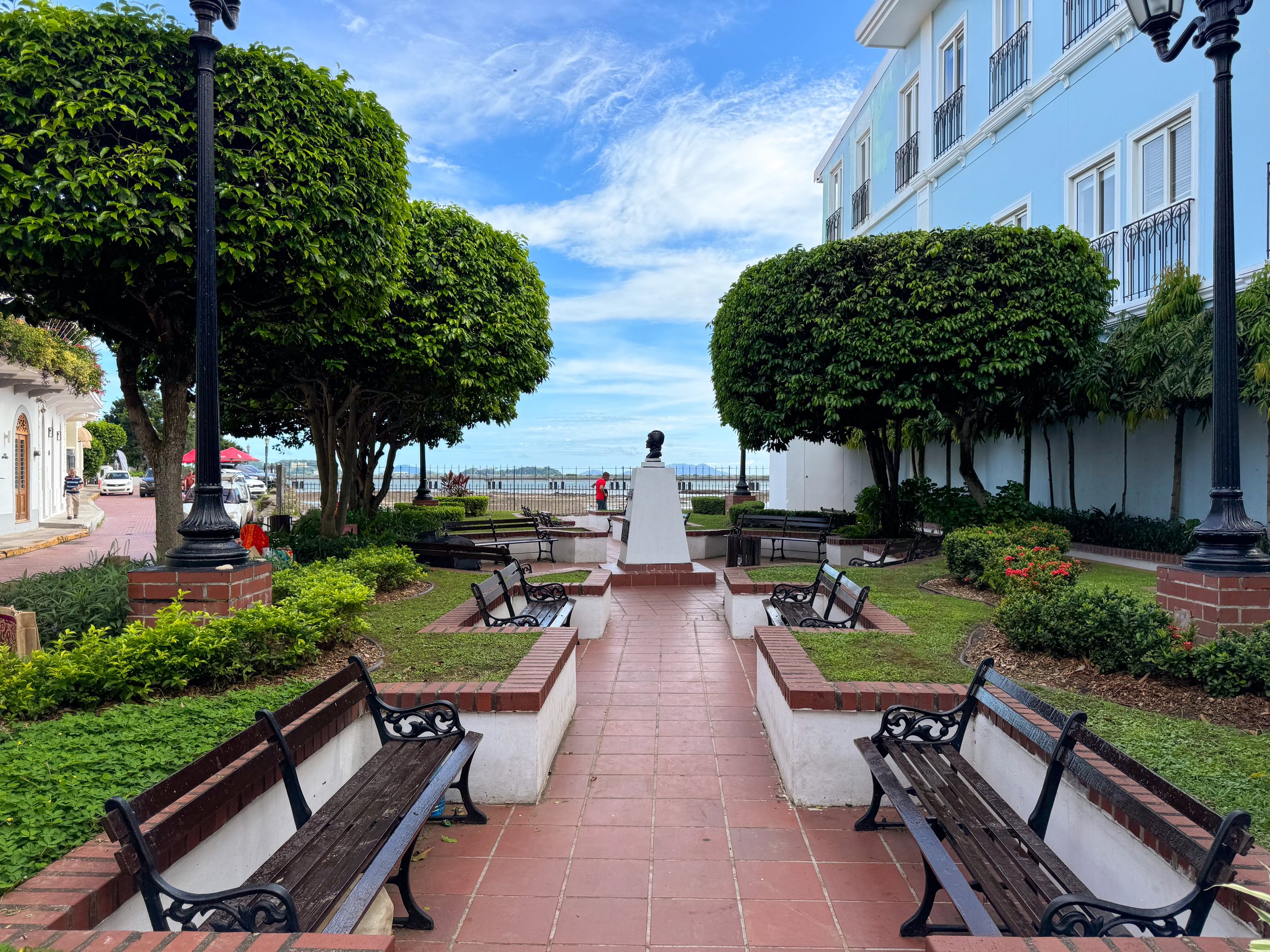
Iglesia de la Compañía de Jesús. The stone and brick ruins of a former church. All that remains is the crumbling facade, walls and interior courtyard
Convento de Santo Domingo. The crumbling brick ruins of a historic convent and church with an adjacent chapel hosing a museum of religious artifacts.
Iglesia Nuestra Señora de La Merced. A stone facade cathedral with two simplistic white bell and clocktowers. We passed by here when the bells were in full swing letting out dongs heard across the old town.
Paseo de las Bovedas. A scenic waterfront walkway along the colonial wall in Casco Viejo. There is a monument dedicated to the history of Panama, views of the modern city and a floral covered walkway with vendors selling handicrafts and souvenirs.
Corridor La Quince. An arts district outside of Casco Viejo with graffiti and murals covering the buildings & string lights draping the streets. Many of the colonial buildings are in disrepair while others have been renovated to modern standards.
Plaza Carlos V. A small garden plaza overlooking the Panama Bay dedicated to one of the first Spanish rulers of Panama credited with the idea of creating the Panama Canal. Guna women often sell their Molas and other handcrafted products from here.
Plaza Medio Baluarte. A small but photogenic plaza with colorful colonial buildings, a central fountain and an overlook along the wall. We watched as artists painted the city scenery early one morning.
Plaza Simón Bolívar. A plaza with a large monument dedicated to Simón Bolívar, the leader who lead several Central and South American countries to independence from Spain. The plaza is flanked by a cathedral and restaurants.
Amador Causeway. A palm lined road and walkway connecting three islands near the mouth of the Panama Canal. Come here to walk the scenic 3km road, watch ship waiting to enter the Panama Canal and admire views of the city skyline. Along the road are bike rentals, restrooms, overlooks and historical placards. Towards the islands are numerous restaurants, hotels, a marina and cruise terminal.
Miraflores Visitor Center. A lock system and lookout on the Panama Canal. Come watch ships pass through, learn about the canal’s history and watch a movie about it narrated by Morgan Freeman.
Good to Know: Plan your visit around when ships pass through the locks. Not knowing that ships pass through at infrequent times, the next one wasn’t for over 3 hours when we visited.
Getting Here: The visitor center is reachable by bus from Albrook Station or taxi. It can take a little over an hour to reach from Casco Viejo by bus or 20min by car.
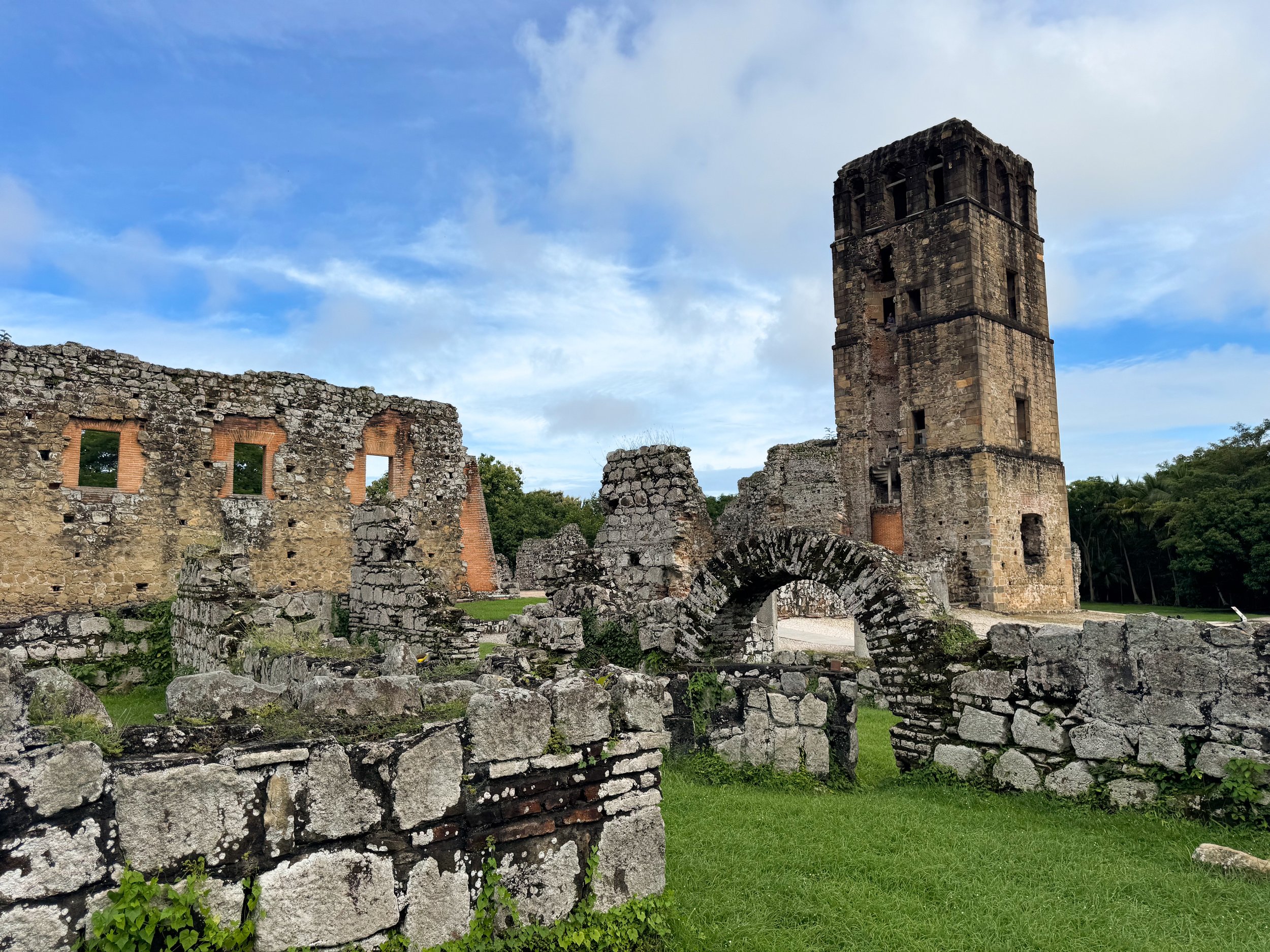
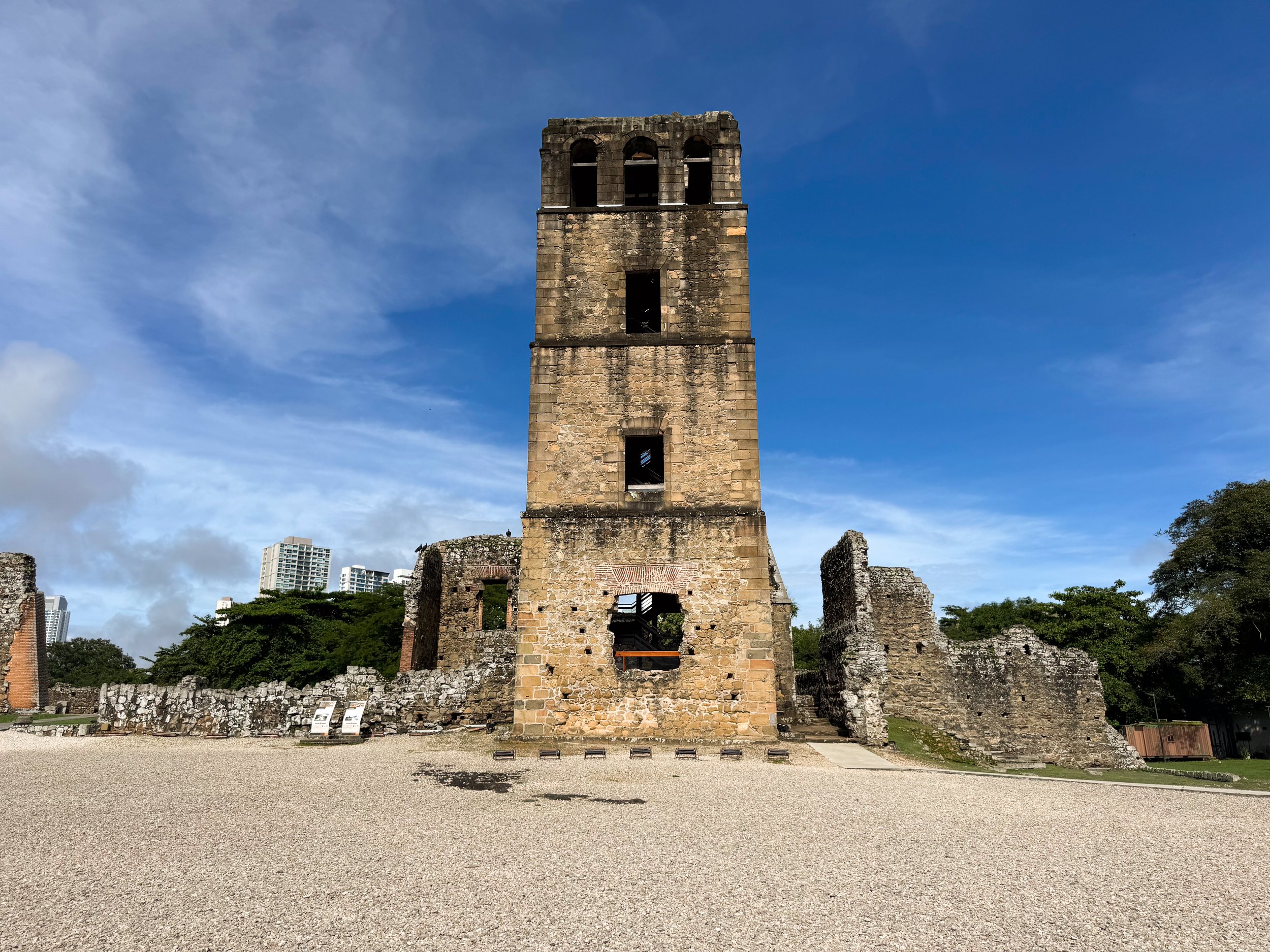

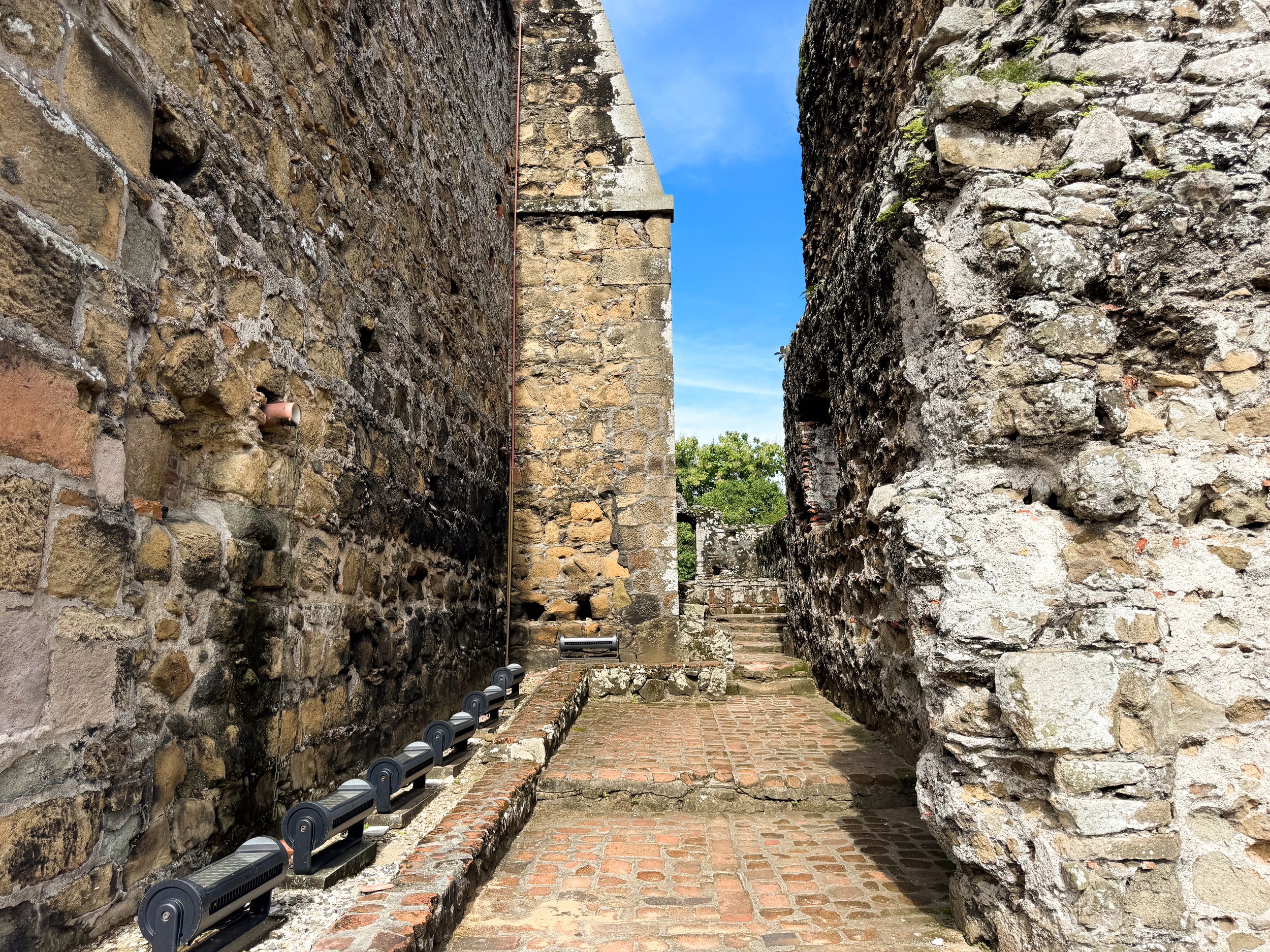
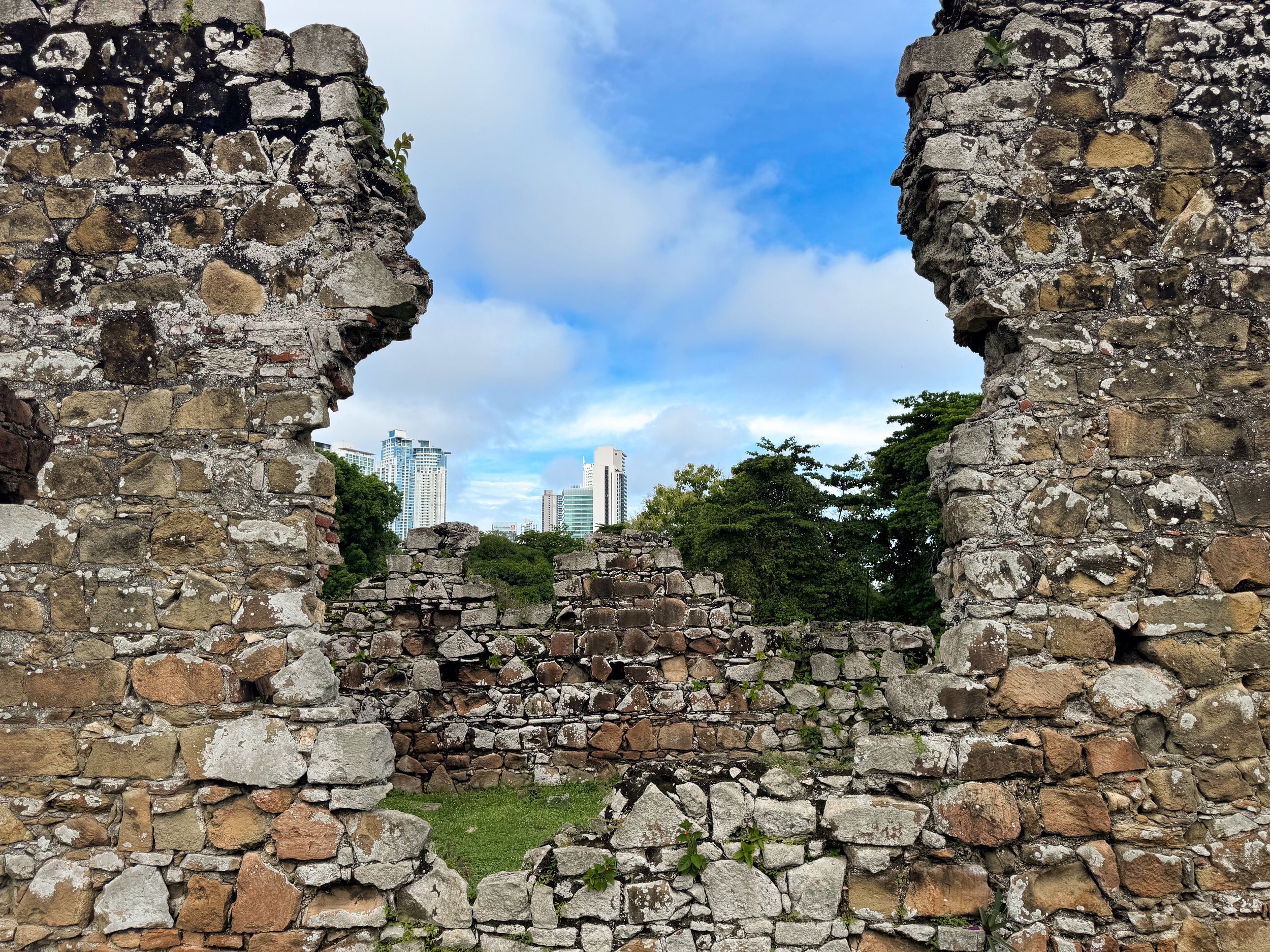
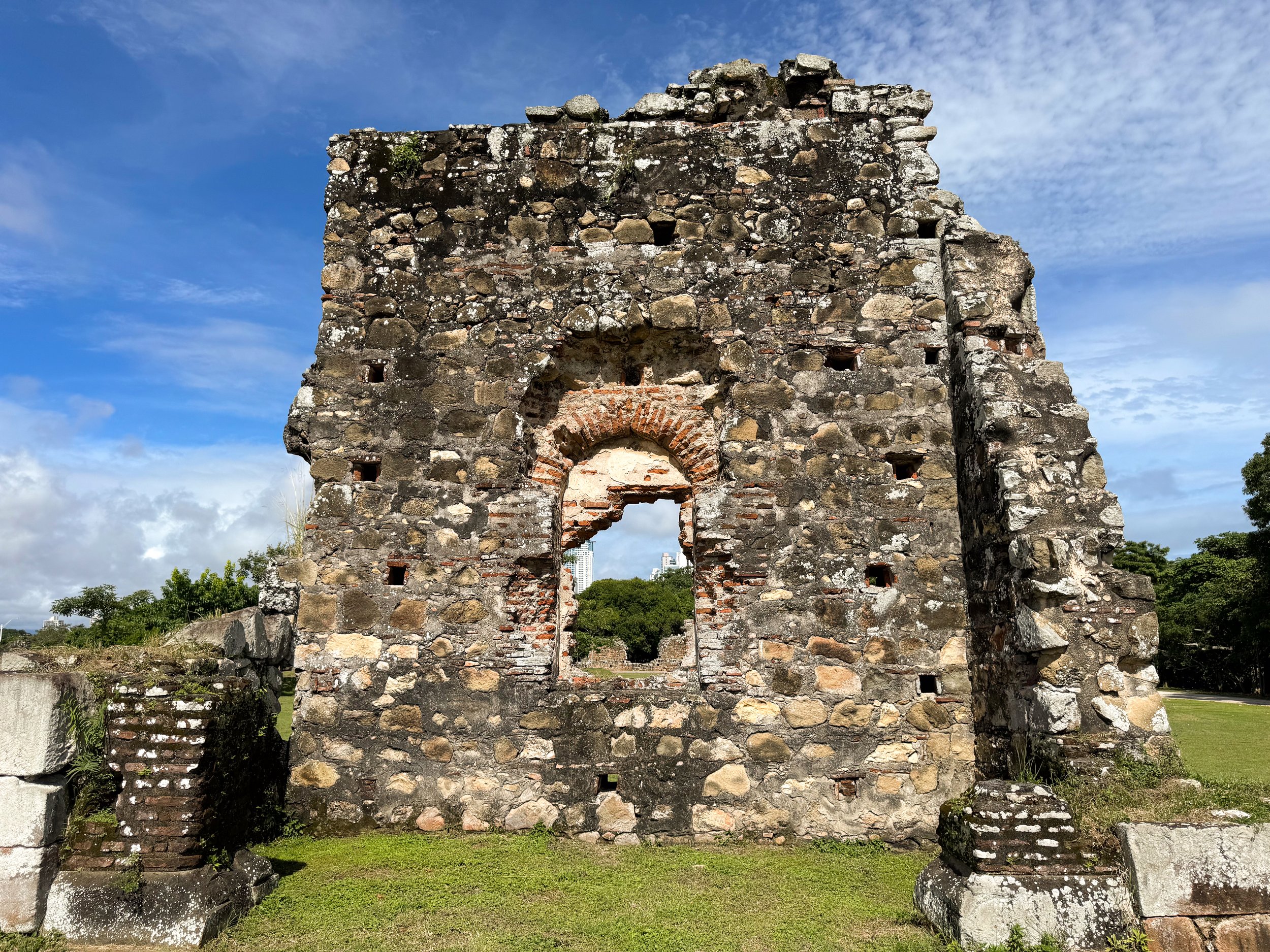

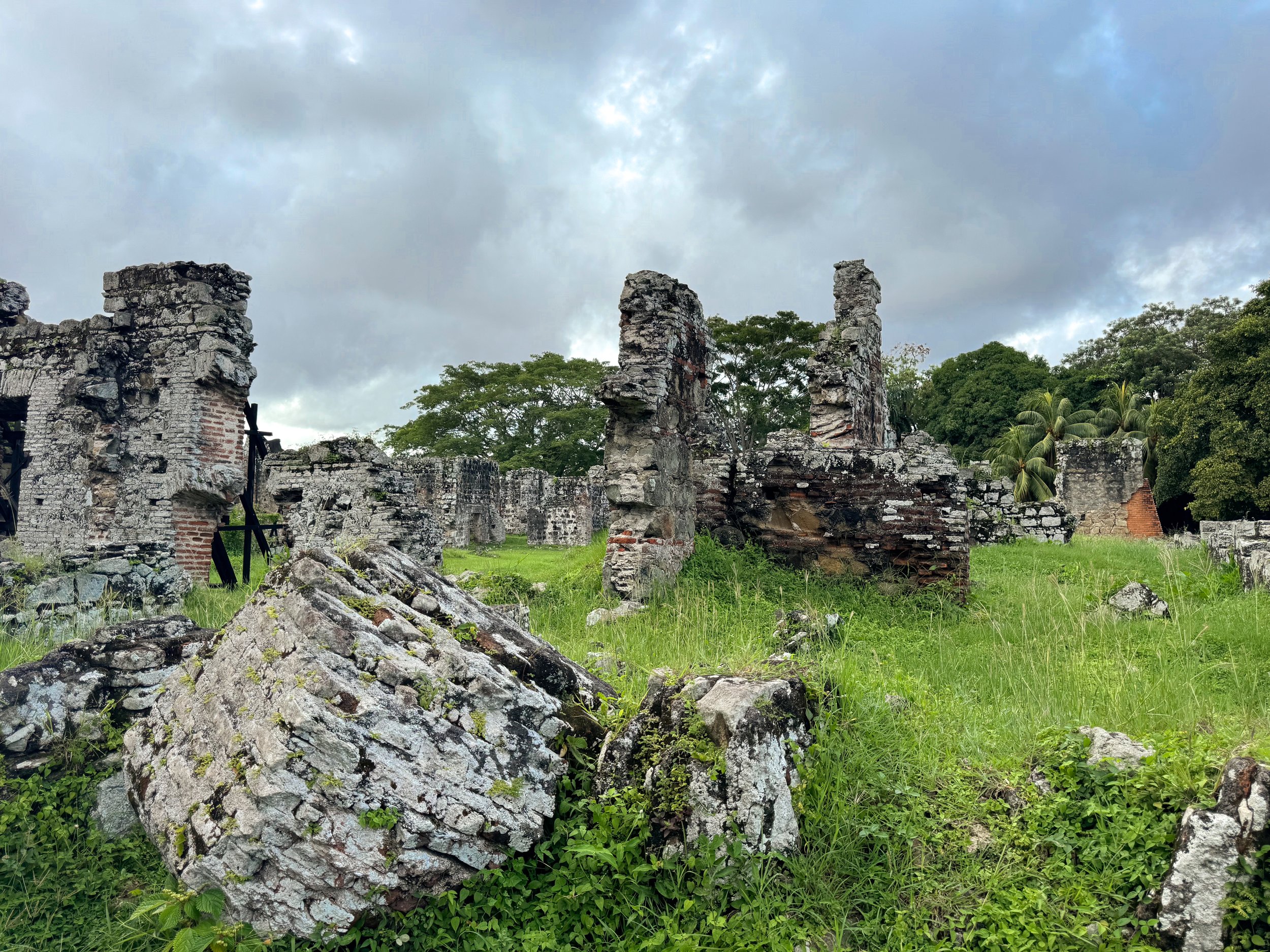


Museums
Panama Viejo. An archeological park with the crumbling brick and stone ruins of the original colonial Panama City. The city had many houses, multiple churches, roads, a grand plaza, market, cistern, bridge and tall bell tower. It was left to ruin after a major earthquake, multiple fires and pirate attacks. Come here to climb the 116 step tower with lookouts over the ruins, modern day skyline and Pacific Ocean. The view offers a unique contrast to the bustling city surrounding it.

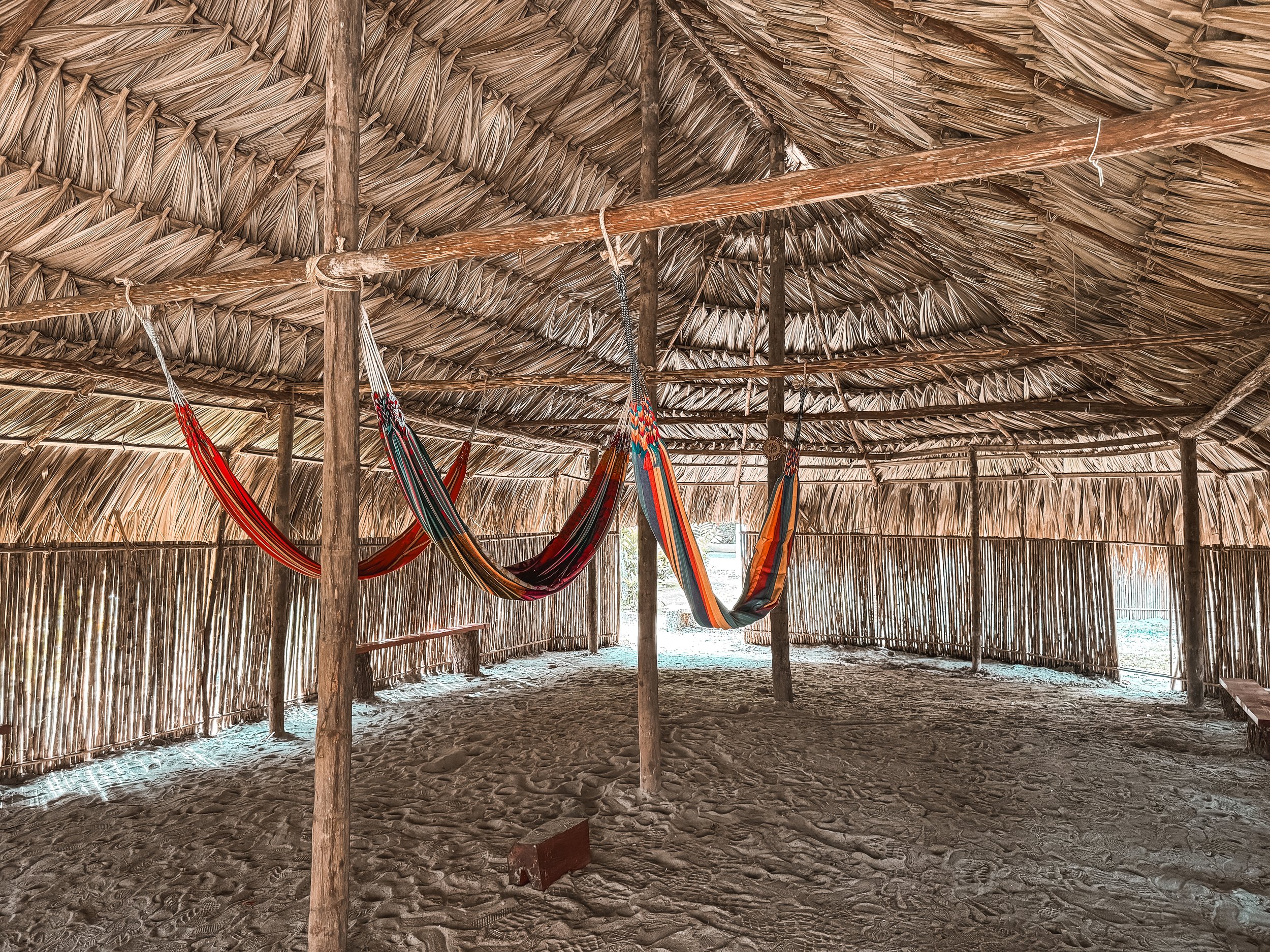
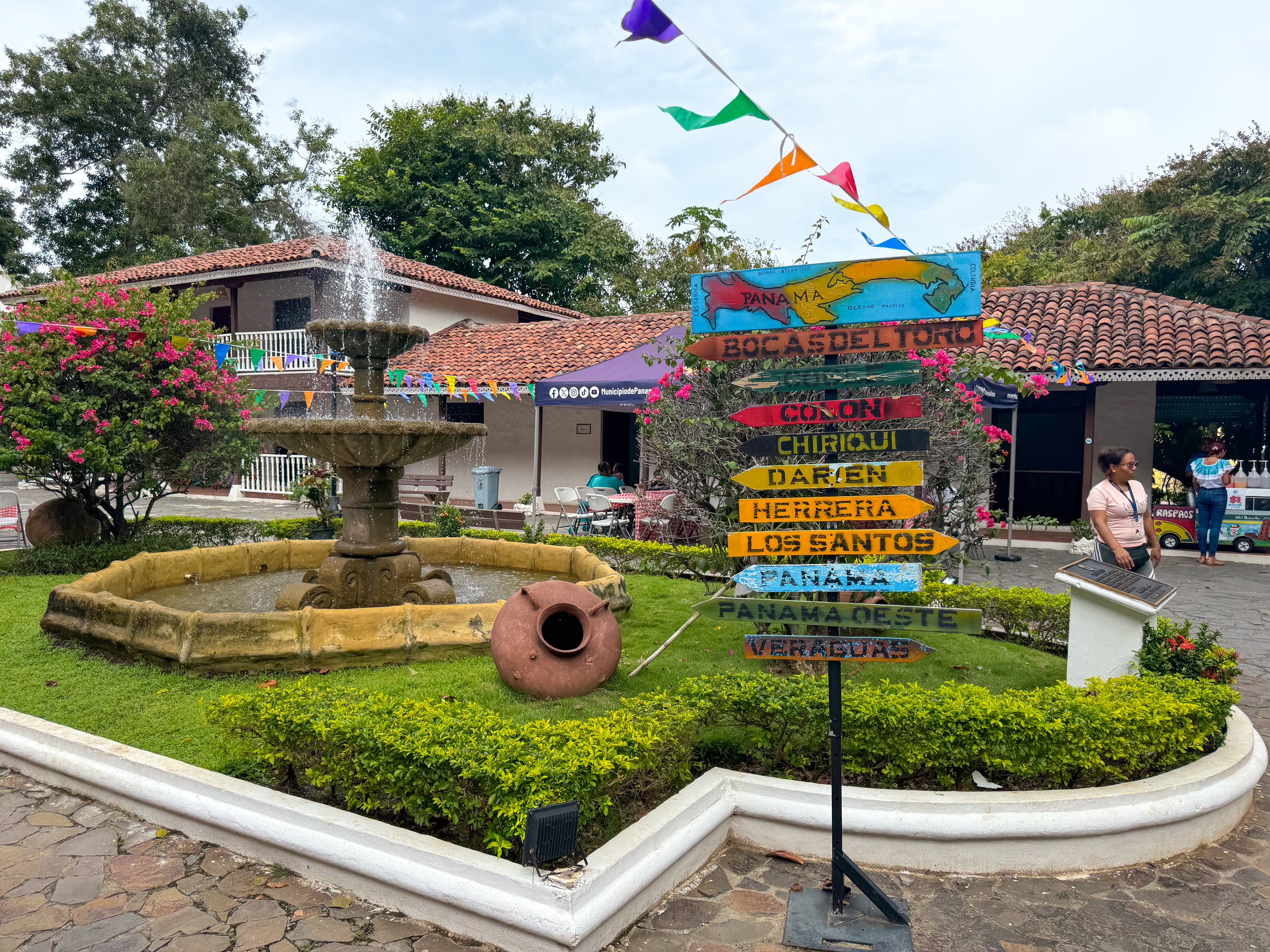
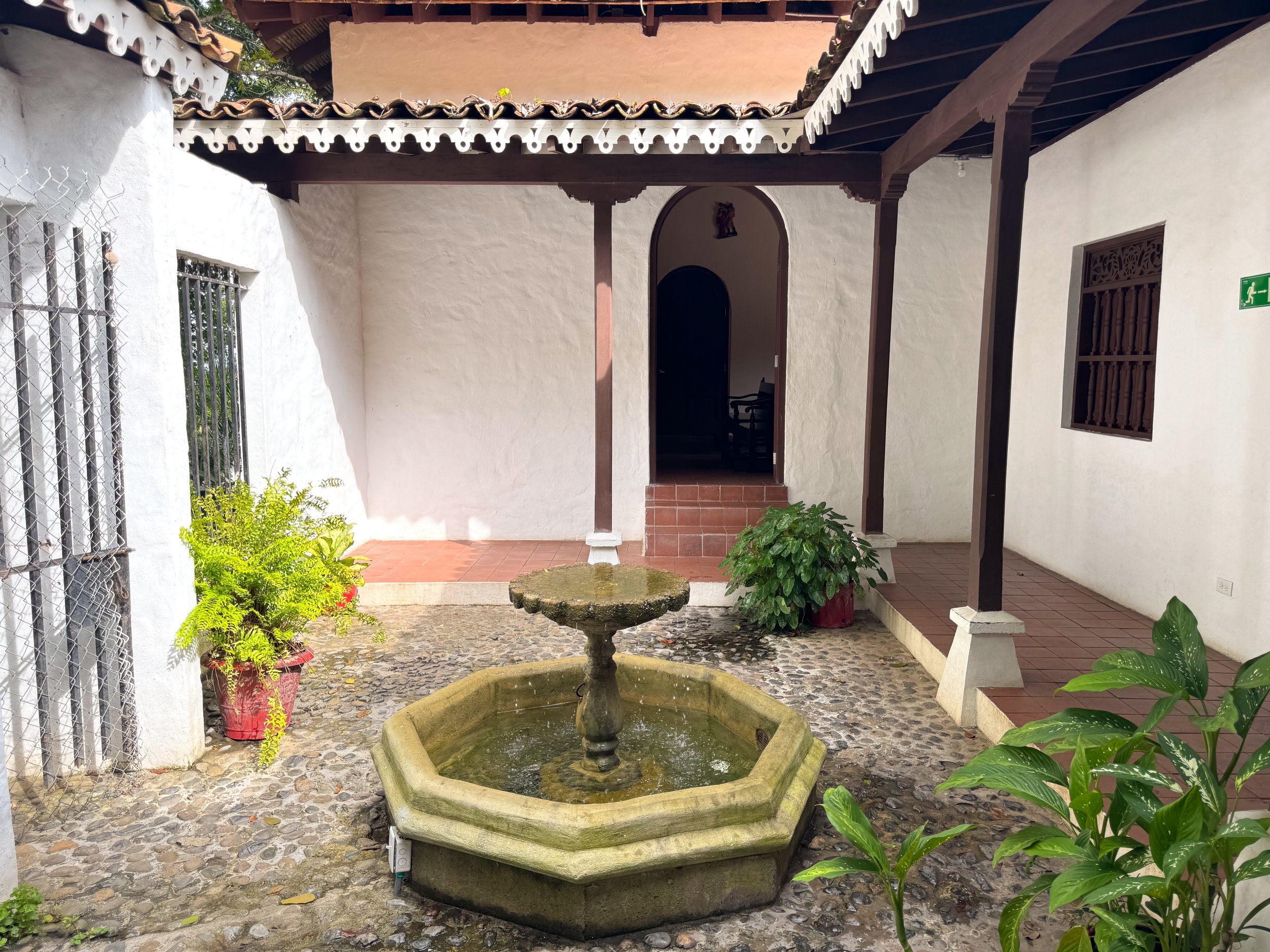
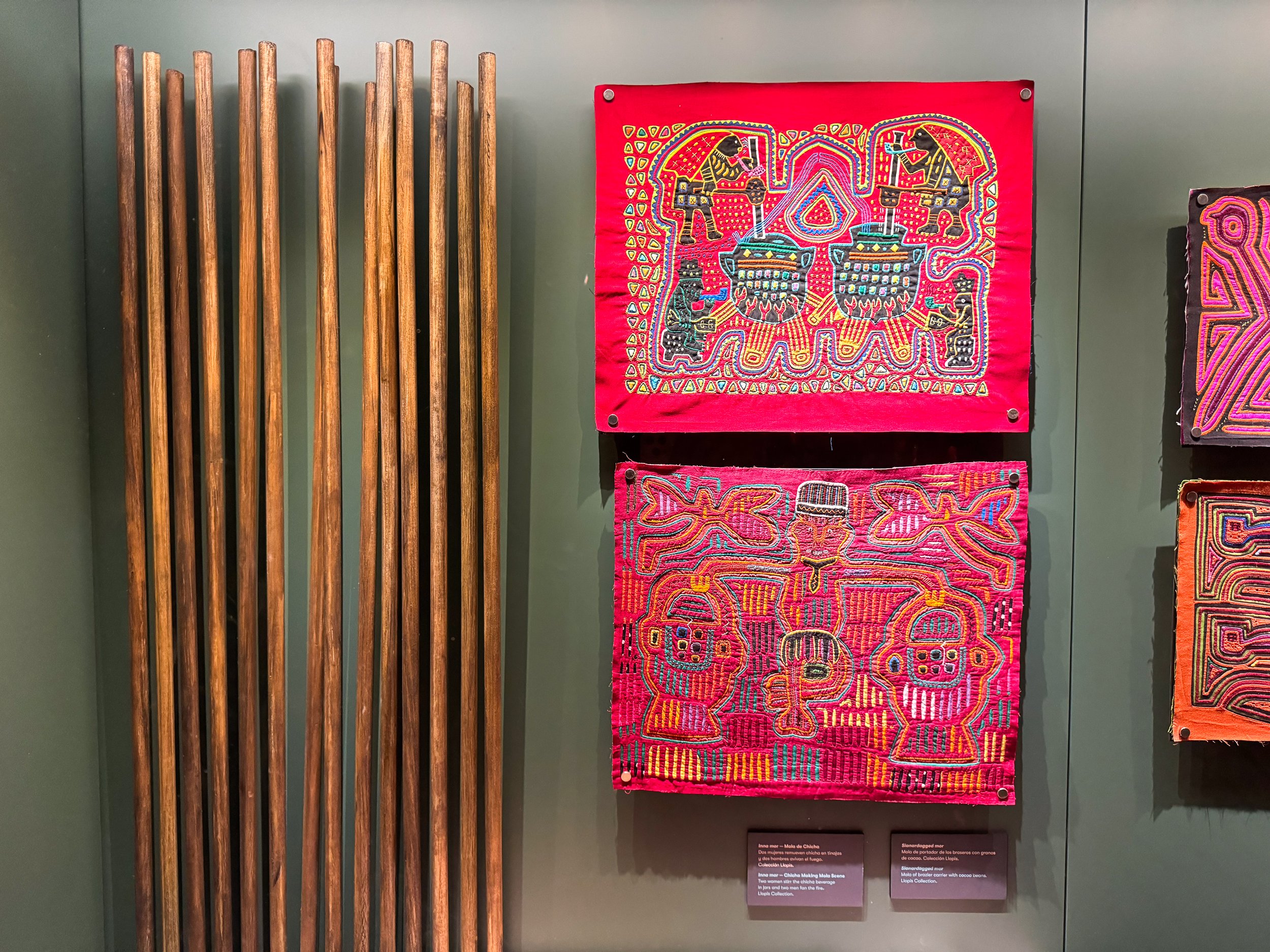
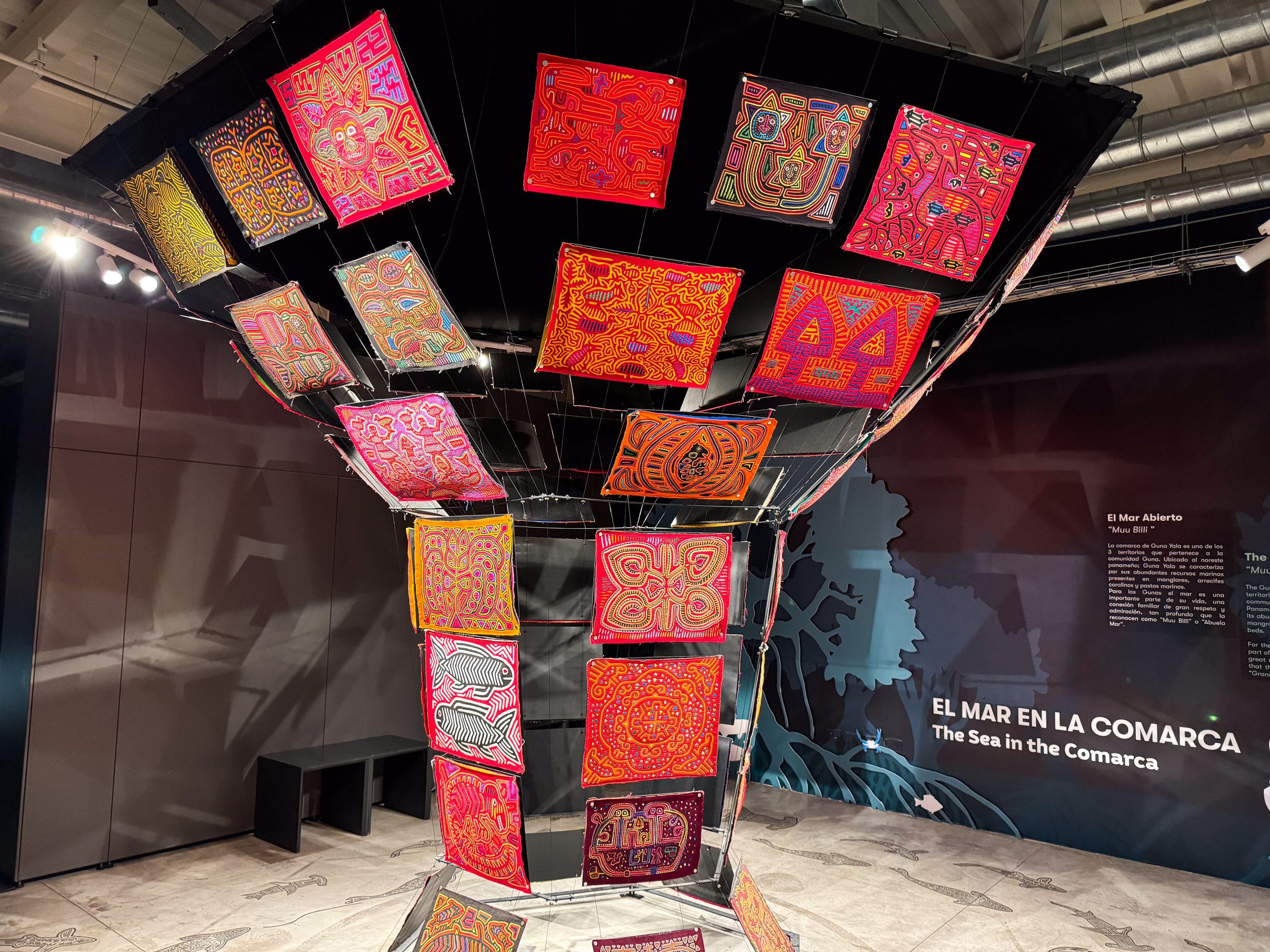
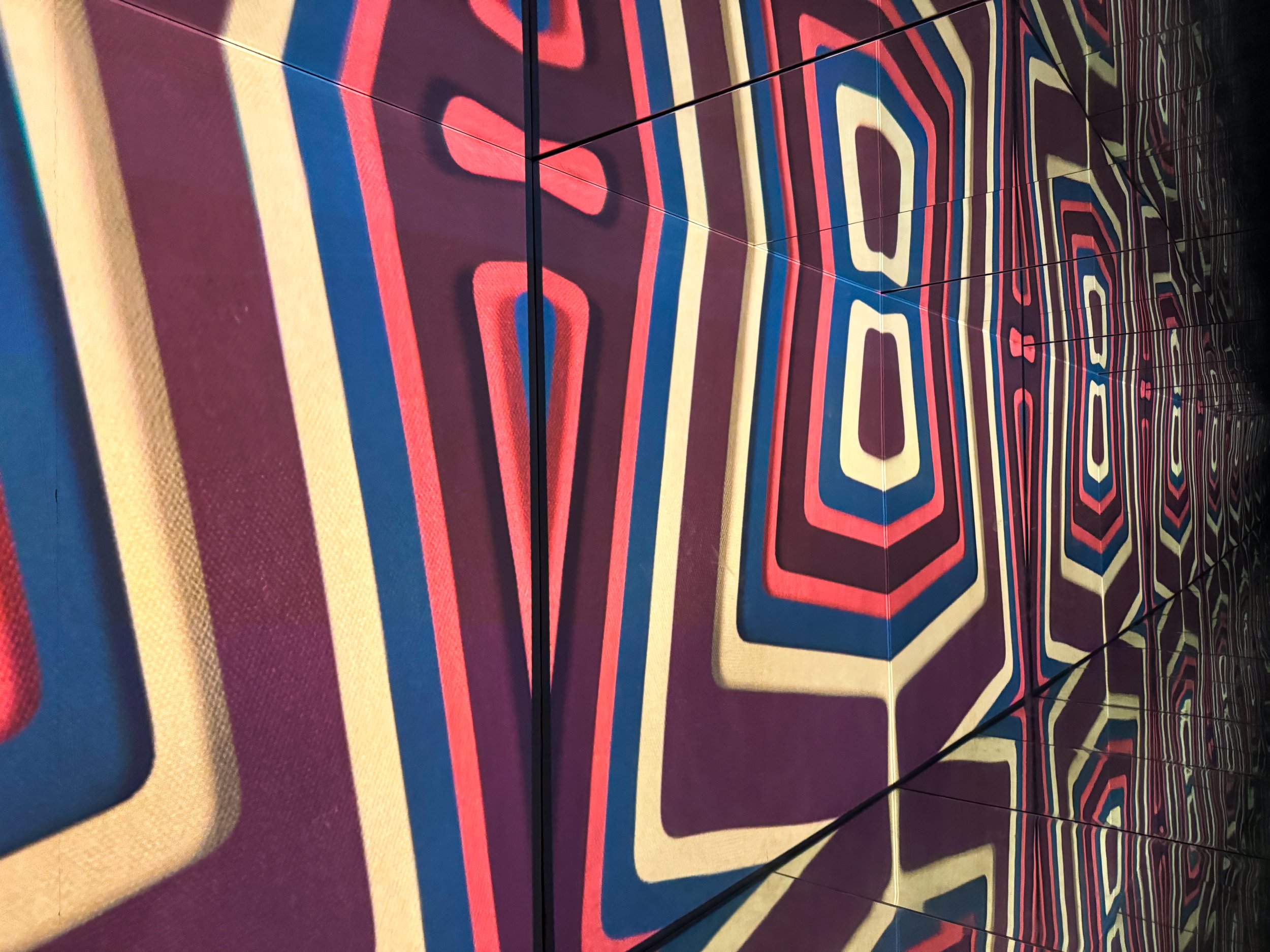
Museo de la Mola. A museum dedicated to the colorful and intricately patterned textiles made by Panama’s indigenous Guna Women. The well curated exhibit explains the cultural importance of the women and their textiles, how they’re handcrafted and the stories behind them. It also features an interactive sound and light exhibit, an origami station and a magnetic wall to add to the museum’s Mola. The museum is free to enter.
Museo de la Historia. A small history museum in Casco Viejo about the founding of Panama and its independence from Spain and Colombia, the diverse cultures that make up Panama and the history of the Panama Canal. Come to see one of Panama’s first ever flags, a constitutional manuscript, and the national anthem. It’s free to enter.
Mi Pueblito. An open air museum set up like small towns with reproductions of colonial buildings and a nature trail with reproductions of thatched structures from Panama’s indigenous tribes. When we visited, there were many food vendors set up selling local and local dishes and snacks.
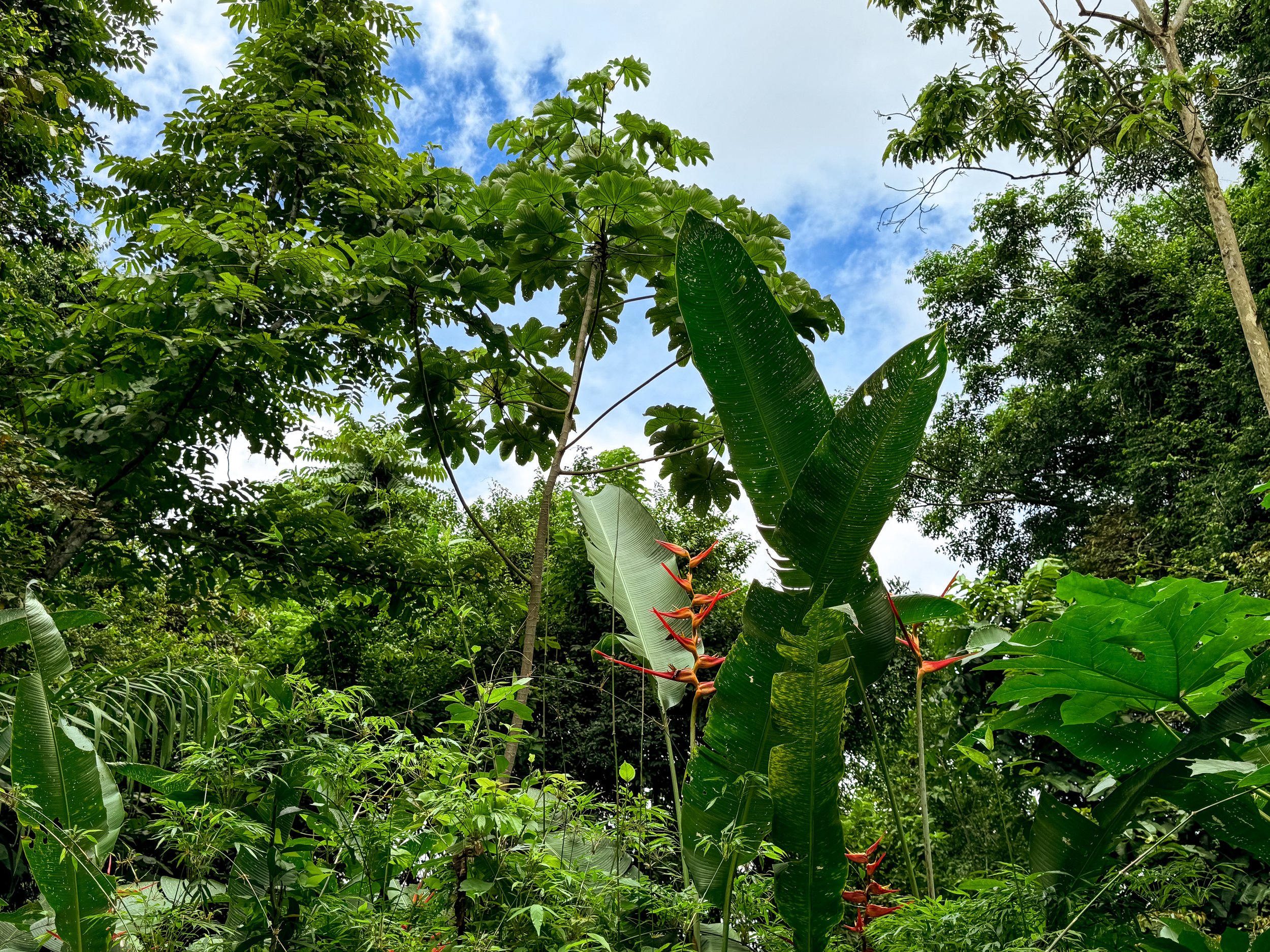

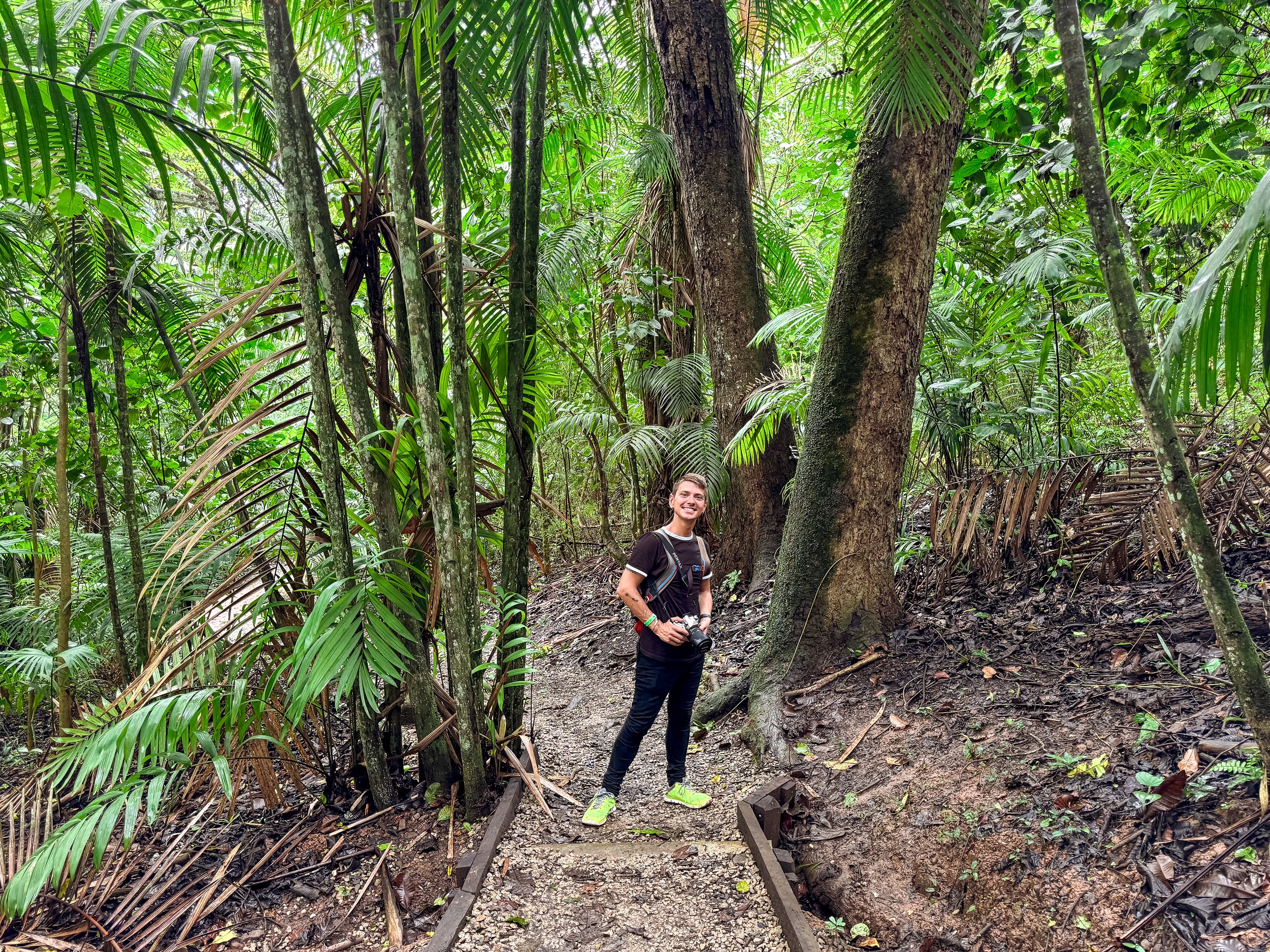
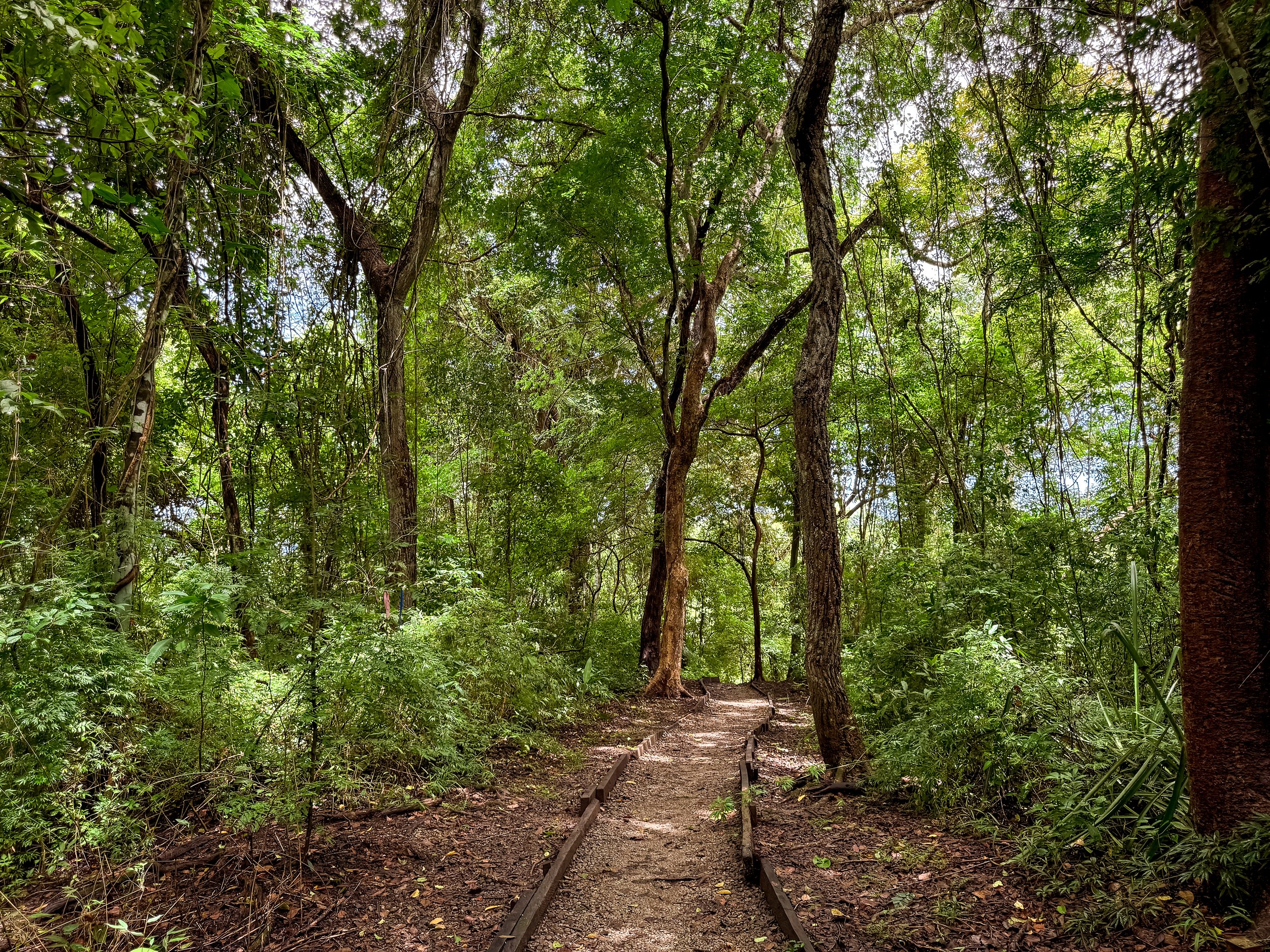
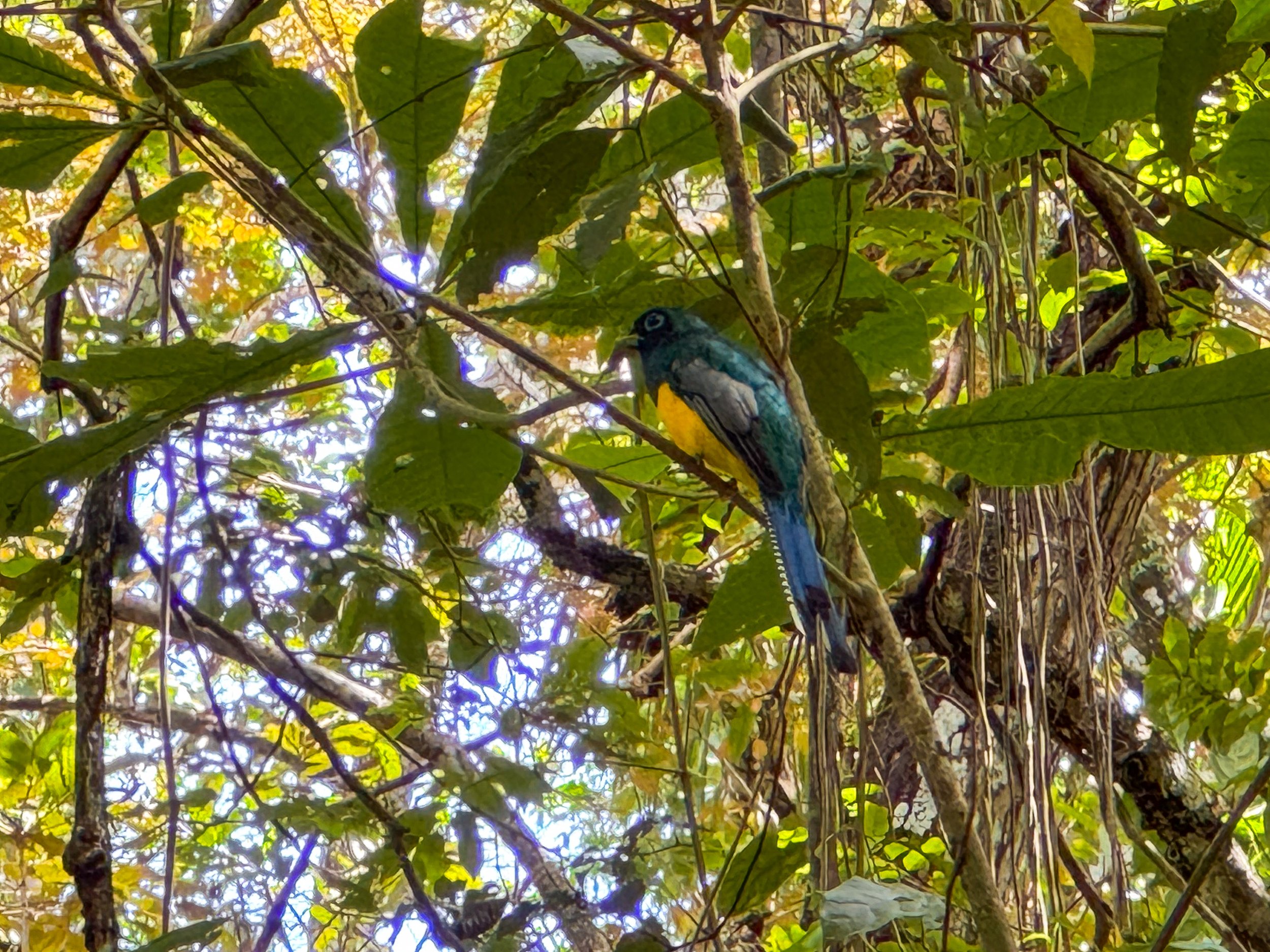
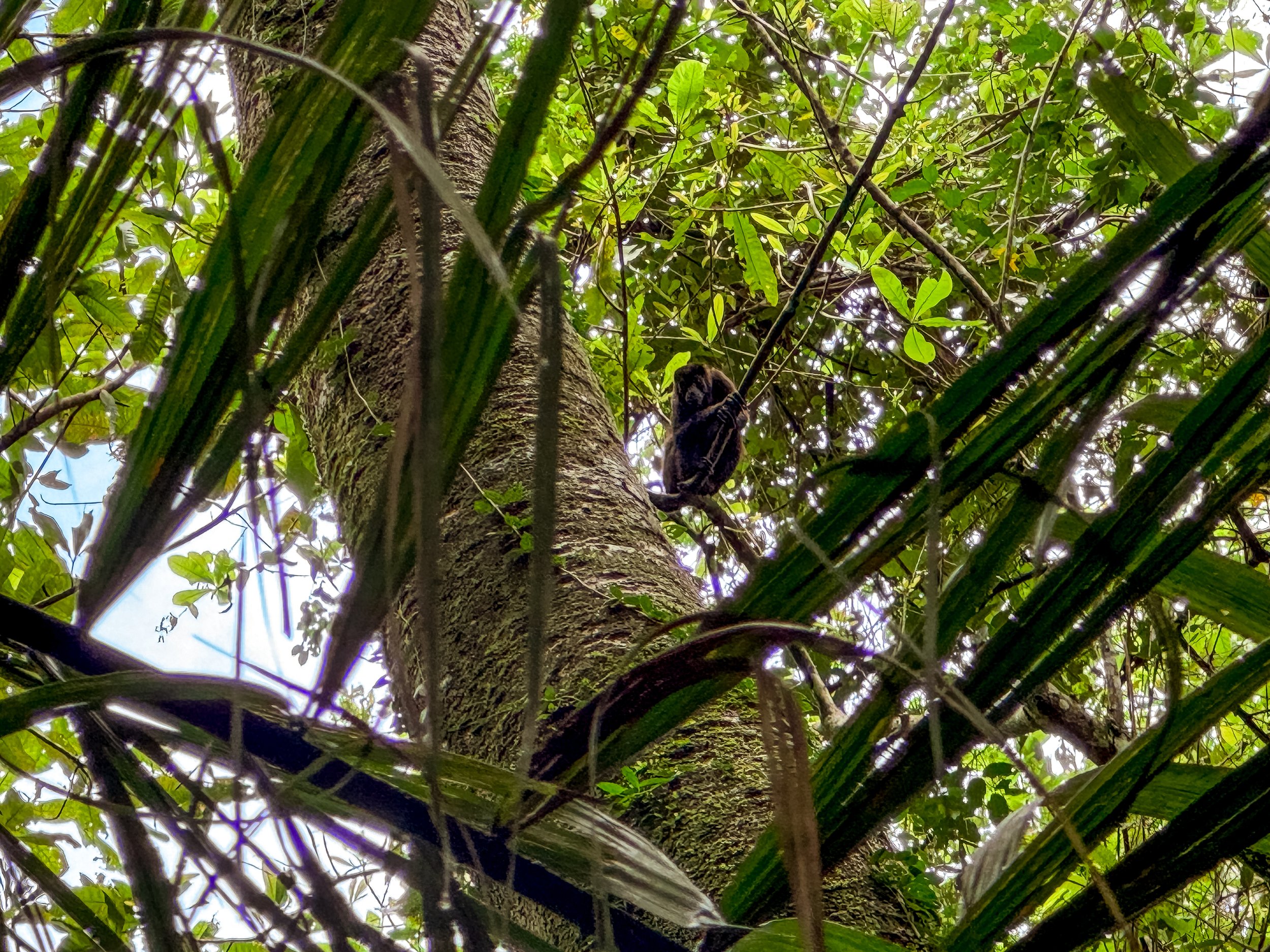
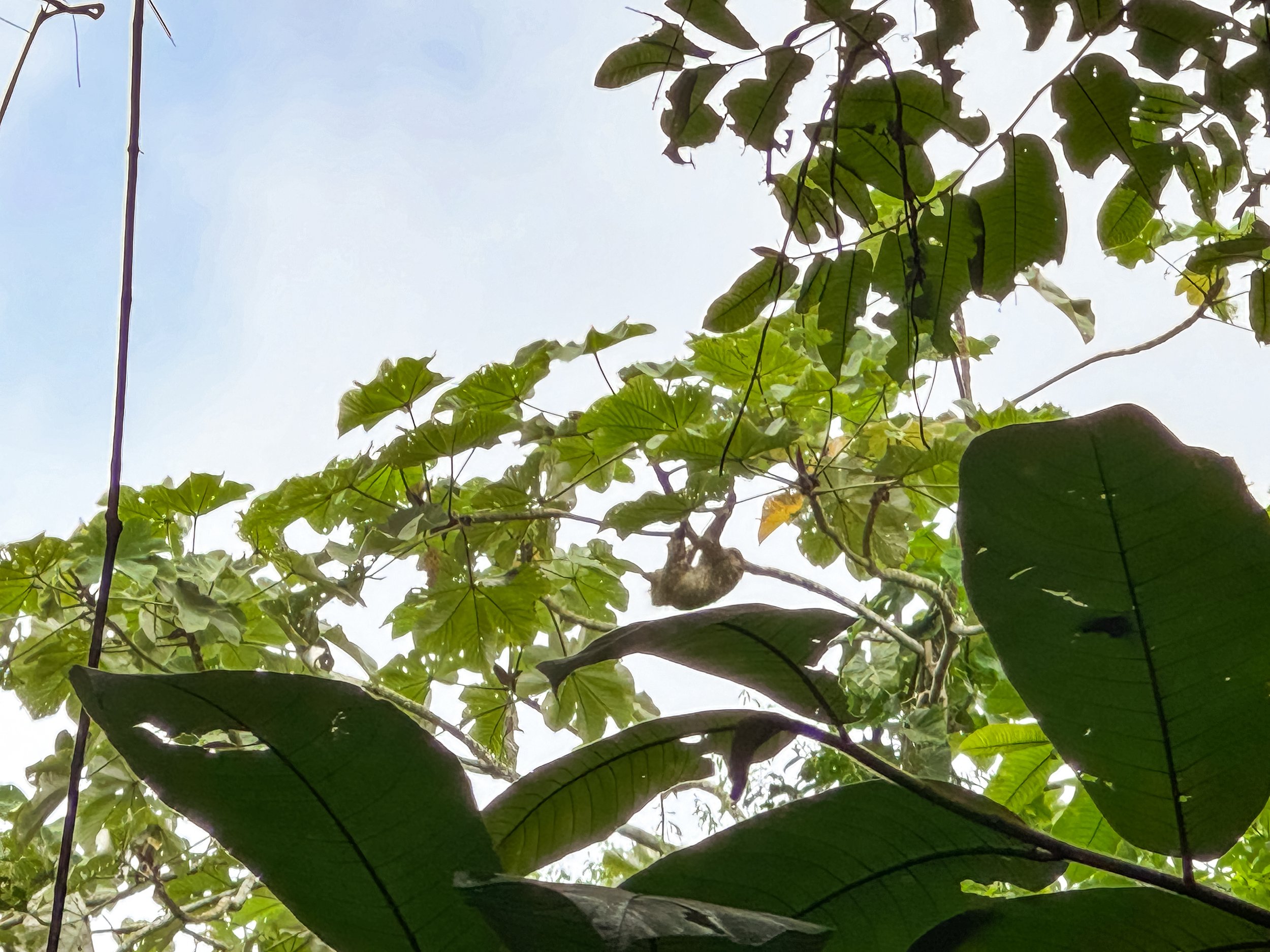
Parks
Parque Natural Metropolitano. A tropical nature park with hiking trails and scenic overlooks of Panama City’s skyline. Come here to spot monkeys, sloths, agoutis and humming birds. We spent over 3 hours walking the trails and spotting wildlife through our binoculars.
Trails
El Roble. A 0.7km trail and road leading from the visitor center to the Mono Titi trail
Camino de Mono Titi. A 1.2km trail through the forest ending with views of Panama City’s skyline.
La Cienaguita. A 1.1km trail through the lush forest leading from end of the Mono Titi trail back to the El Roble trail.
Los Caobos. A 0.8km trail branding off of the El Roble trail and ending at the Visitor Center. This trail passed through dense forest where we spotted monkeys, a sloth and agouti.
Getting Here: The park is reachable by bus one stop on the bus from Albrook Station. It can take a little over an hour to reach from Casco Viejo.
Cerro Ancon. A paved nature trail leading from Mi Pueblito to the city’s tallest natural point. Come here to overlook Casco Viejo, the city’s modern skyscrapers and ships passing through the Panama Canal.
Soberania National Park. A large national park in the center of the country located along the Panama Canal. We came here hoping to hike, spot wildlife and watch ships on the Canal.
Unfortunately after hours of trying to reach certain sights in the park via bus, on foot and Uber, we learned many of the park’s activities are run by private resorts with high ticket prices, require advance reservation or are inaccessible. Tired and a little defeated, we decided to return to Panama City and make the most of our day.
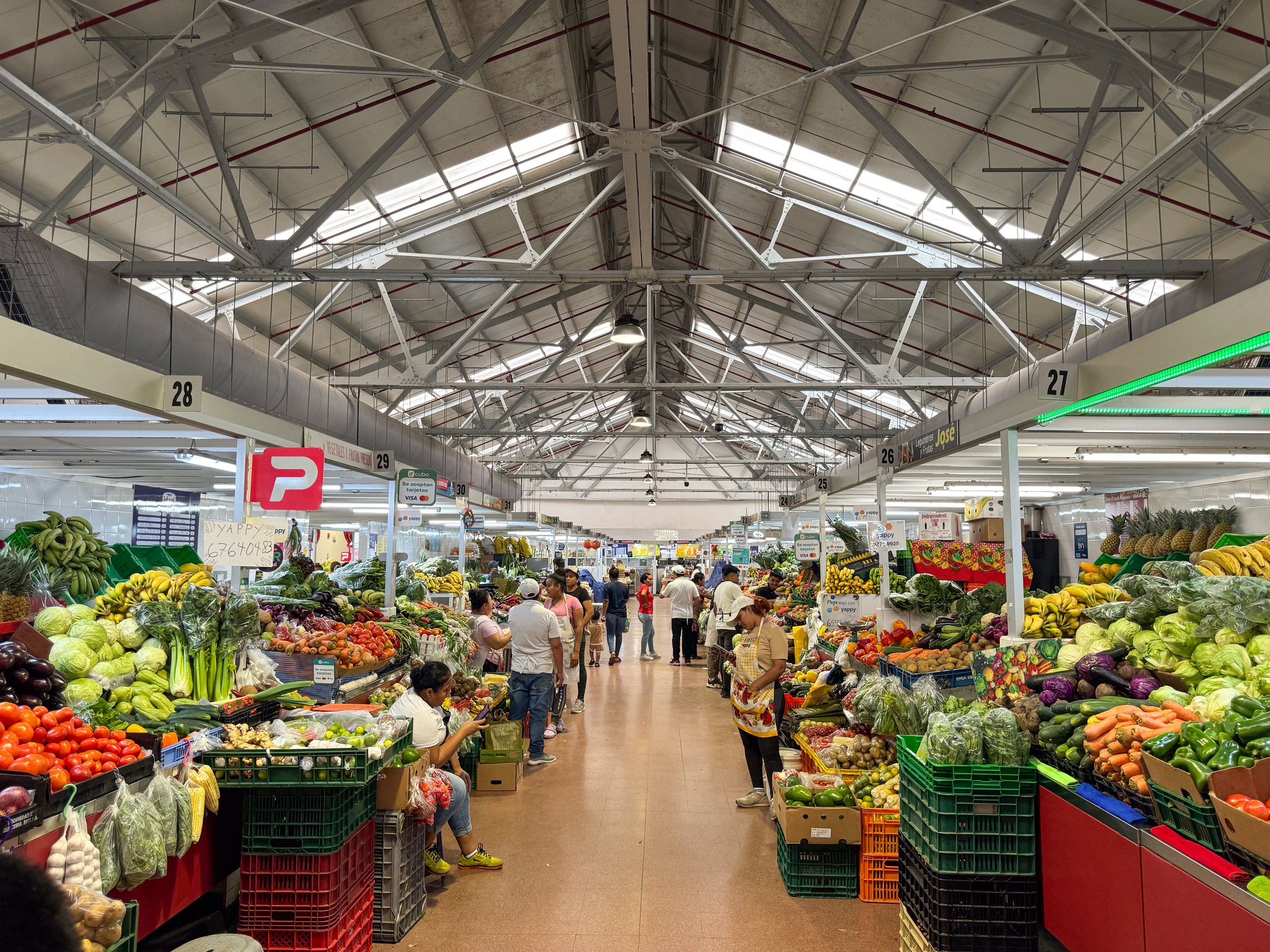
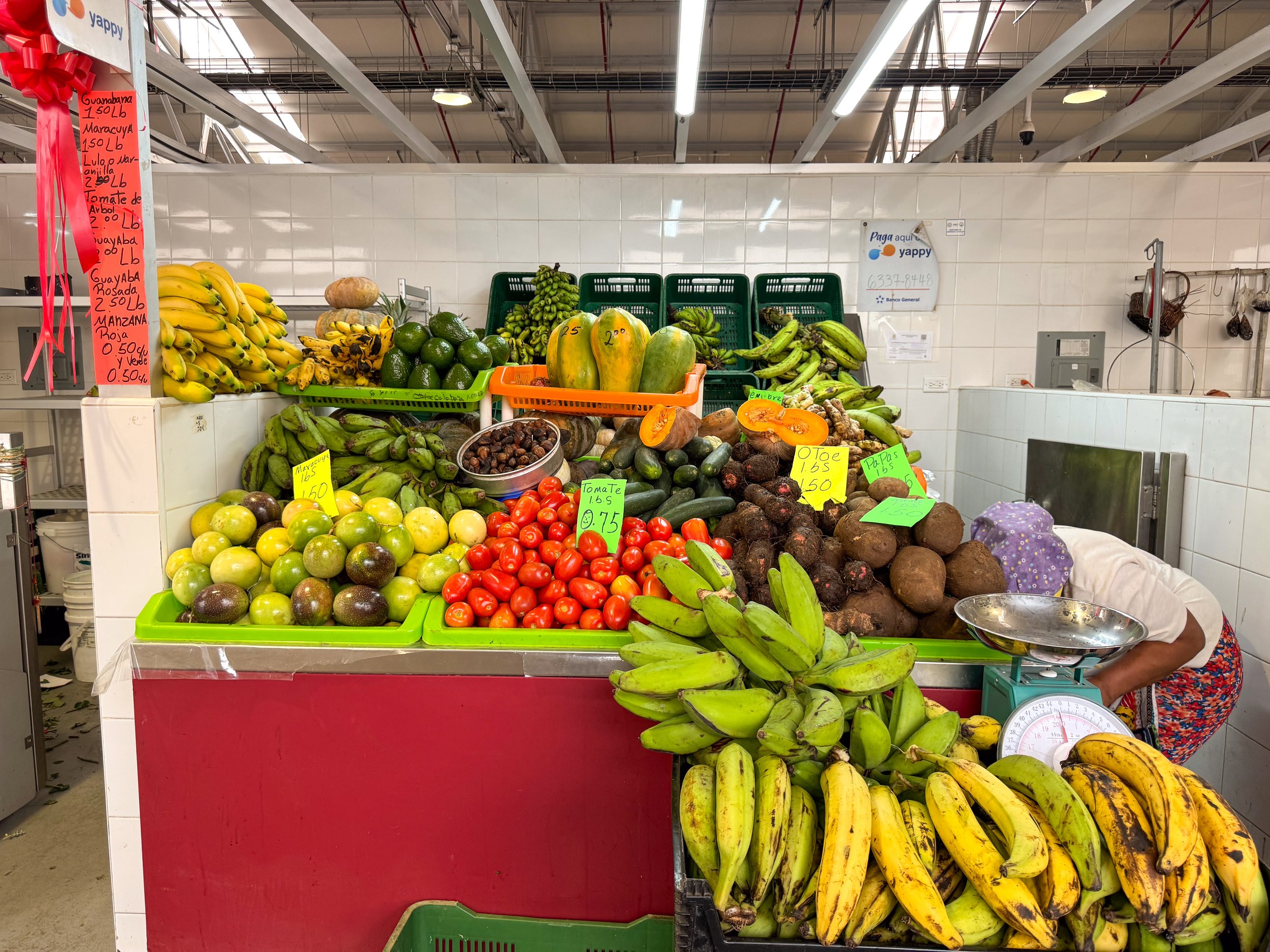
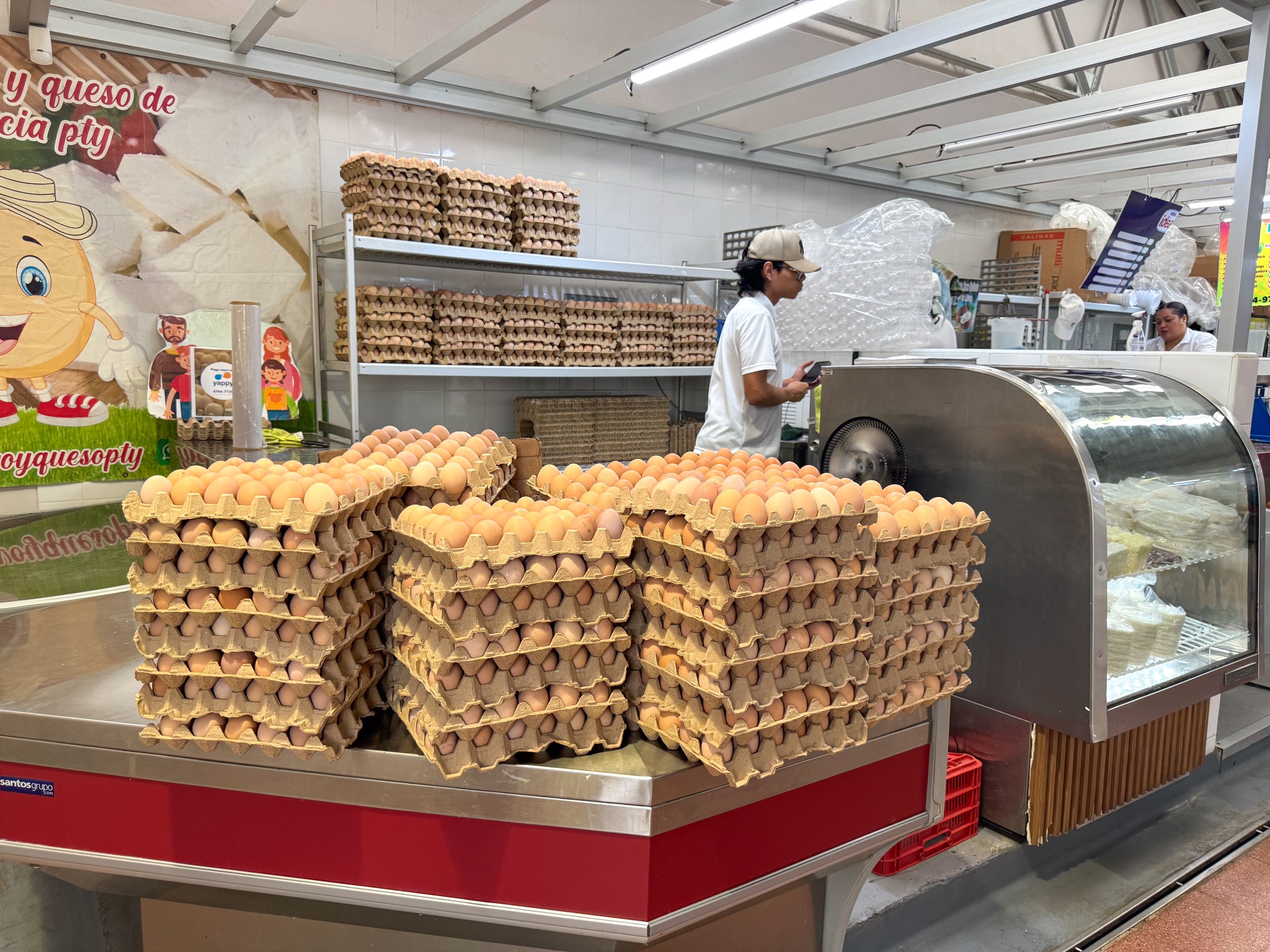
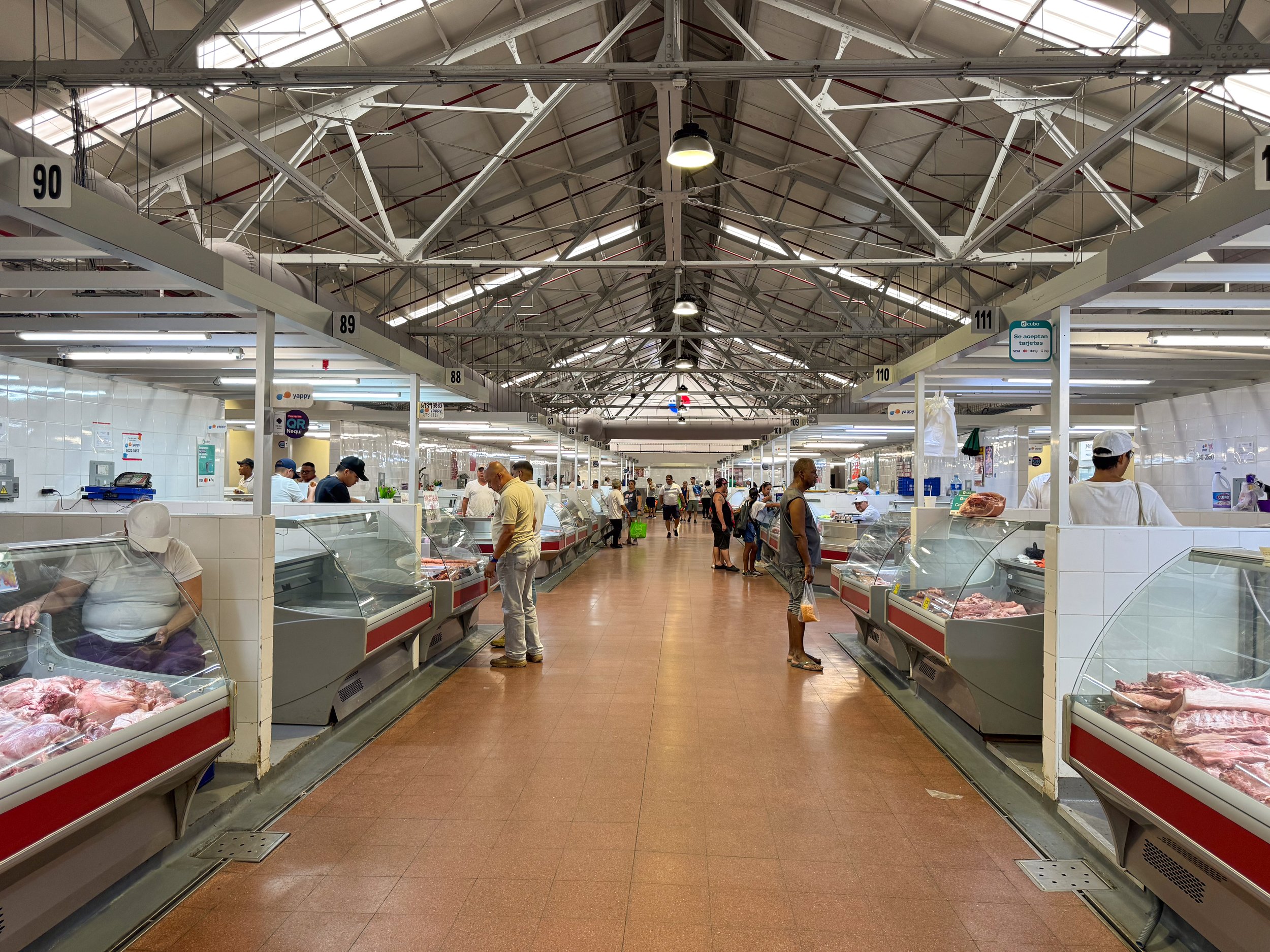

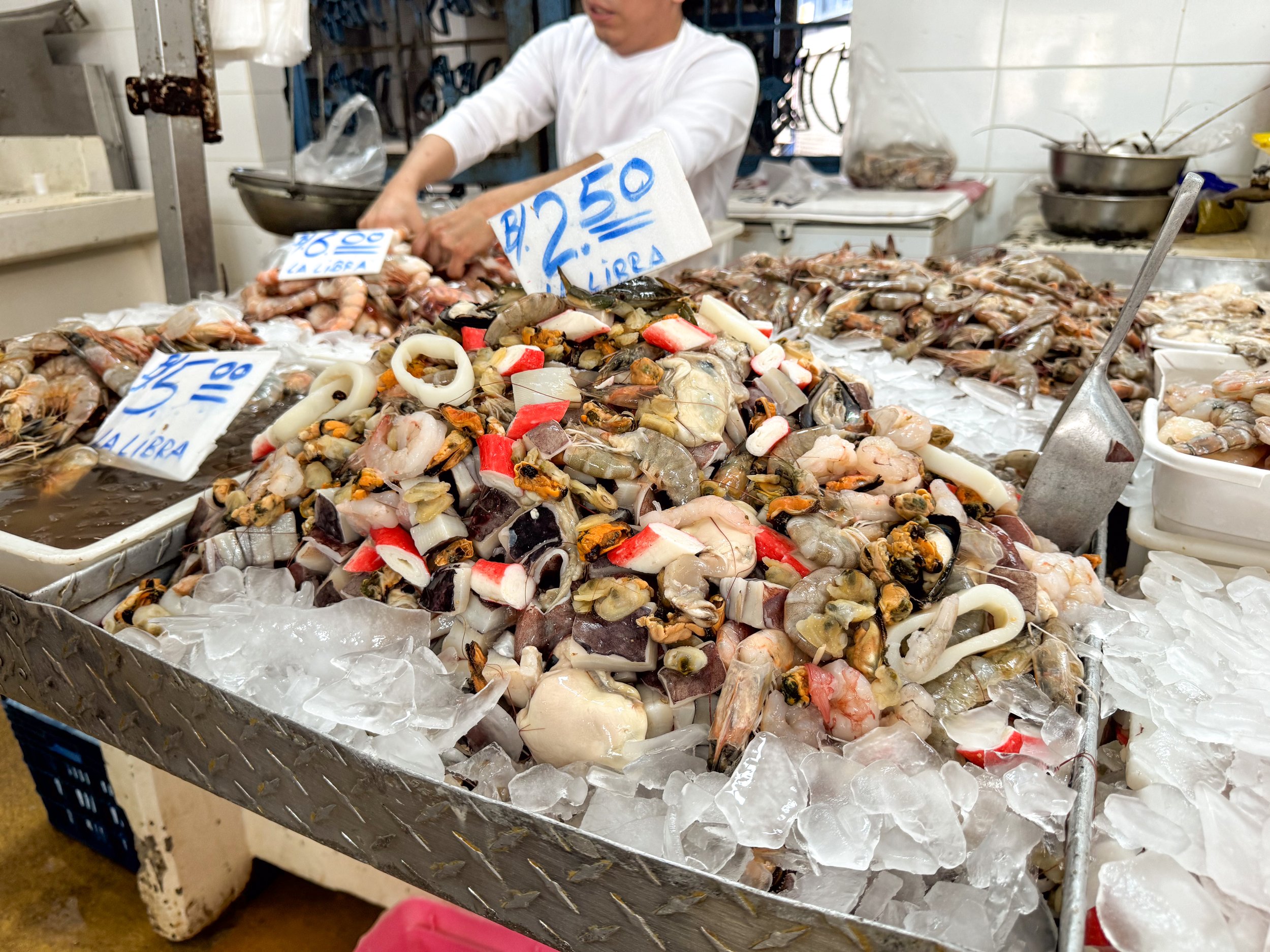
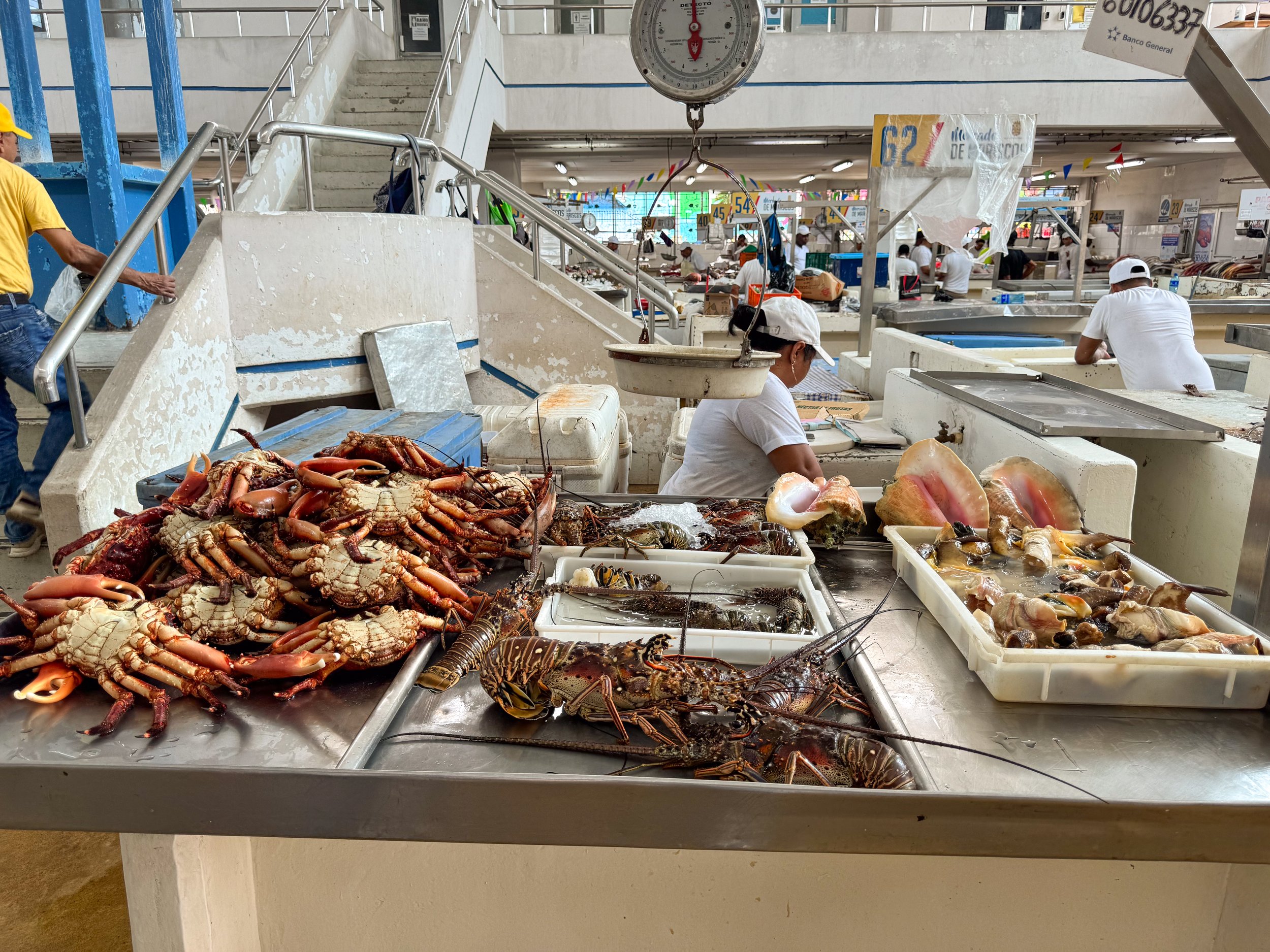
Markets
Mercado San Felipe Neri. A food market with butchers selling locally farmed meats and vendors selling locally grown produce, fruits, eggs, grains, herbs, oils and juices. We shopped for a week’s worth of groceries to cook with at our Airbnb.
Mercado de Mariscos. A seafood market with vendor selling piles of whole fish on ice, trays of shrimp, live crab and lobster, queen conch and mixed seafood. We bought a 2 lb Corvina, Panama’s favorite fish, and fried it in traditional methods. Opposite of the market is a second building with restaurants and vendors cooking up the day’s fresh catch. Here we ordered Caribbean shrimp, coconut rice and locals beers from Restaurante Allison.
Avienda Central. A pedestrian street stretching from Cinco de Mayo station to Casco Viejo with commercial shops, grocery stores, restaurants, cafes and street vendors selling produce, especially plantains stacked on tables and pineapples in the backs of trucks.

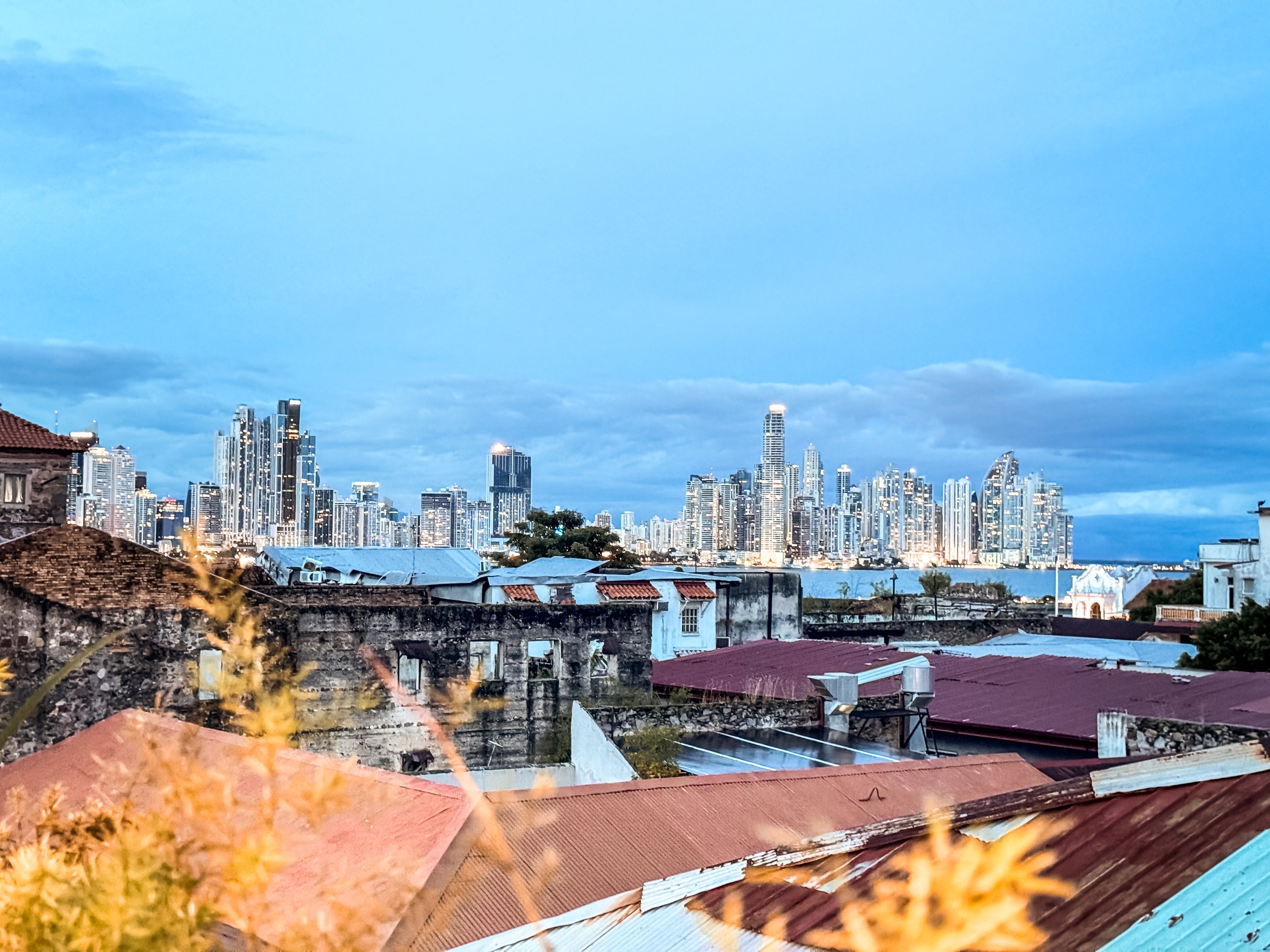
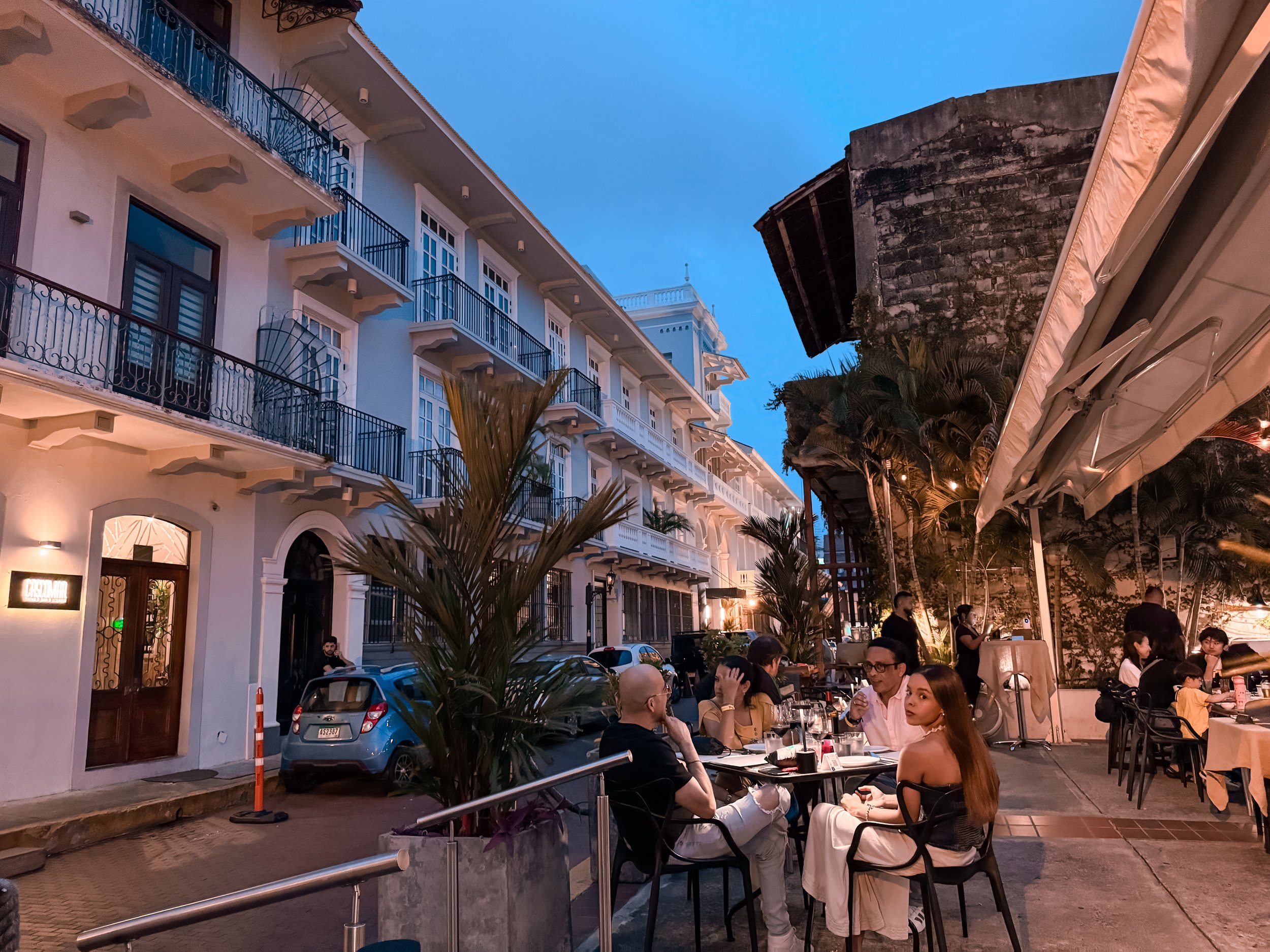
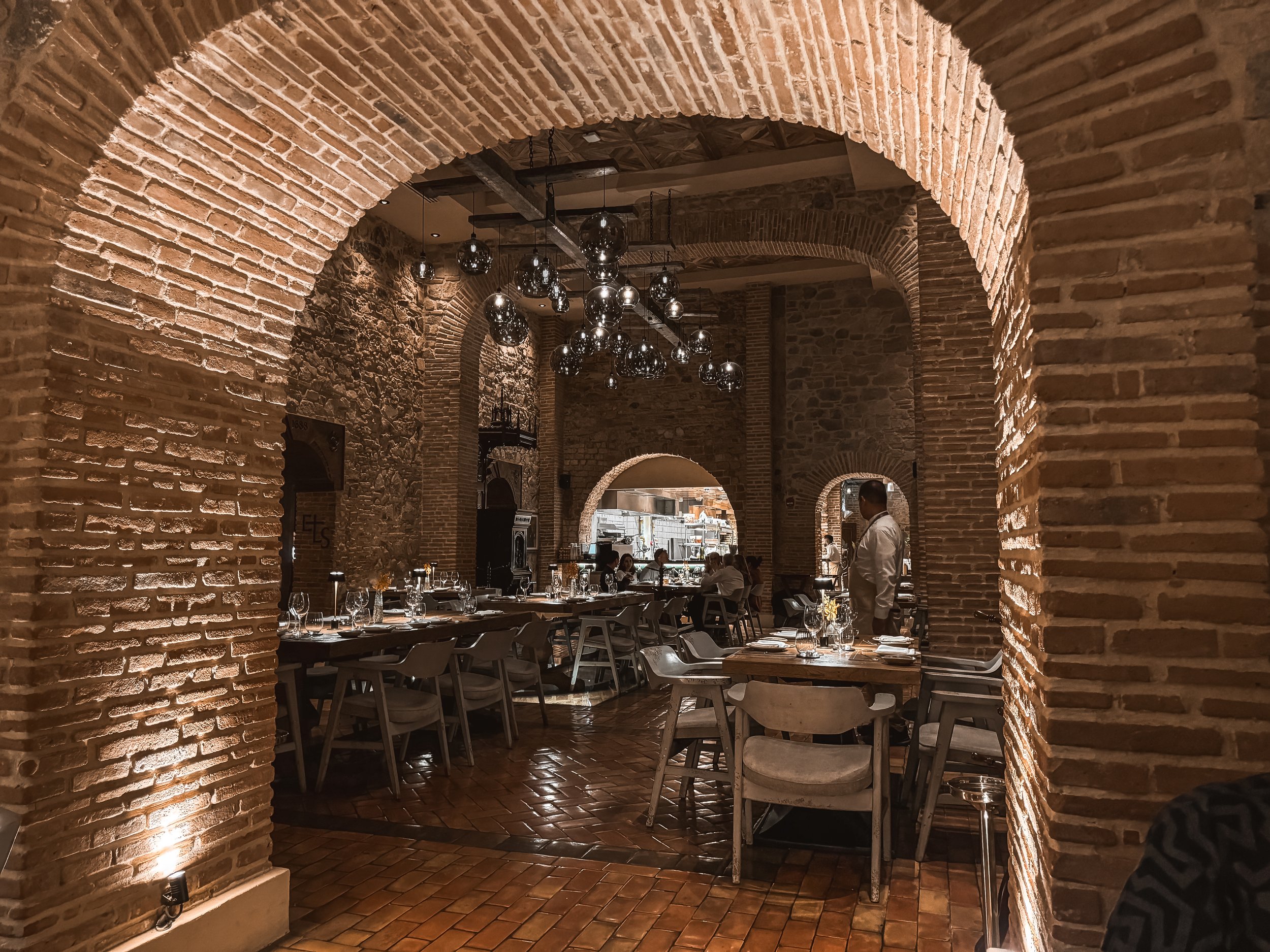

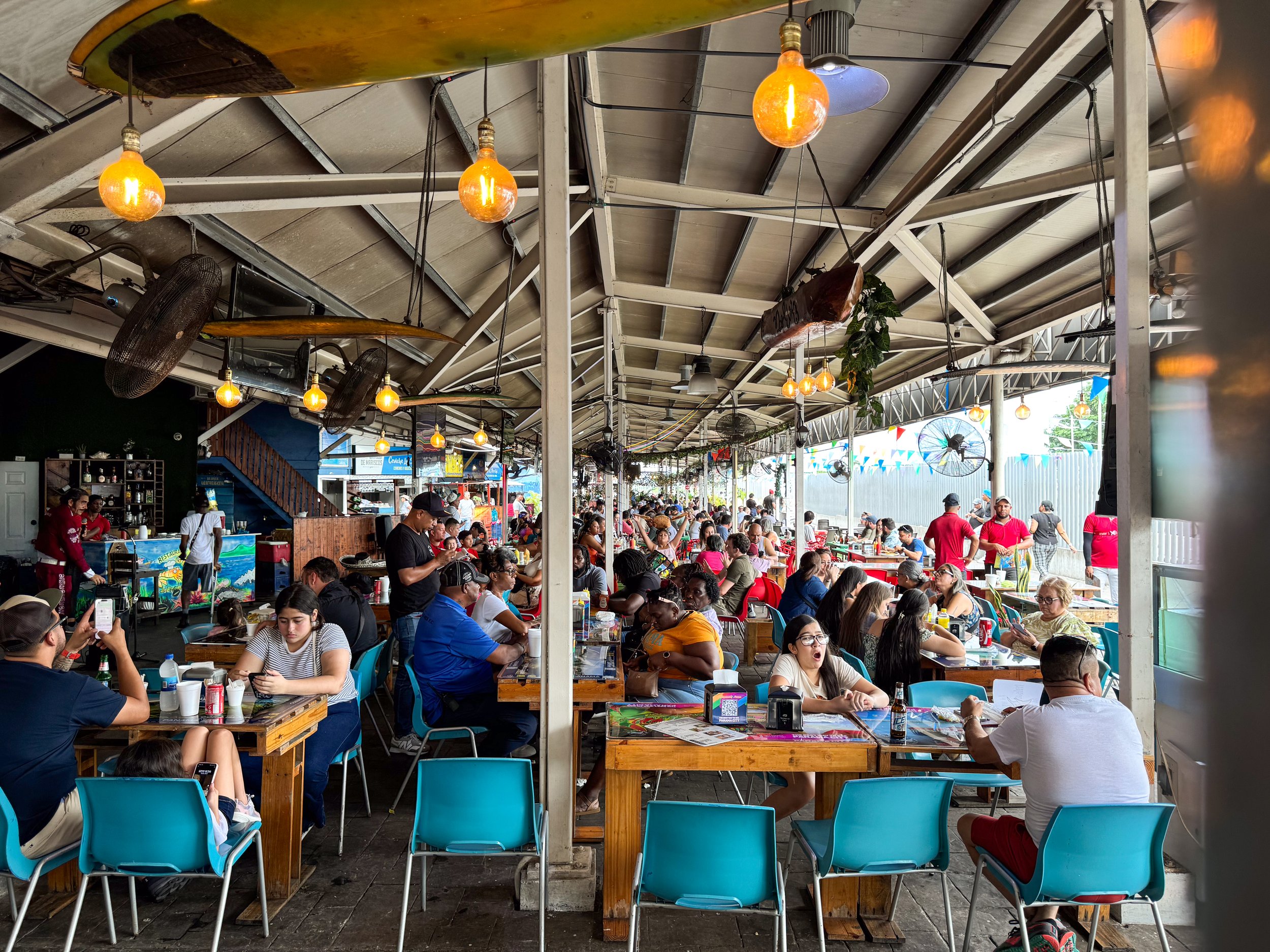
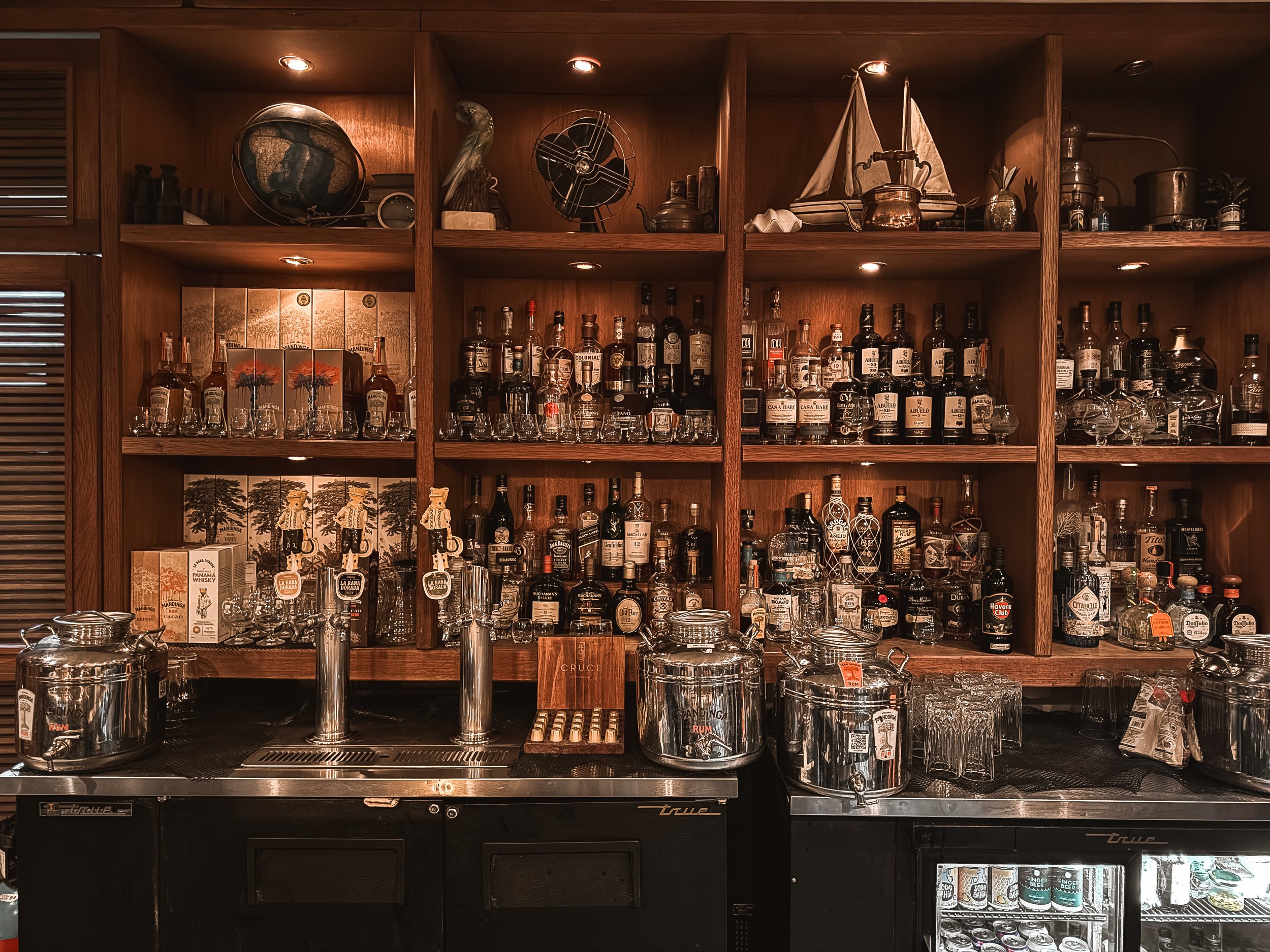
Where to Eat & Drink
Casco Mar. A restaurant along the seaside of Casco Viejo with a Spanish style tapas and paella menu. We sat outside listening to the waves and sounds of the city. To eat, we shared the plantains, passion fruit ceviche, white fish stuffed peppers, coconut flan and the most refreshing mojitos.
El Santuario. A very romantic and higher end restaurant built within the ruins of a former monetary. The interior is defined by its exposed stone walls, brick arches, high ceilings, terracotta tiled and patterned wood floors. The menu specializes in Panamanian and Spanish dishes. We shared a seafood paella with scallops, langoustine, mussels and calamari. To drink, we each ordered a glass of red sangria.
Snack Shack. A beautiful restaurant in Casco Viejo. W ordered a breakfast bowl of tropical fruits (mango, pineapple, banana and papaya) with a coconut cream sauce as well as a traditional breakfast with fried eggs, toast, potatoes and avocado. There is a Tiki Bar in the garden area at the back of the restaurant.
Café Unido Casco Viejo. An old town coffee shop and cafe with Panama grown and roasted beans.
Vista Corona Panama. A tropical rooftop restaurant and bar with palm trees, tiki torches, house music, a bar built from a VW bettle and views of the old towns rooftops and spires. We came here to relax with a cocktail after a long day of hiking and busing. Try the rum cocktails like an Old Cuban and Tobaga.
Tantalo Rooftop Bar. A rooftop bar in Casco Viejo with cocktails and local beers. We came here for sunset drinks overlooking the city’s terracotta roofs, cathedral towers and modern skyscrapers across the bay. Fittingly, we ordered a drink called, Noche en el Casco (Night in The Old Town).
Pedro Mandinga Rum Bar. A warmly lit rum bar with a wooden interior and old world charm. The bar features rums from countries across the Caribbean and Central America including Panama and their own distillations. Try a glass neat, order a flight of rums, a classic cocktail or
VIP. A boutique and juice bar connected to Monos con Arte. Order a fresh Pepa Fria (cold coconut) to enjoy while walking around the old town.
Where to Shop
Casco Viejo is a very fashionable place with well dressed locals and tourists, boutiques and clothing shops selling Panama hats, linen clothes, colorful outfits and items made with tropical patterns and natural materials.
Boho Shack. A resort style street wear boutique with patterned shirts, shorts and pants. We bought a palm embroidered linen shirt! We’ve also visited their location in Cartagena where the brand is based.
Bellezas de Panama. A shop selling Panama hats, hand woven Molas and various souvenirs. We found this location to have the best selection and most affordable authentic Panama hats. The typical price is $40-$45 but the shop owner sold ours to us for $30.
Mansion Herrera Clothing Shop. A boutique clothing shop with elegant linen clothes and custom Panama Hats.
Lu Maca Coffee Shop & Store. A cafe and clothing store with tropical shirts, accessories and a small selection of Panama Hats.
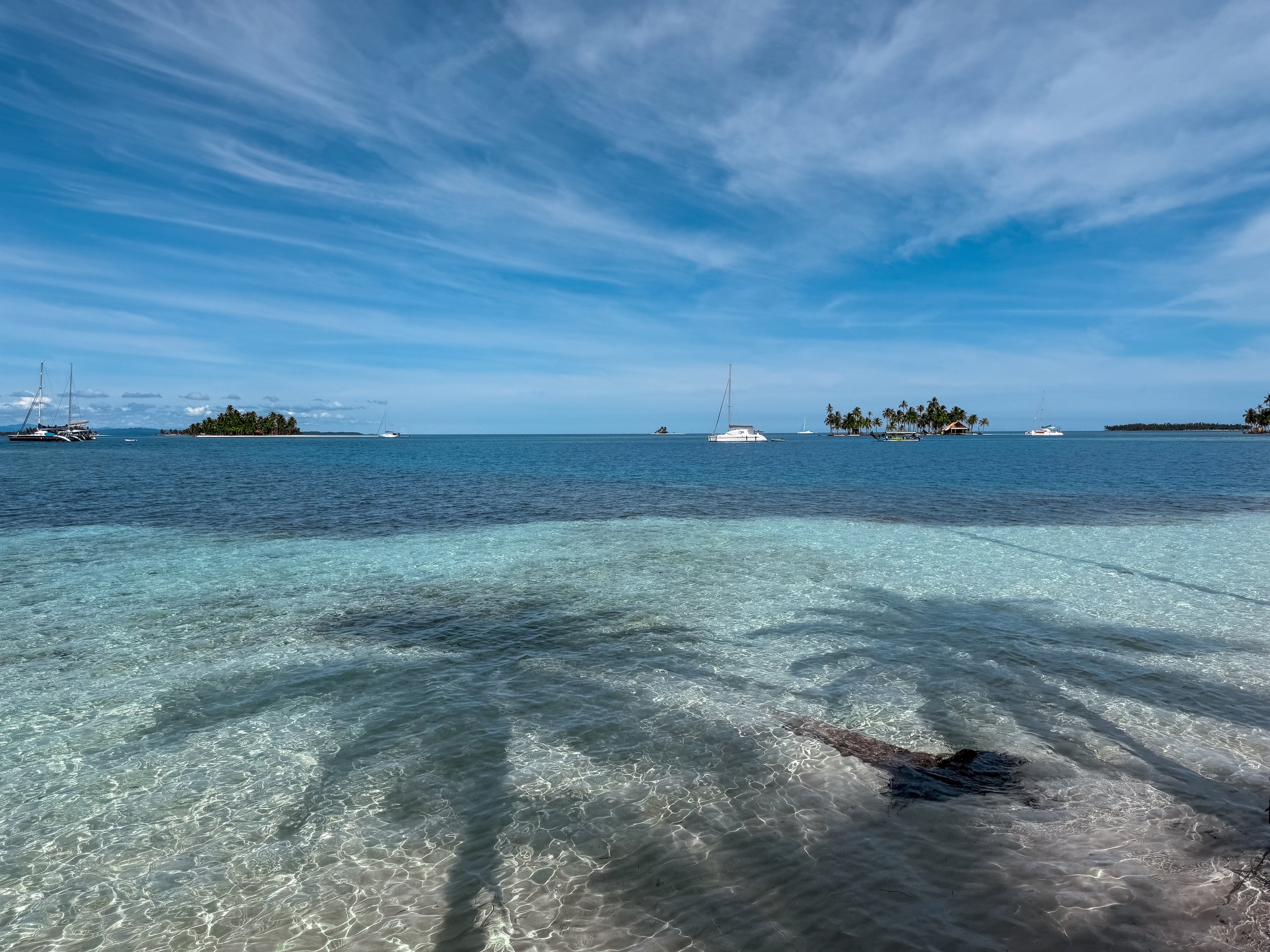
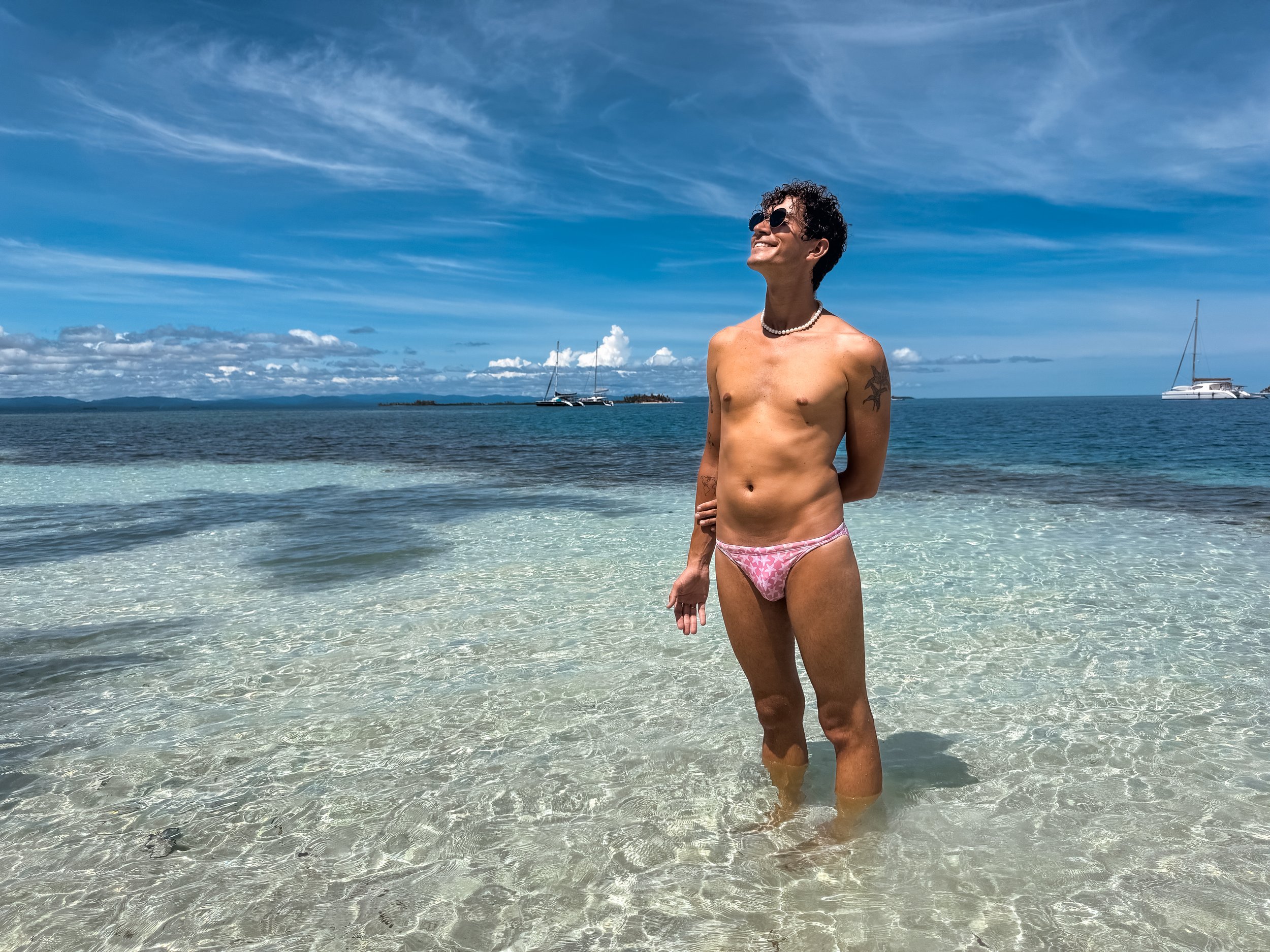

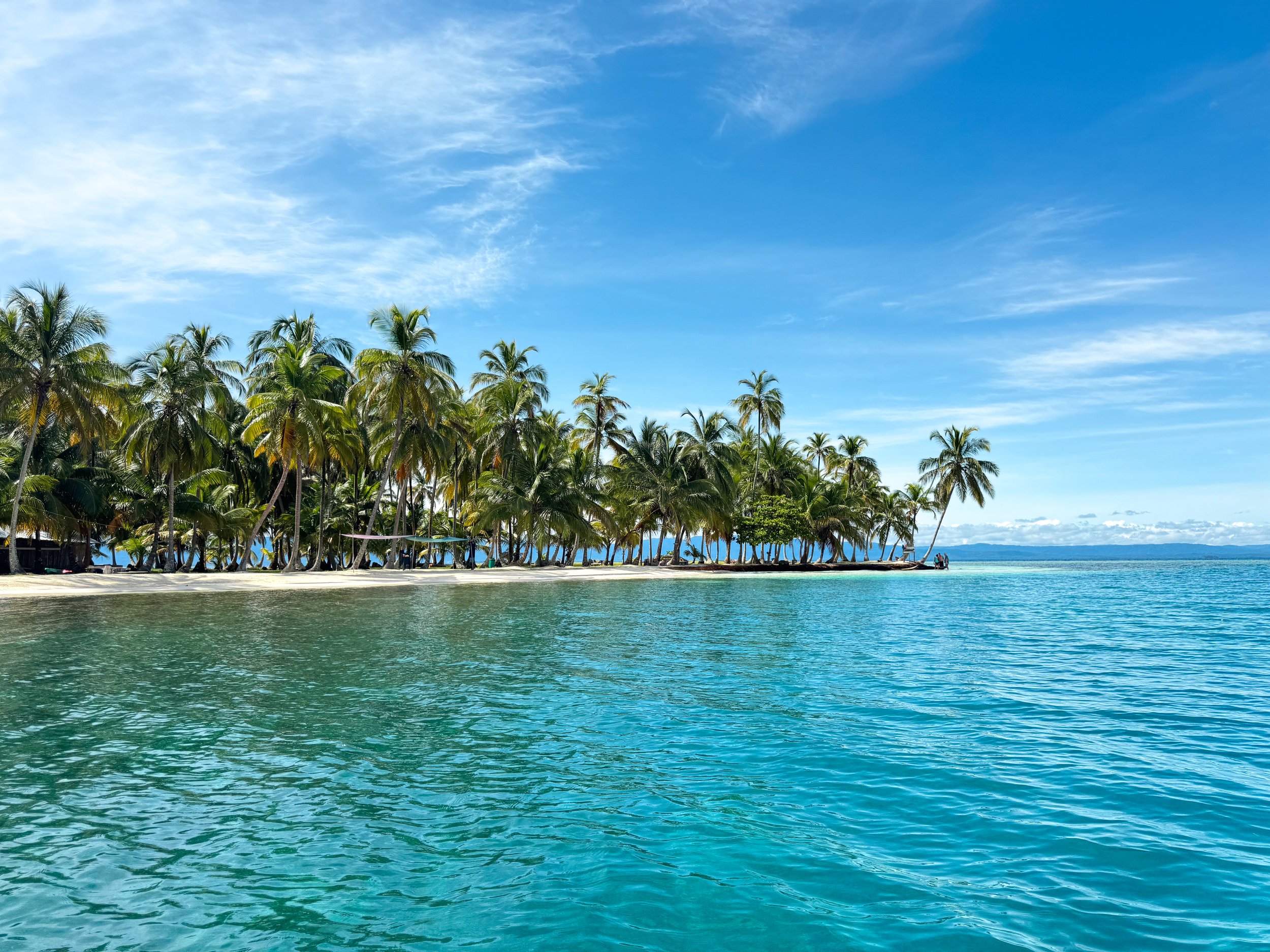
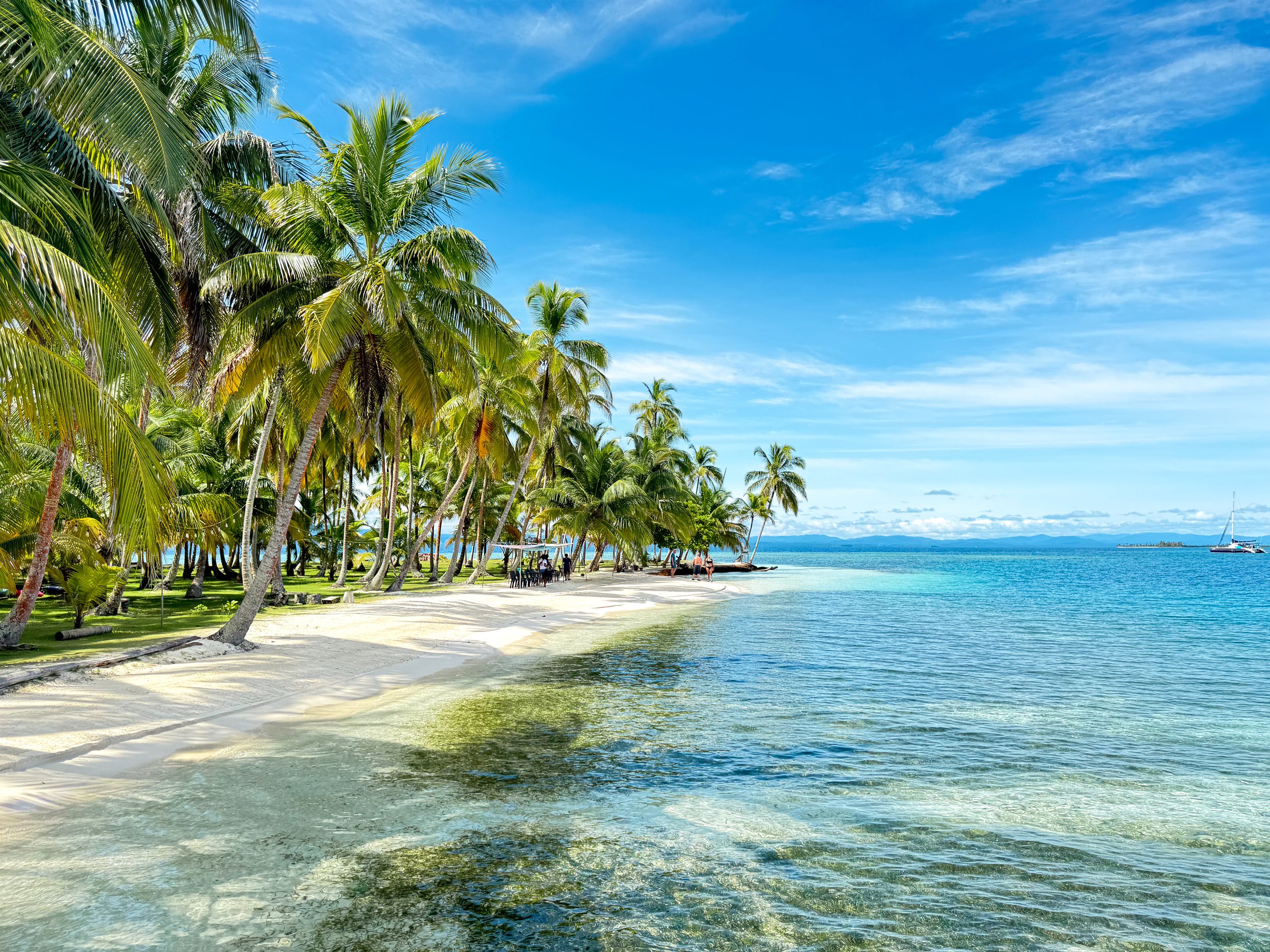
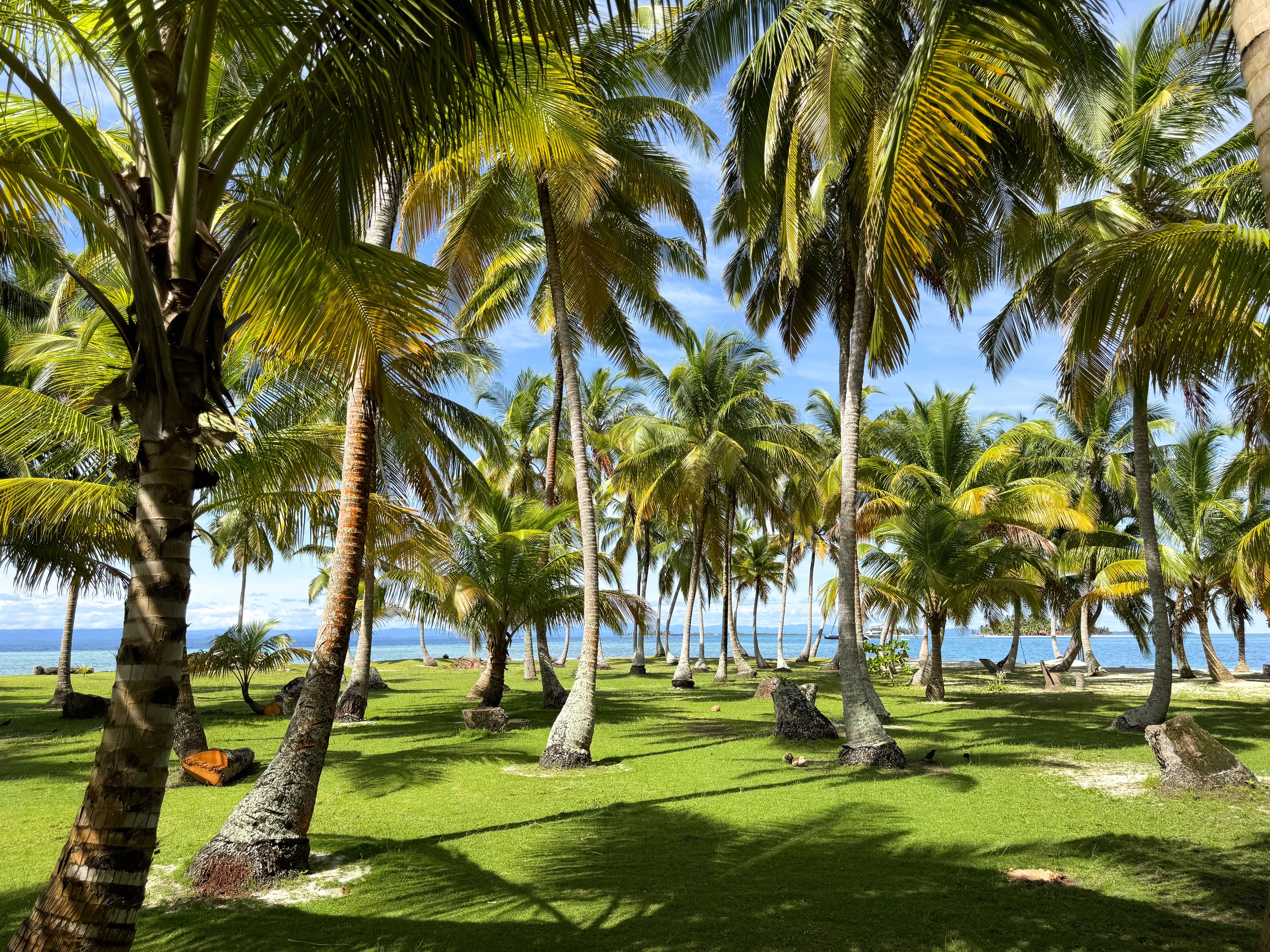
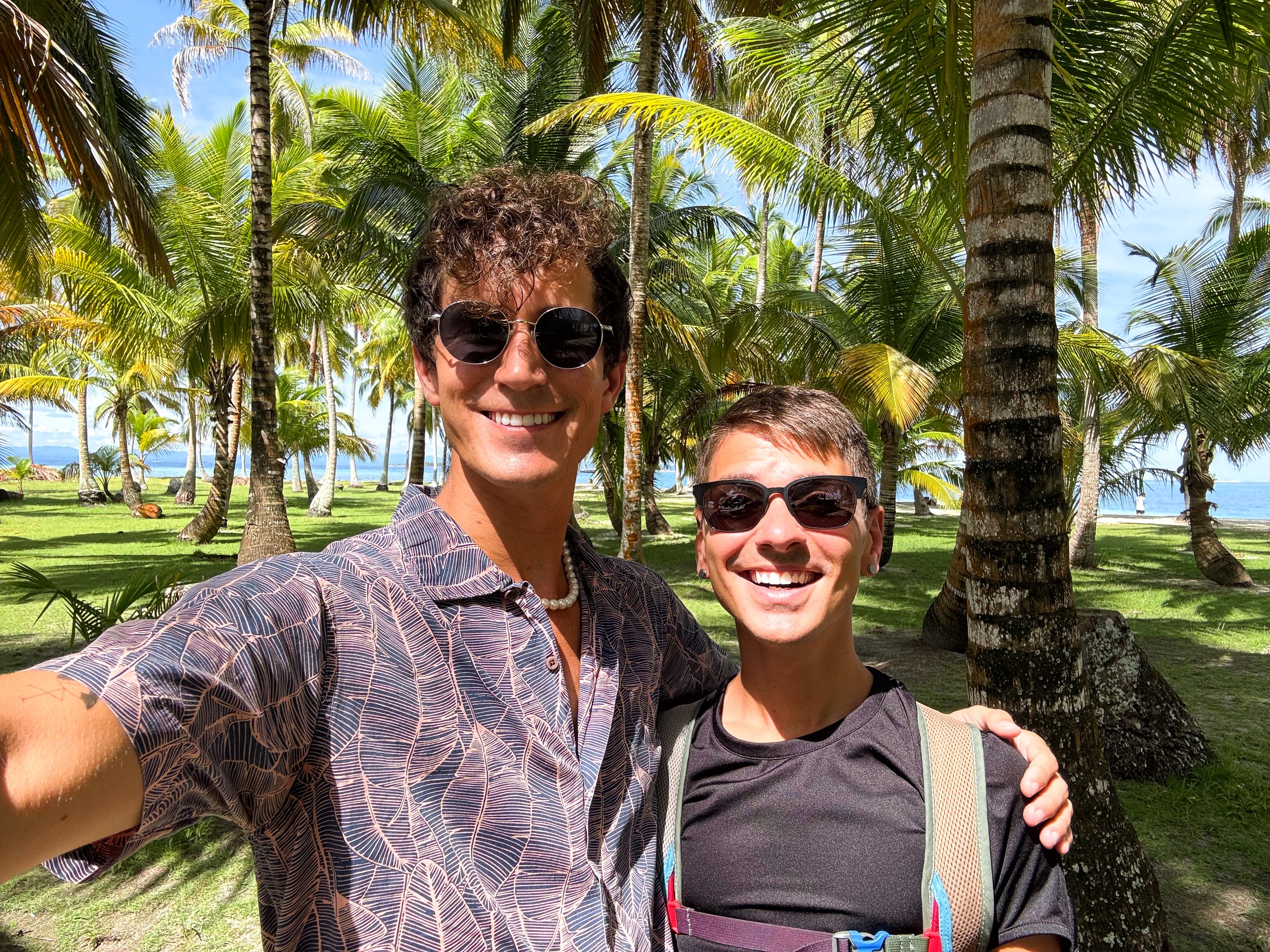
The San Blas Islands
The San Blas Islands are a series of many low lying islands and shills on the Caribbean side of the country. They are a tropical paradise for beach hopping, snorkeling and learning about the Guna Yana indigenous community.
The Guna Yana Indigenous People. The region is an autonomous zone in Panama home to and managed by the Guna Yana. While here, it’s common to see islands covered in palm reed and thatched houses, women wearing traditional Molas and fishermen paddling between islands in dugout canoes.
Touring the Islands. We voyaged into the sea passing palm covered islands, looking back to see views of Panama’s mountains as the spray of the sea misted across our faces.
Private Island. After a scenic boat ride, we arrived at a beautiful private island covered in palm trees and surrounded by sandy shores with vibrant blue water and patches of seagrass.
Sand Bar. Two hours later, our guides brought us to a shallow sand bar with crystal clear water, star fish and a small coral reef to snorkel above.
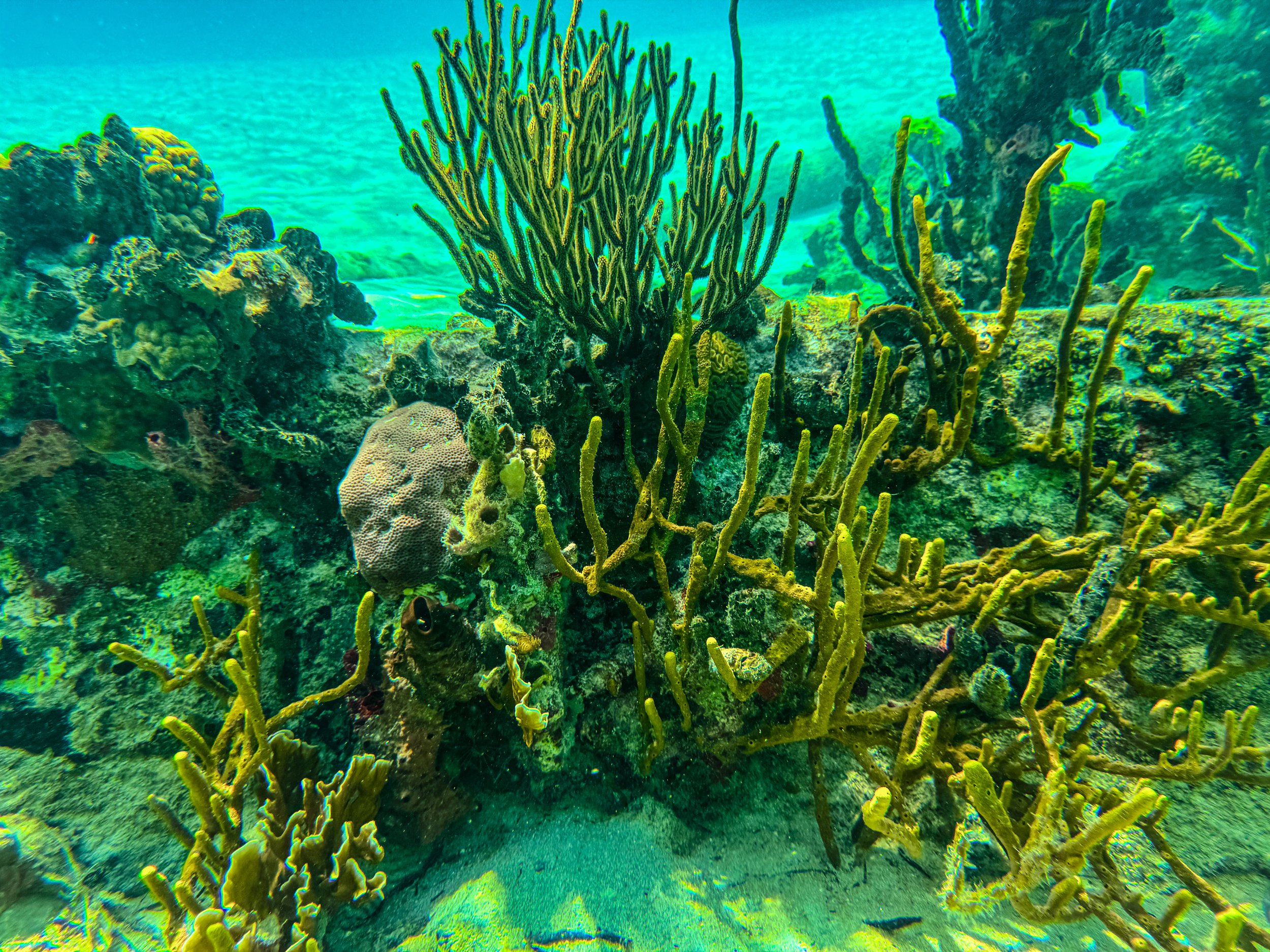
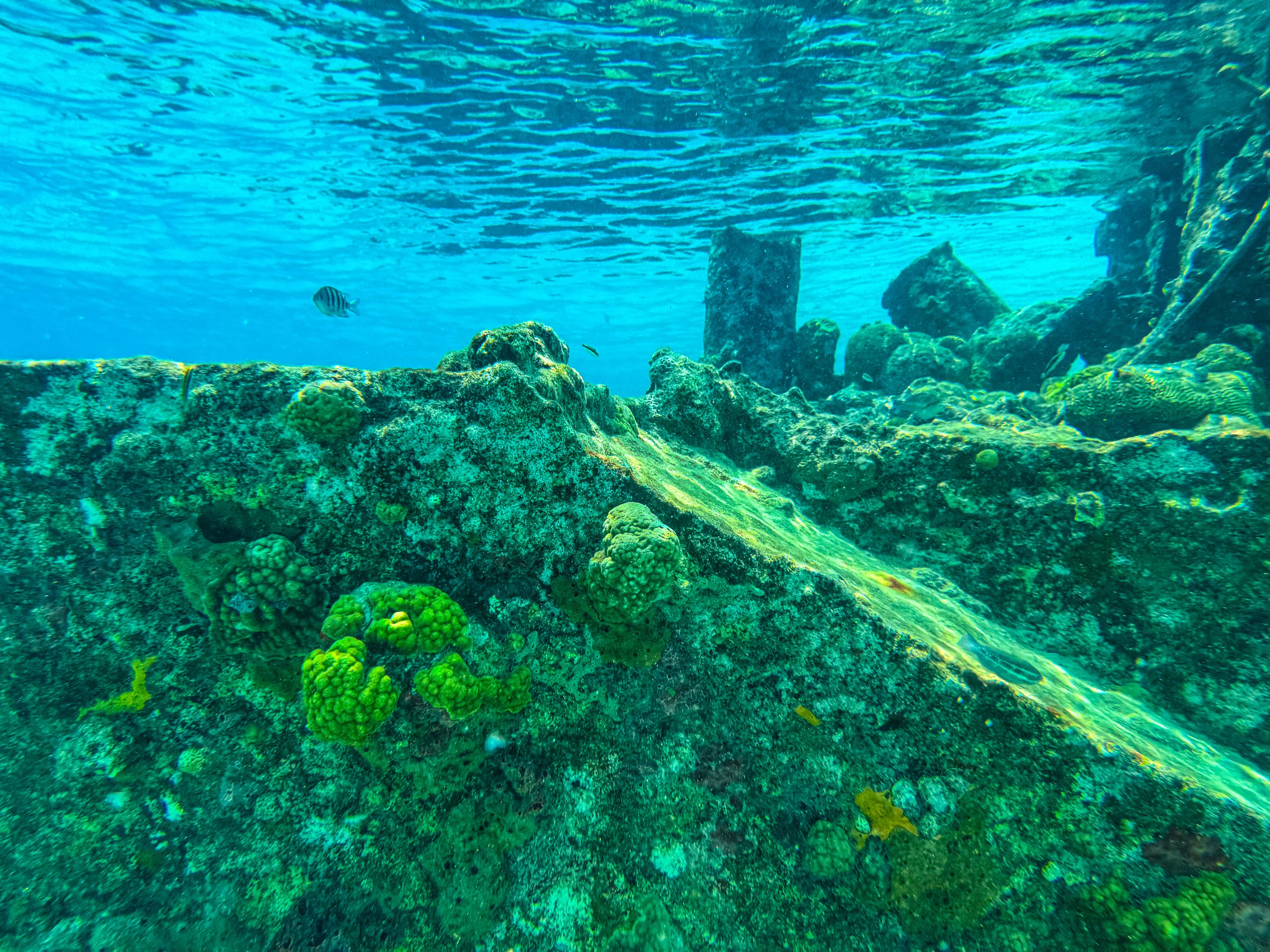
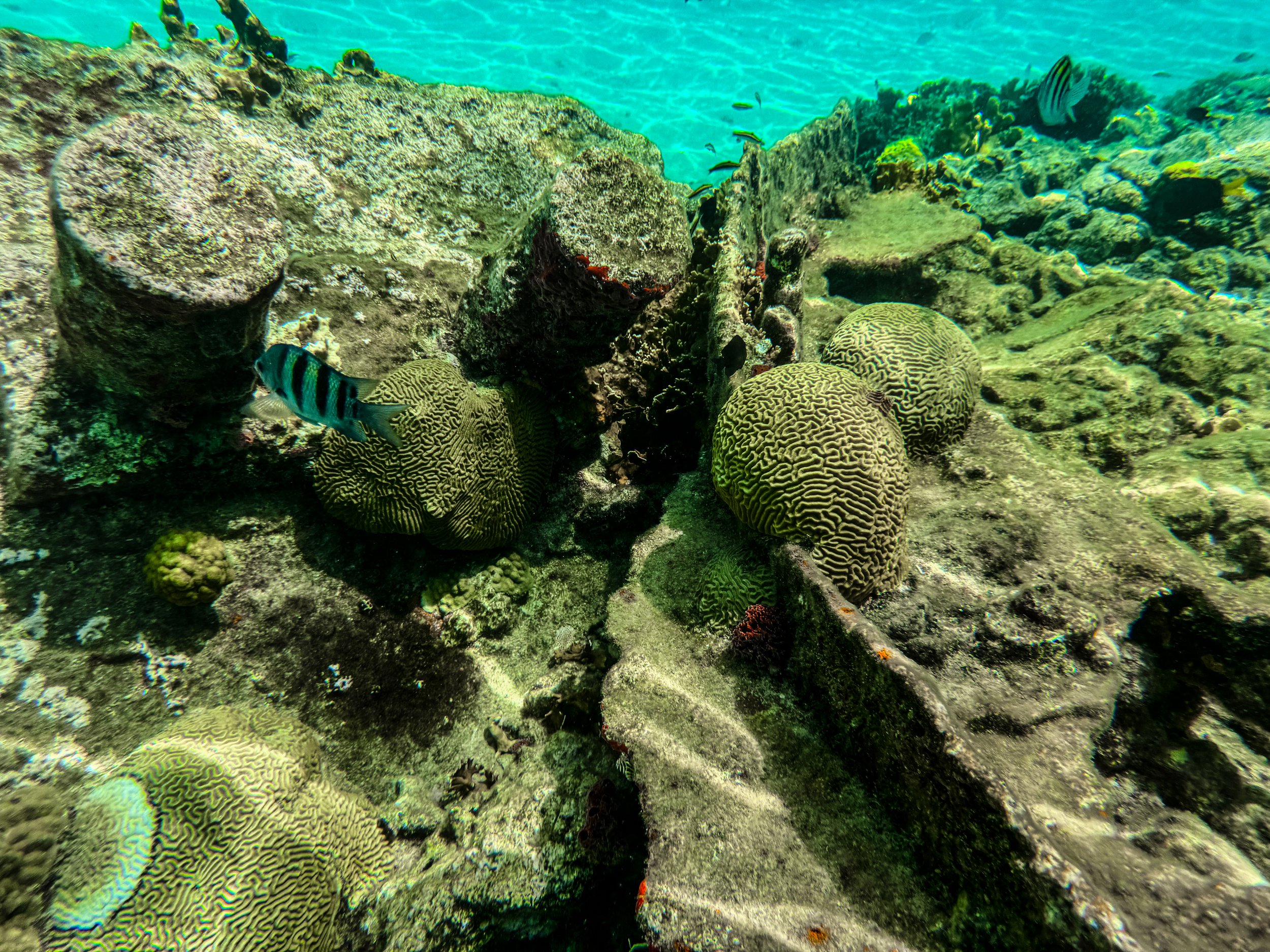
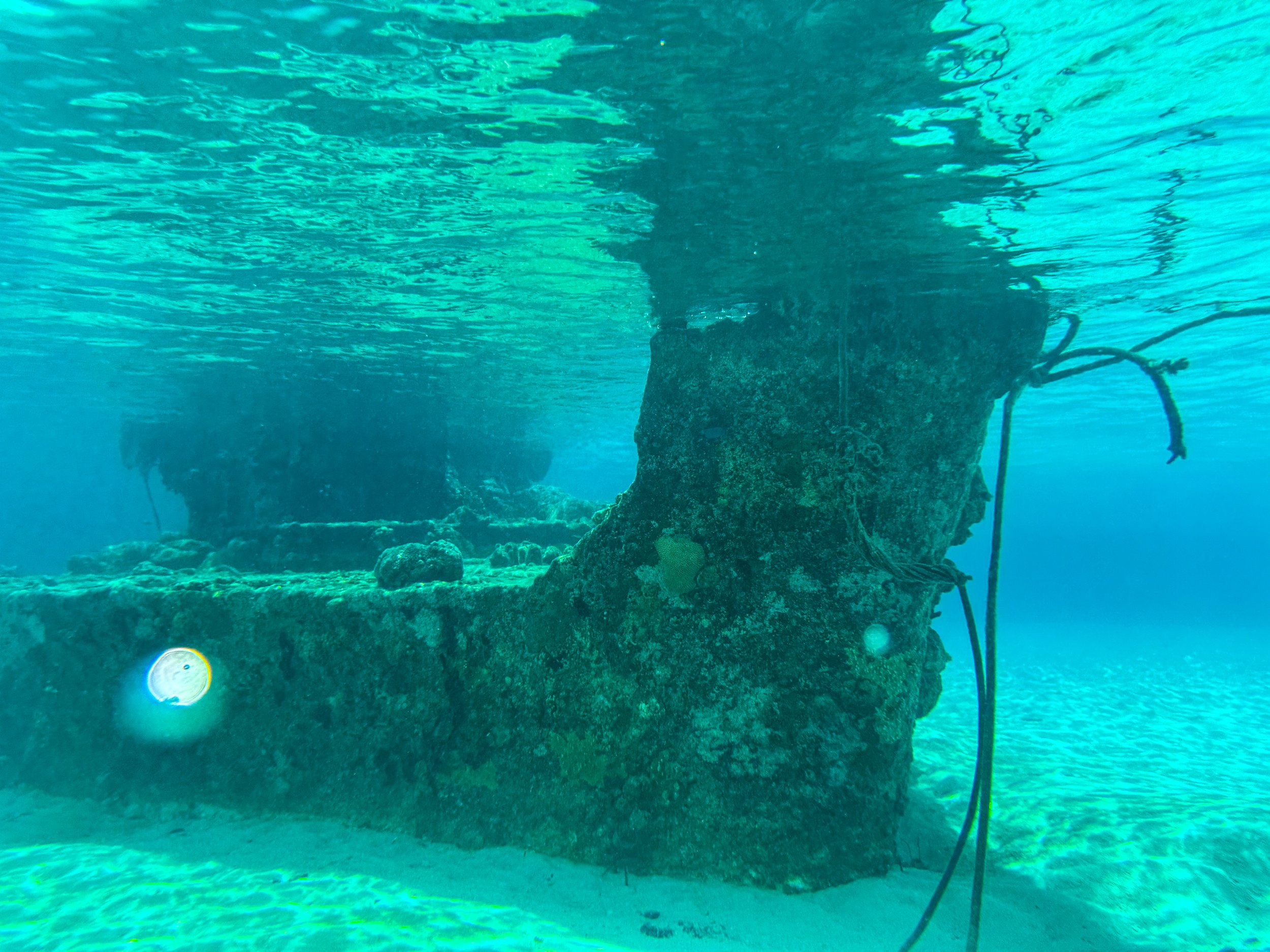
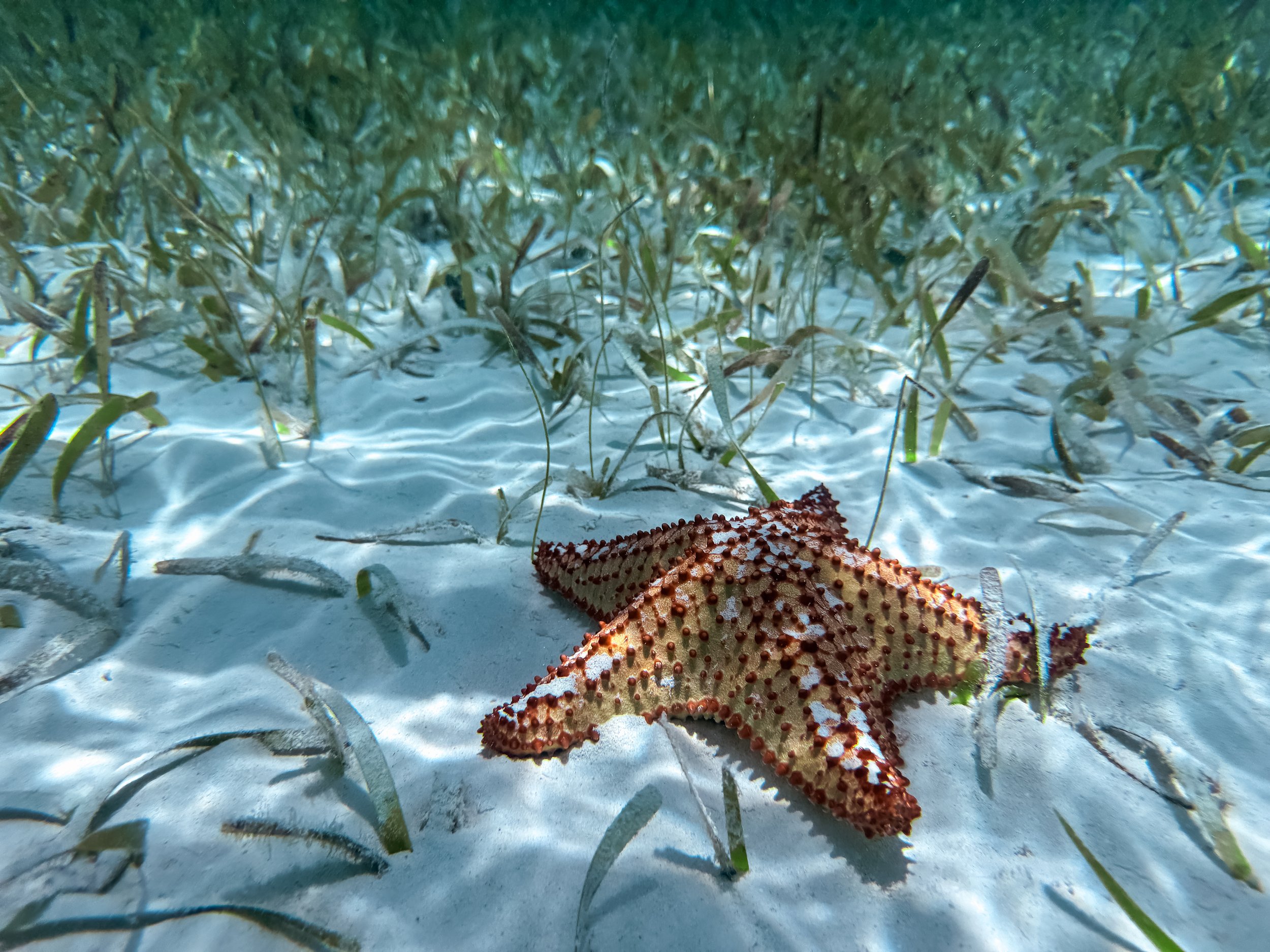
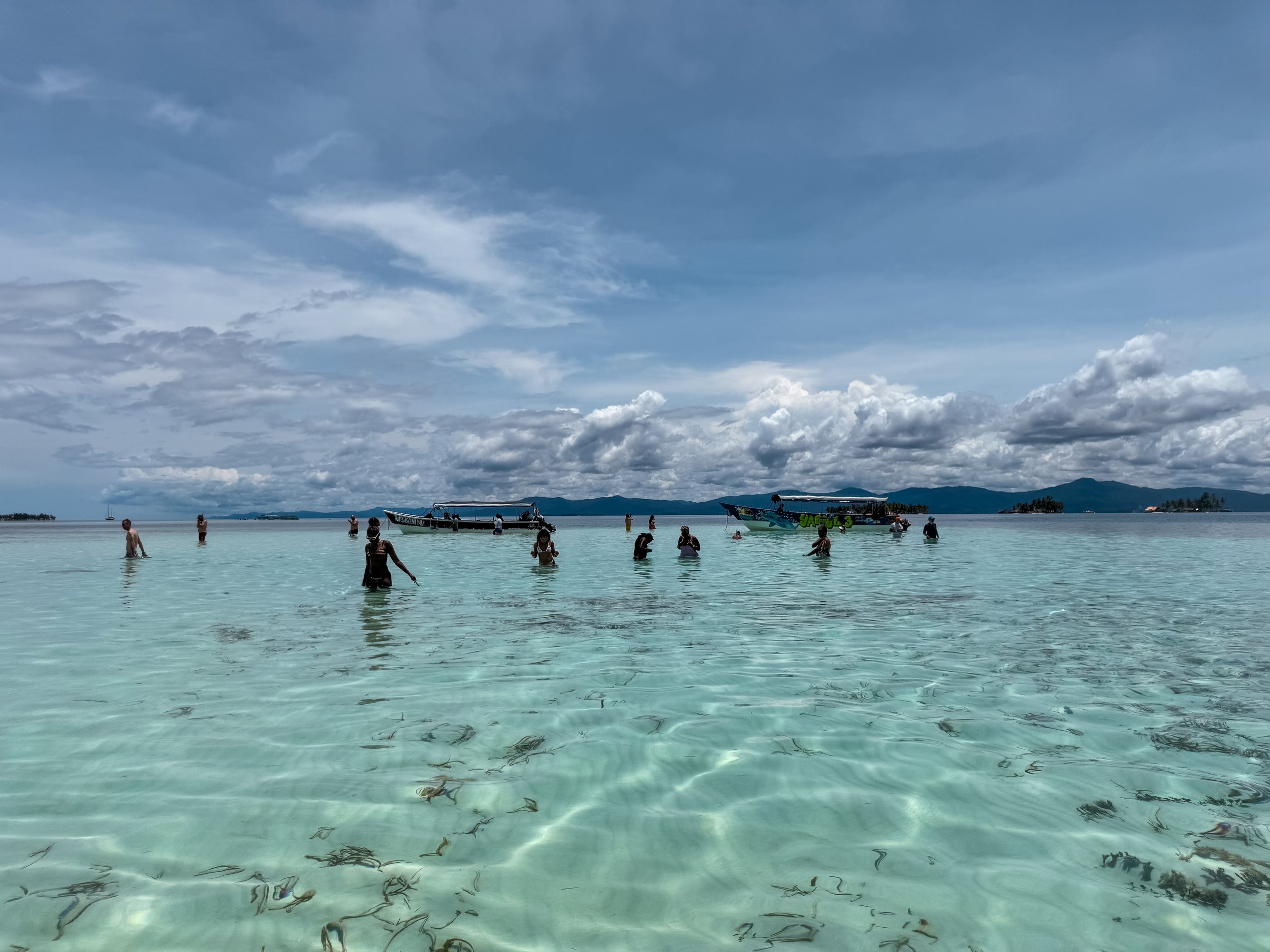
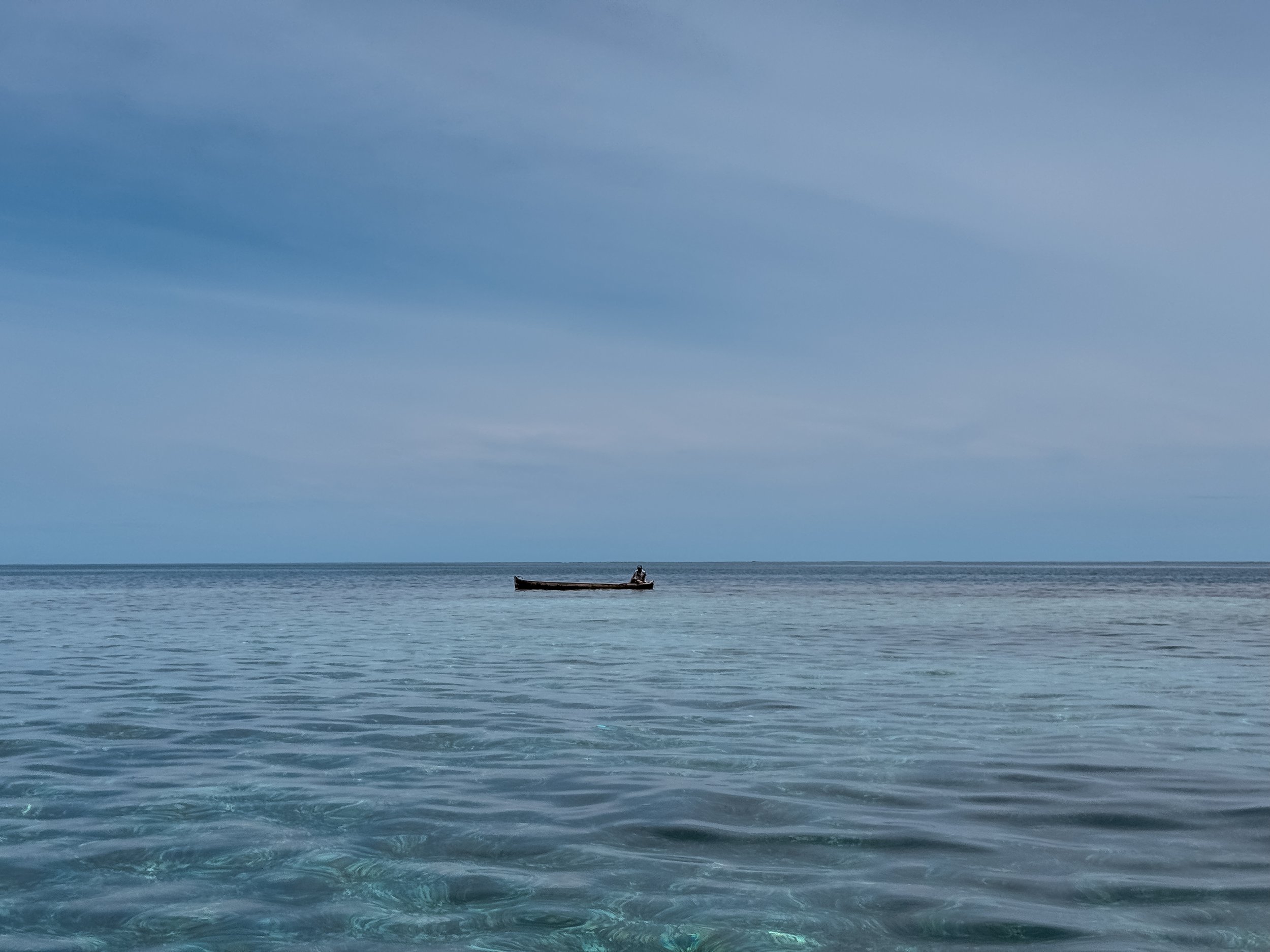
Dog Island. In the early afternoon, we arrived a an island with a sunken ship taken over by a thriving reef with all types of colorful corals and tropical fish. On shore, we were each served a whole fried corvina fish with patacones, fresh fruit and a local beer.
Isla Diablo. Towards the late afternoon, we visited one more island for beach time and tropical drinks before returning to Panama City.
Getting Here: We booked a tour with Panama San Blas Tours through Viator. Our guide picked us up at 5:15am and drove us 3 hours across the country through verdant forest and hilly terrain to reach the Caribbean coast and San Blas Islands. The last 30min of the drive are nauseating and extremely curvy with steep hills. Overall, the full day tour was incredibly memorable, very relaxing and well organized.
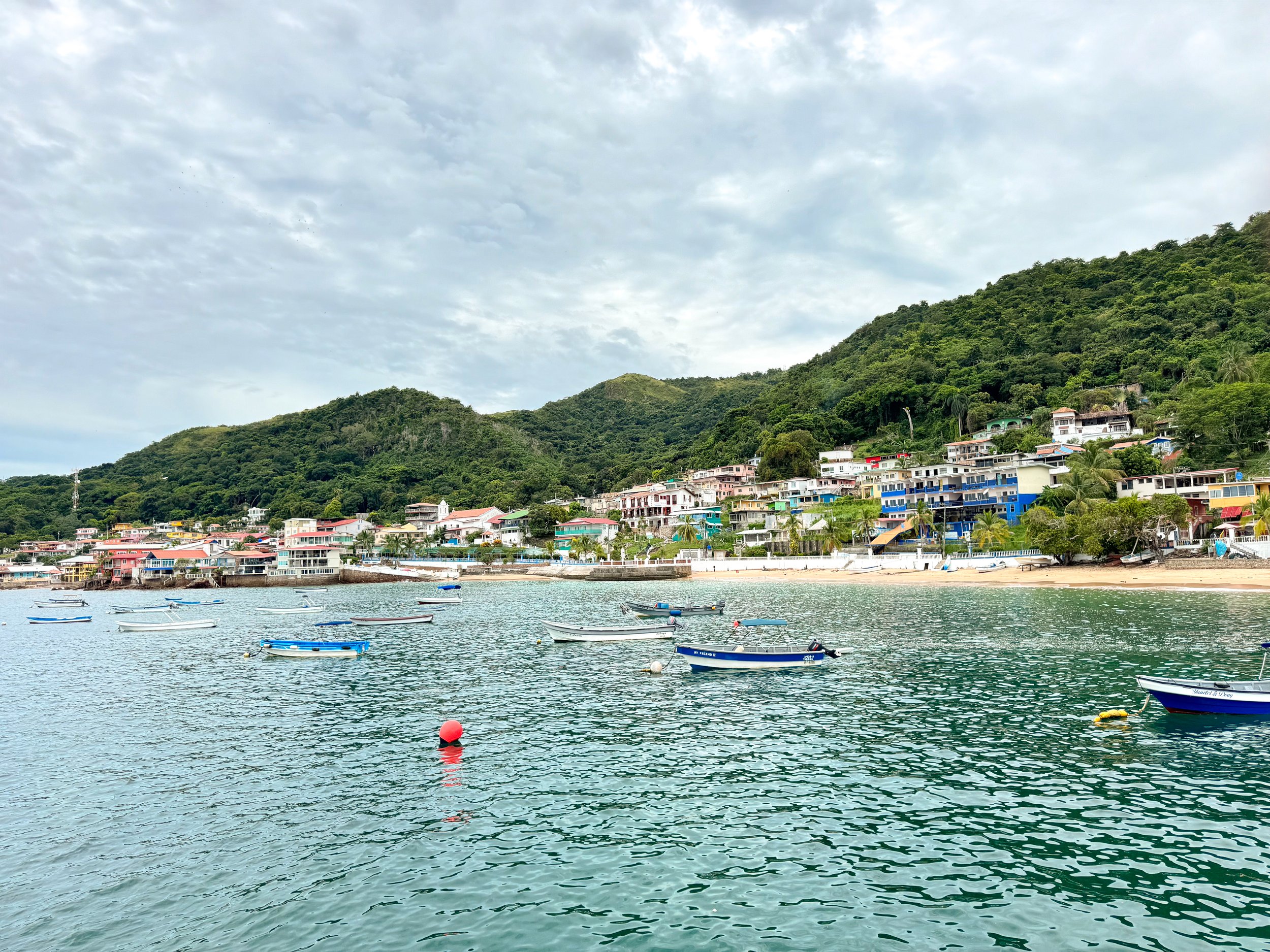

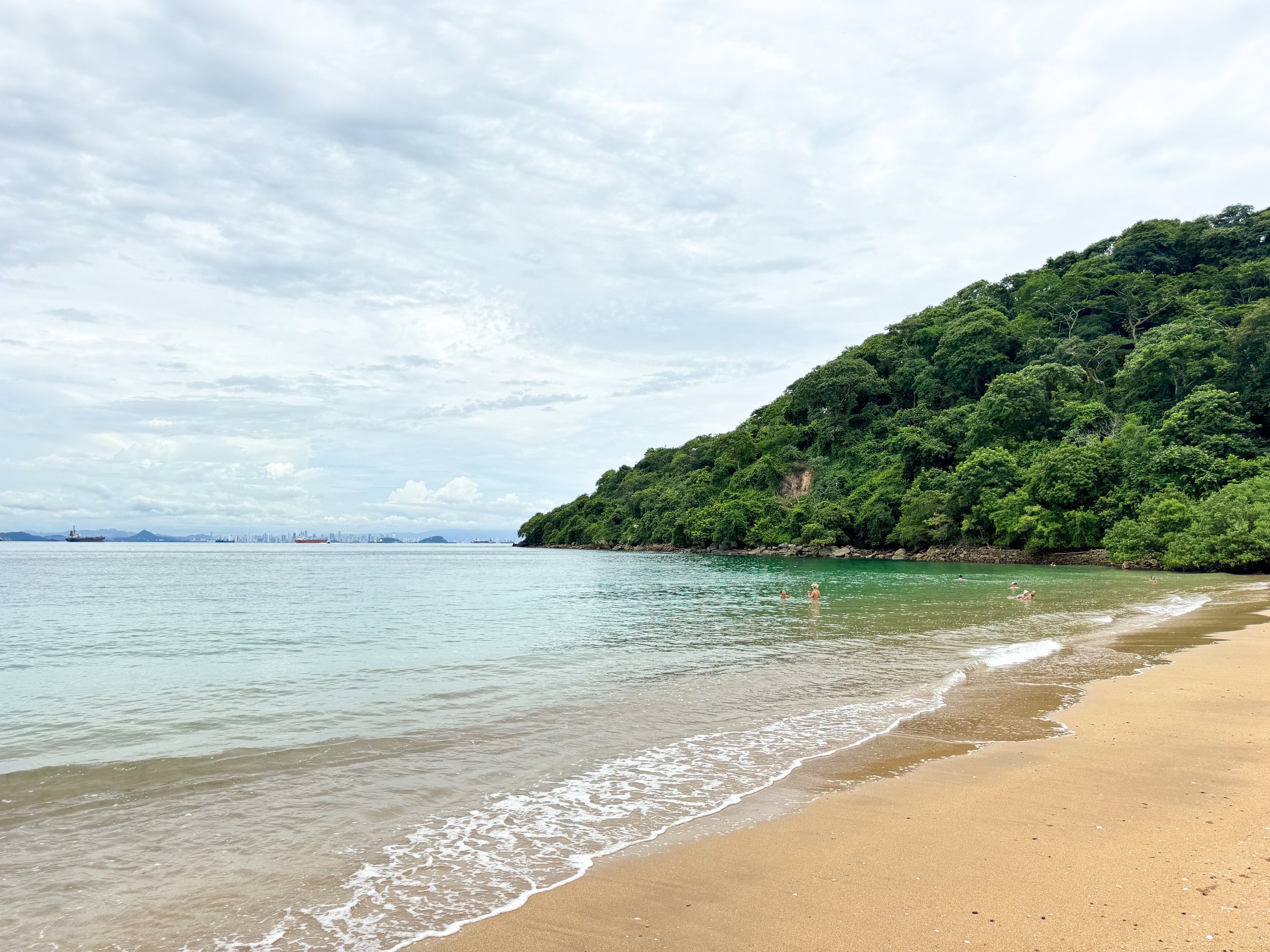
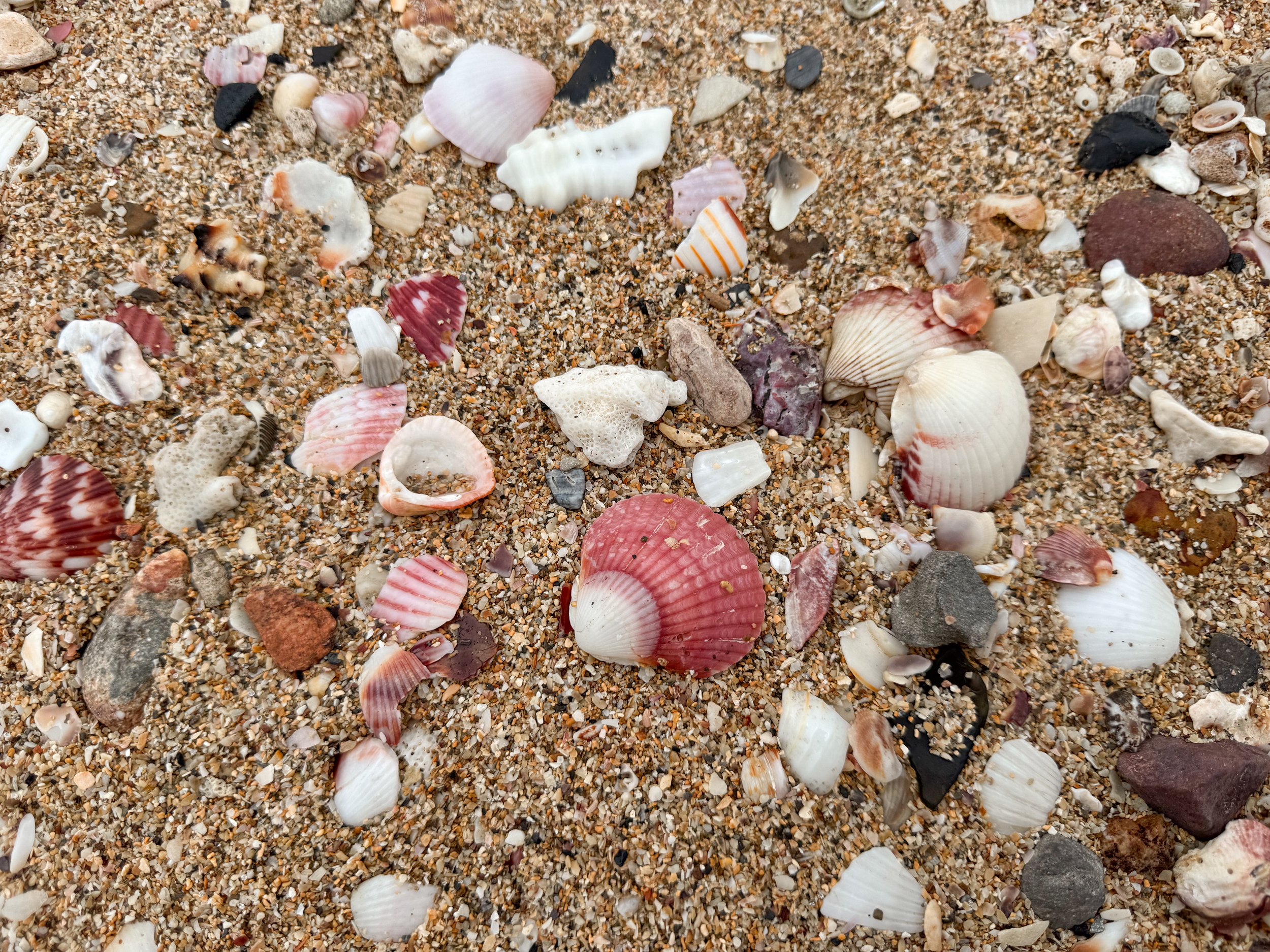
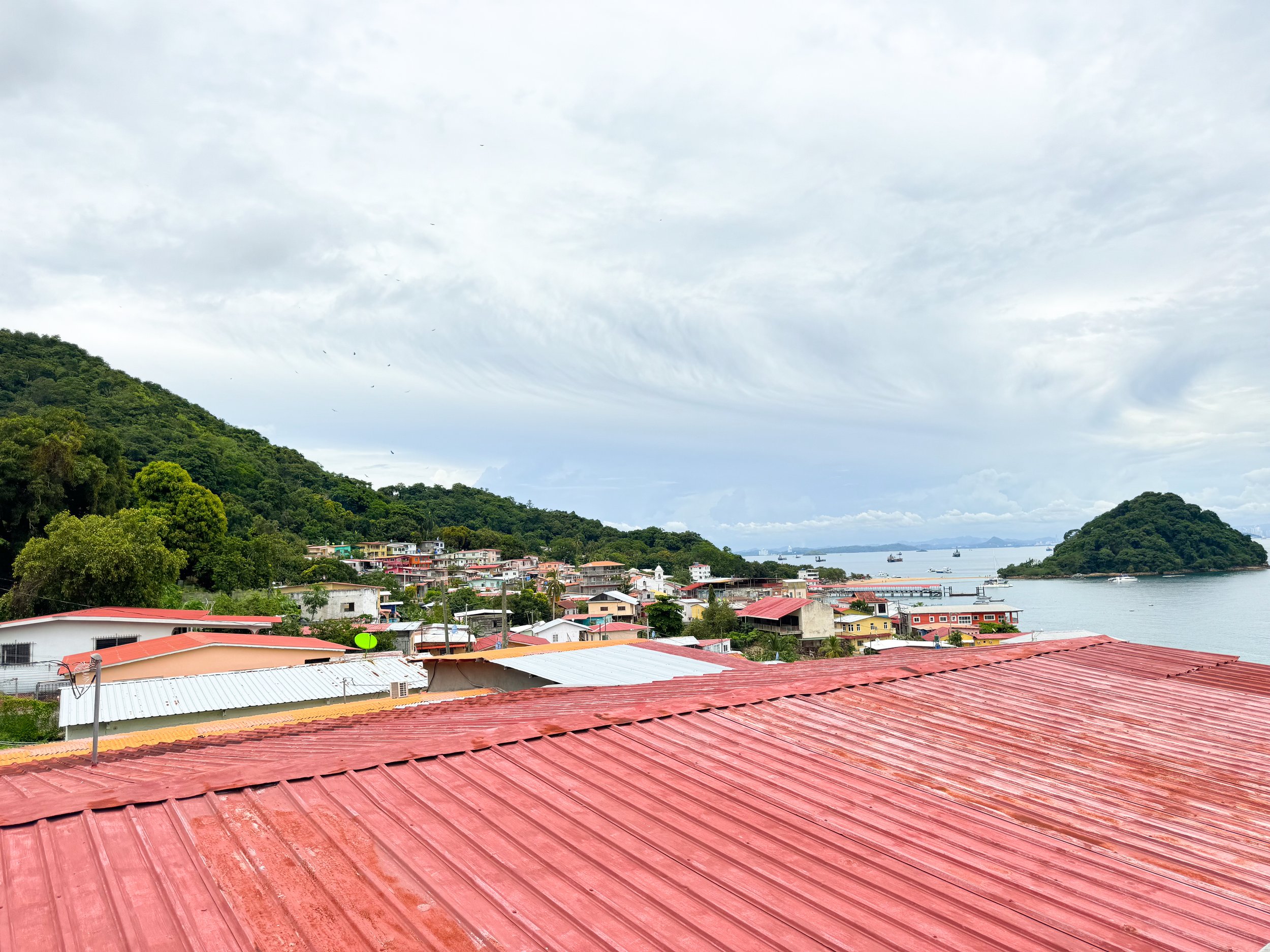
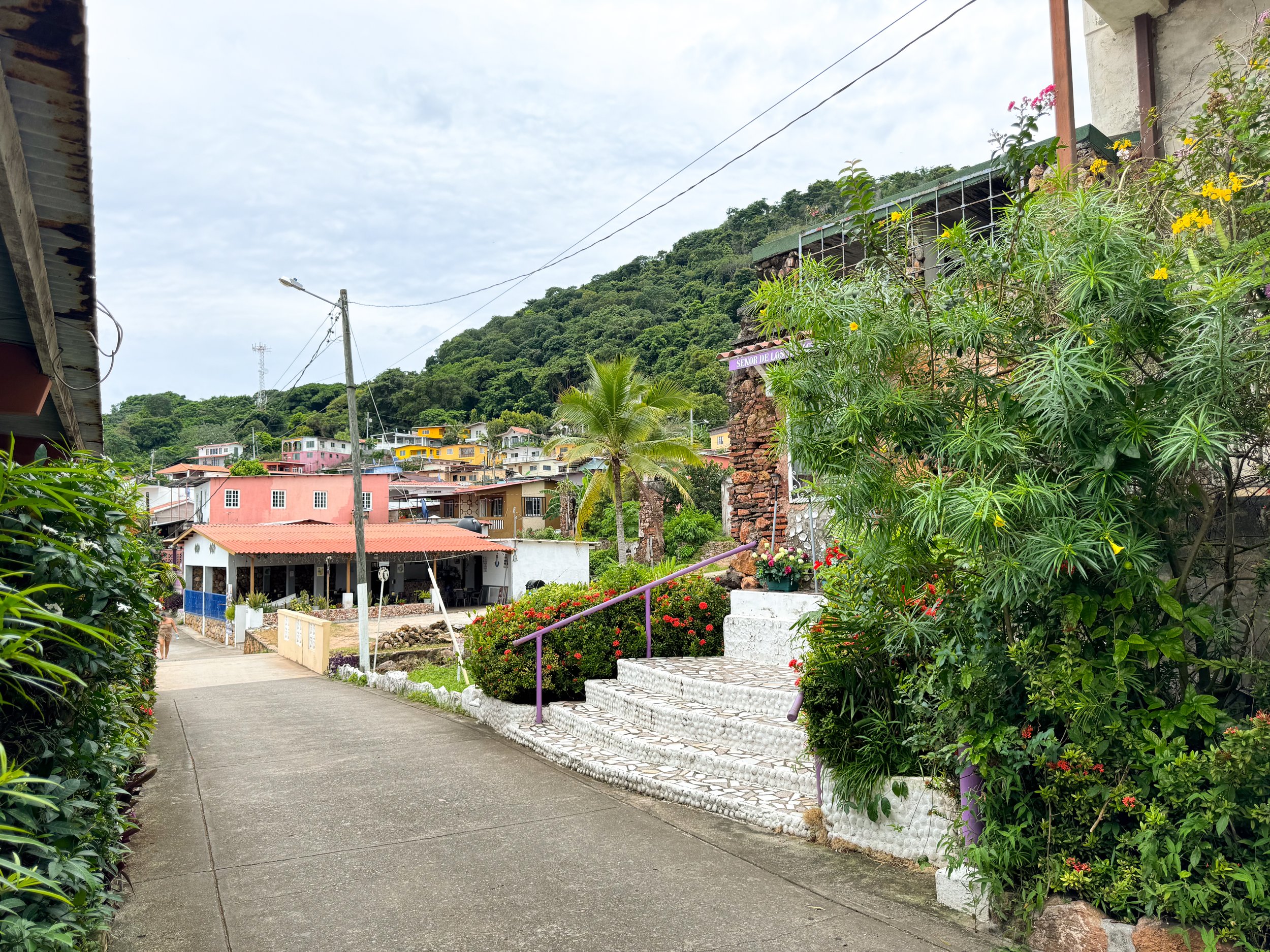
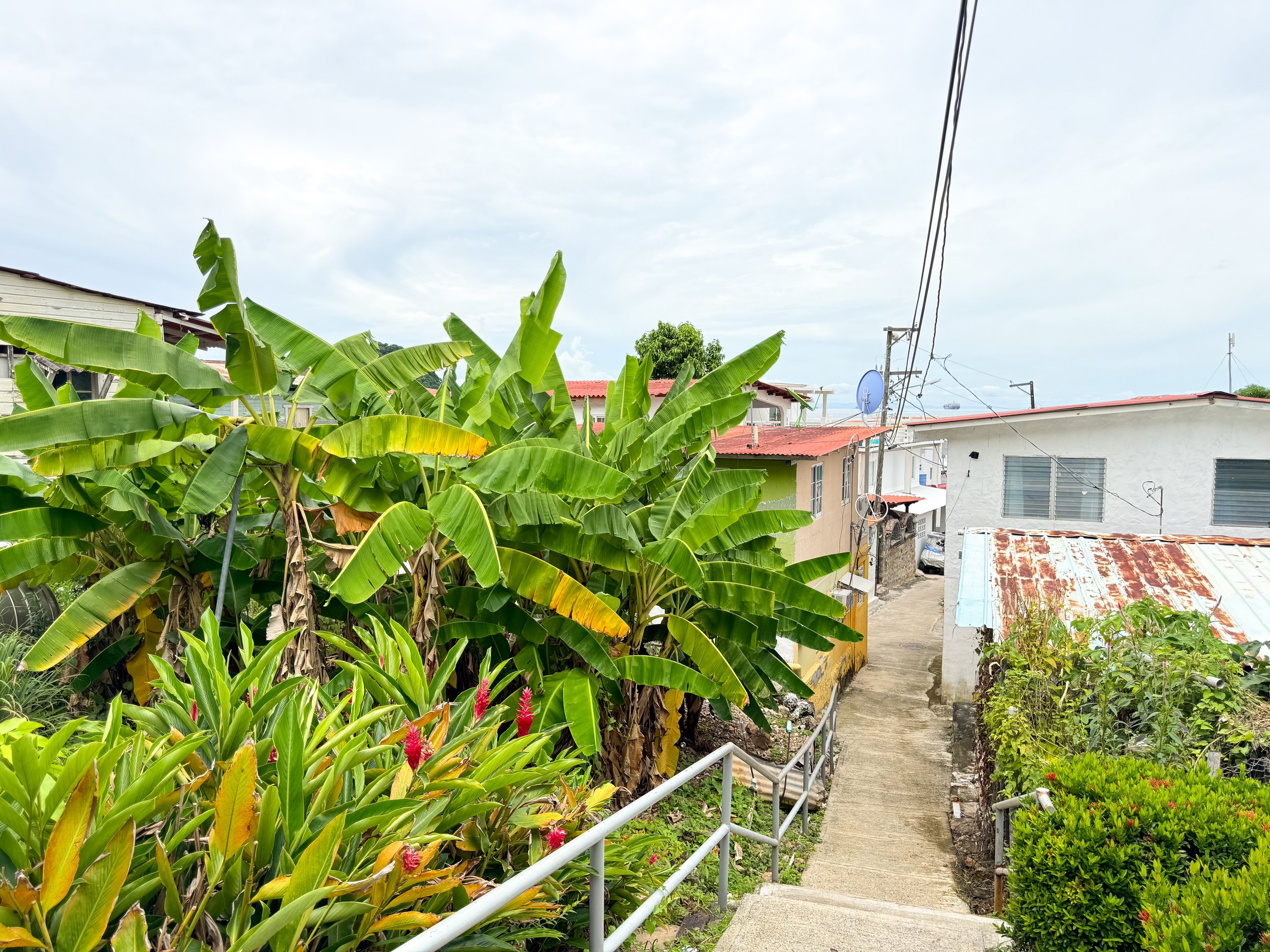
Taboga Island
The City of Taboga. Taboga is a colorful town built into the lush hillside of the island with laidback vibes, beaches and hiking trails. Here, locals drive around on golf carts and say hola (hello) or buenas (short for good day) as they pass by. The narrow streets and alleyways are lined with flowering trees and bushes with many light boxes housing statues of the Virgin Mary.
Playa La Restinga. A clean sandy beach that bridges Taboga and Morro Islands with views of the ship dotted harbor and Panama City skyline in the distance. The shore is covered in pink and white sea shells seen as decor on houses across the island. There are vendors selling beachwear, serving piña coladas in pineapples, preparing fried seafood and renting umbrellas, lounges and boats.
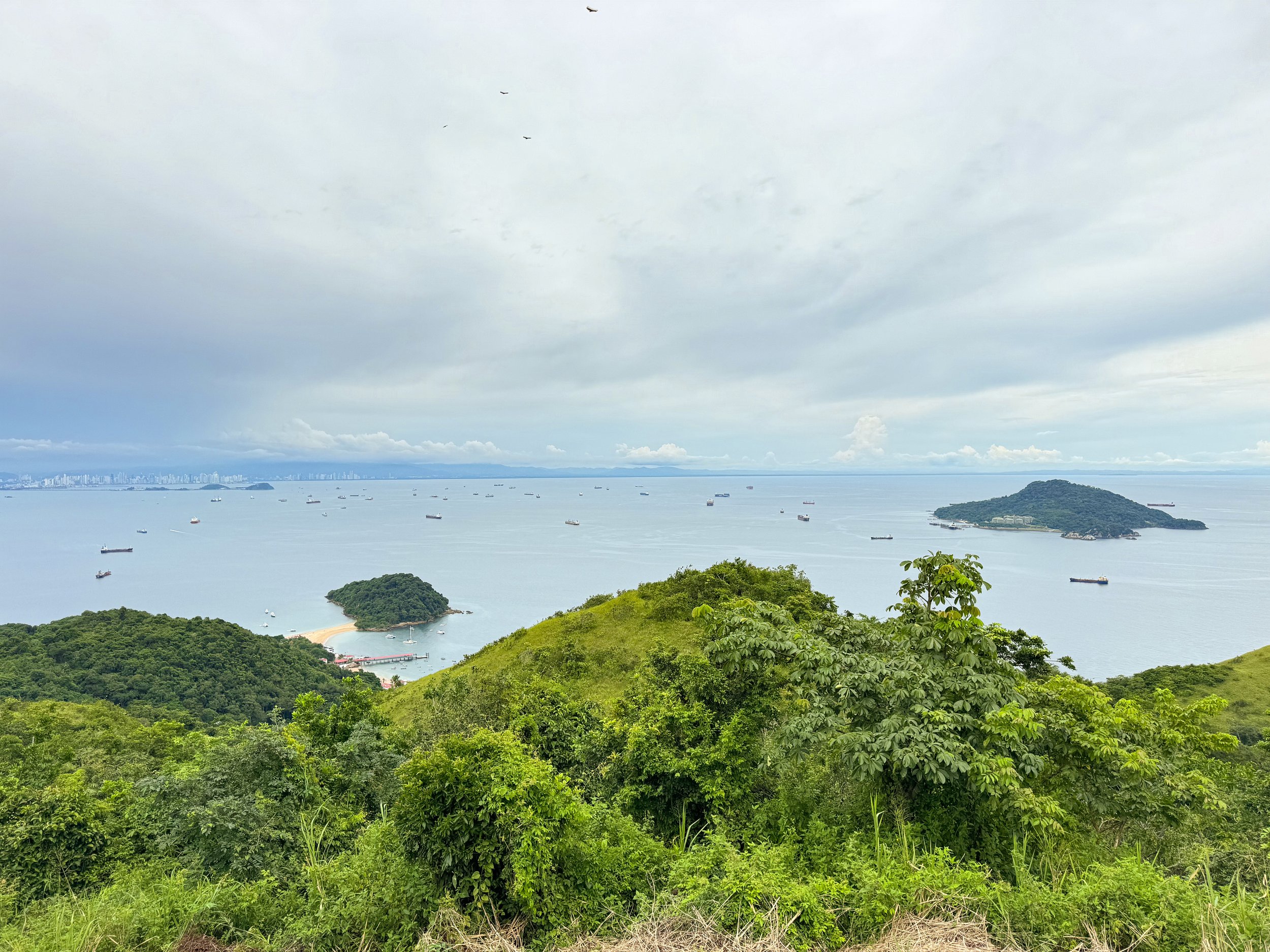
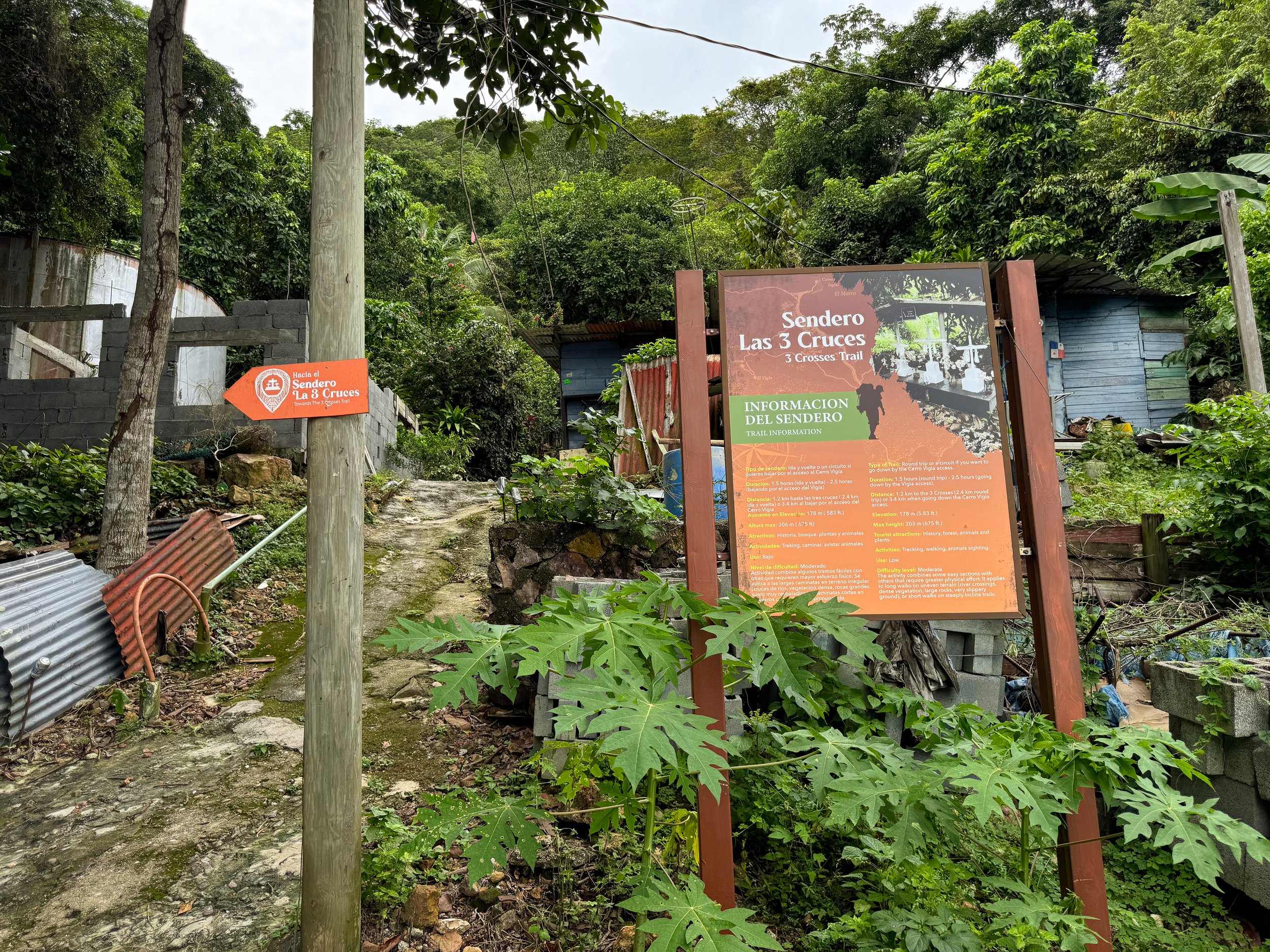
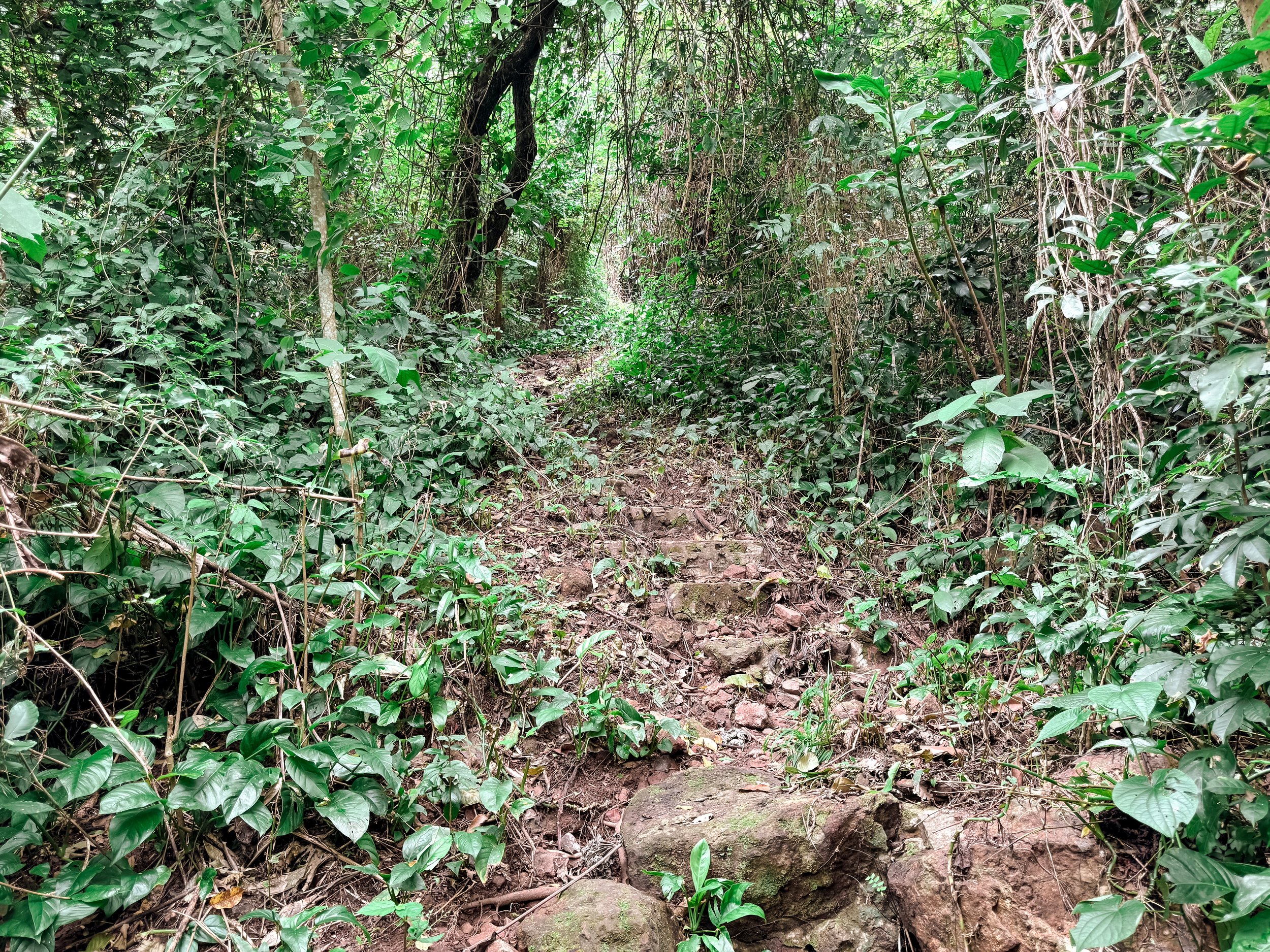

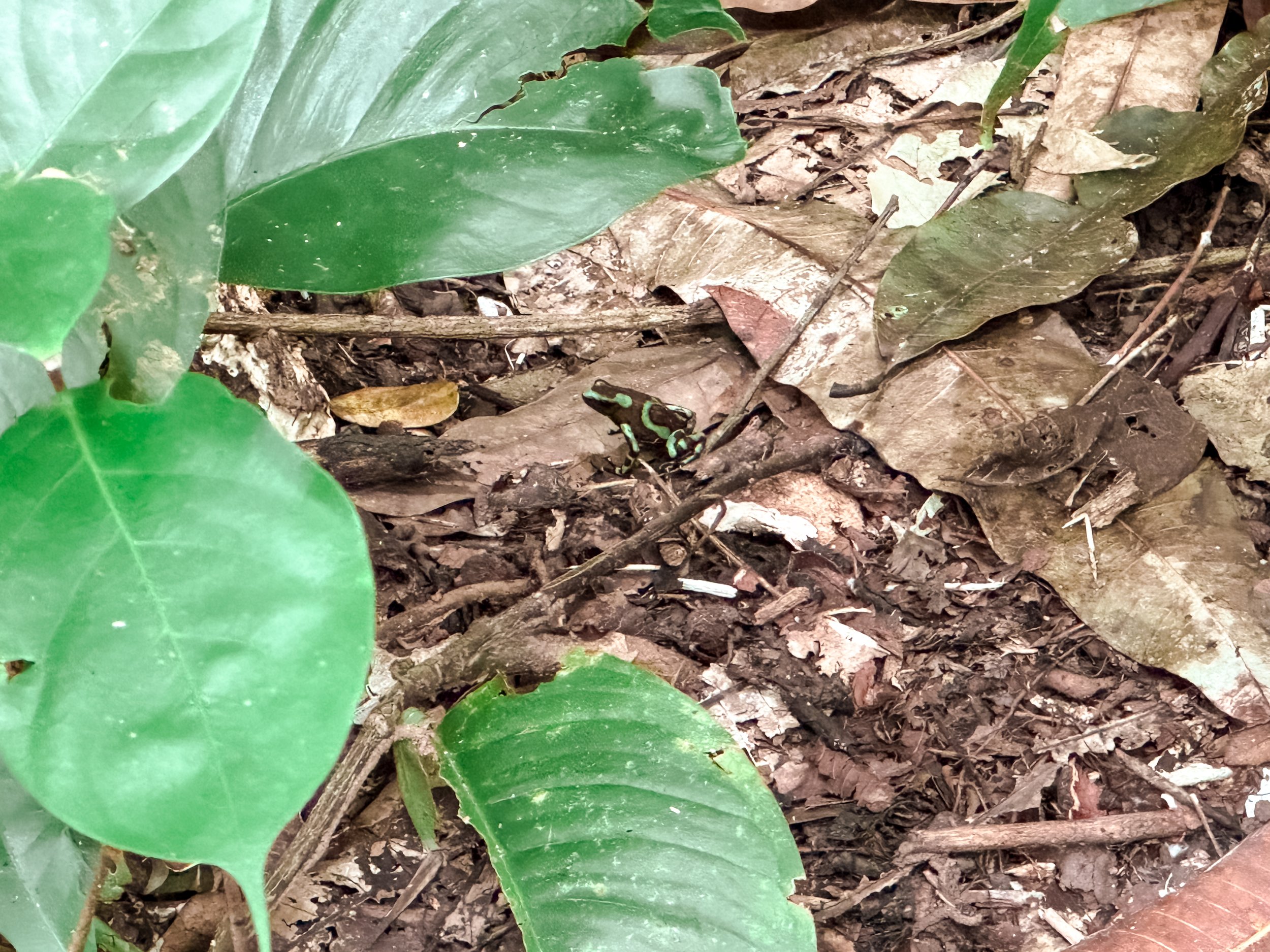
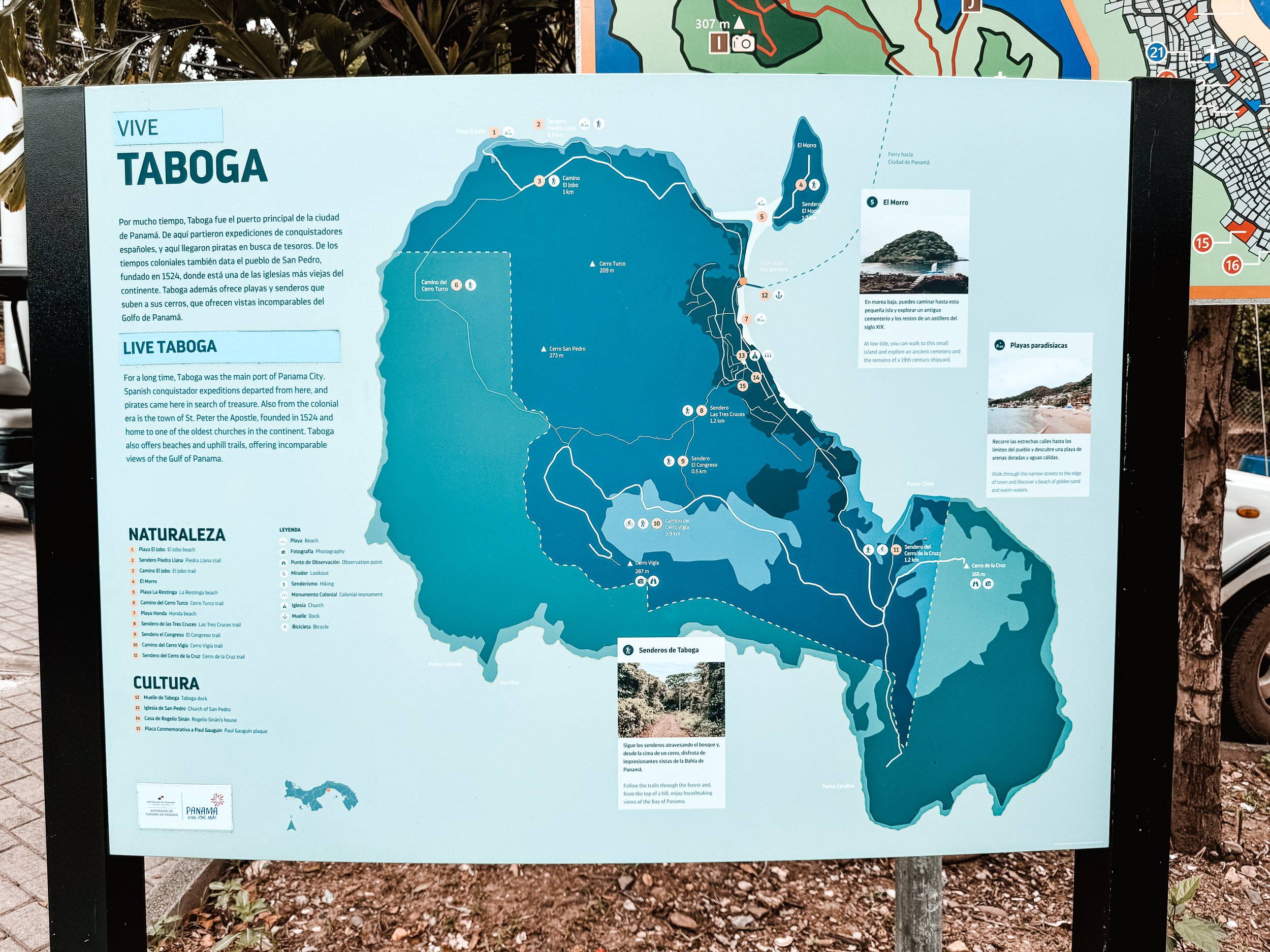
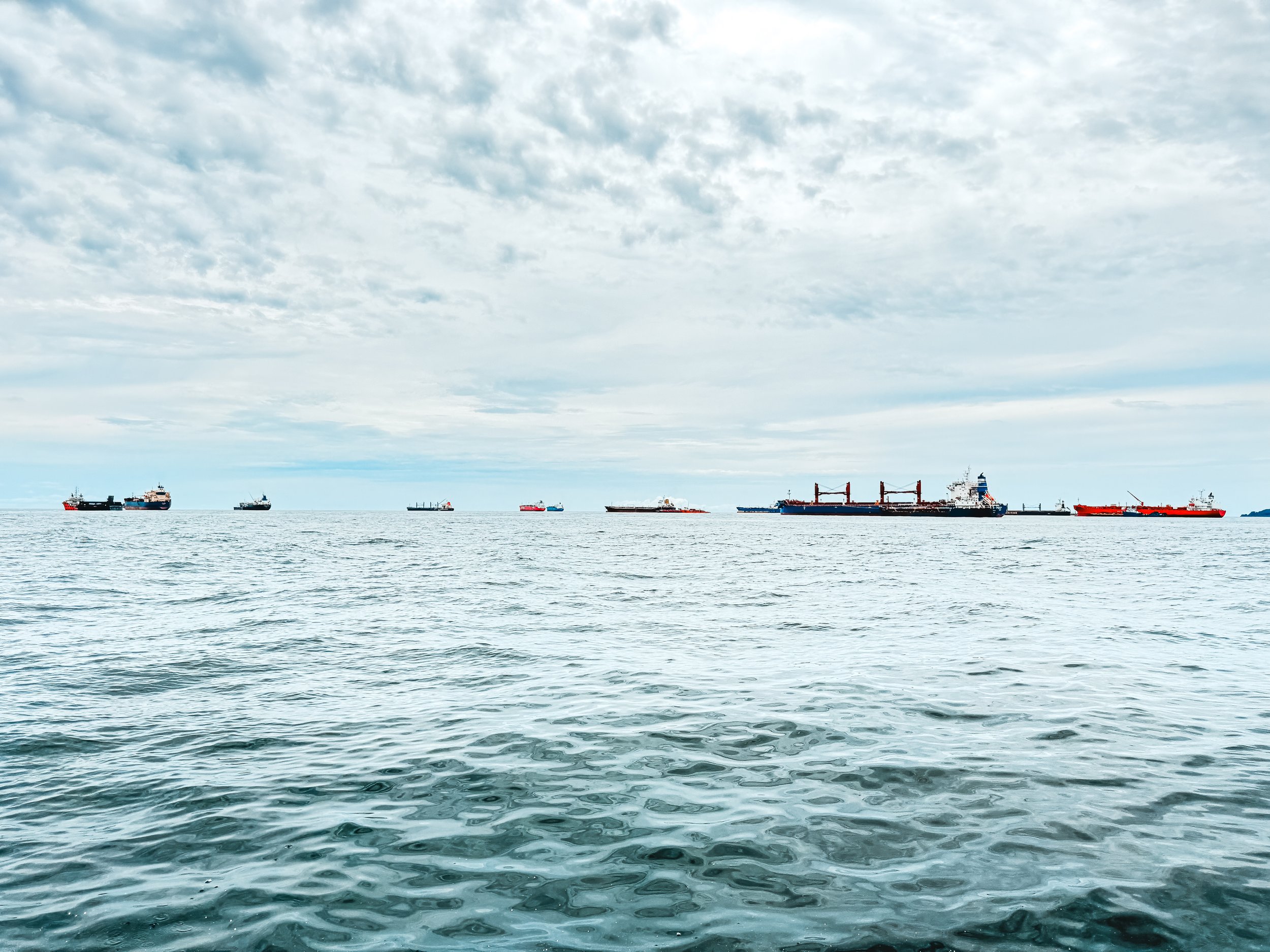
Sendero de Tres Cruzas. Following the winding walkways up the hillside, we reached the trail head. The trail leads deep into nature so much so that you forget about that a sprawling metropolis is still nearby. As we hiked through the humid forest, we heard the sounds of breaking of branches, the falling of fruit, bussing insects and squawking birds. Along the way, we spotted tarantula, numerous neon green and black poison tree frogs, large iridescent blue butterflies, skittish lizards and spiraling vortexes of vultures.
Cerro El Vigía. Sendero de Tres Cruzes leads to an uphill but easy to walk road to the island’s summit, Cerro El Vigía. From the summit, the town of Taboga is dwarfed by the panoramic views of the lush island, hundreds of ships anchored in the bay and city beyond.
Getting Here: Visiting Taboga is an easy day trip from Panama City. We took the Taboga Express Ferry from the Amador Causeway. Along the 30min boat ride, the ferry passes dozens of anchored freighters and ships from all over the world waiting to enter the Panama Canal.
What to Eat & Drink
Cuisine
Ceviche. White fish cured in lime juice with peppers, red onion and cilantro. It’s one of the most poplar dishes seen at restaurants across Panama.
Corvina. A white fish popular in Panama. It’s often grilled or fried whole.
Paella. A pan rice dish cooked in a pan with broth, spices, veggies, and meat. It’s also called One Pot on the Caribbean side of the country.
Patacones. Twice fried and smashed plantain.
Rice & Beans. The classic Central American dish made from the two ingredients with spices.
Hojaldra. Fried dough often served at breakfast.
National Beers
Balboa. A semi nutty bear similar to a Modelo.
Panamá. A light beer similar to a Bud Light.
San Felipe. A pretty standard and easy drinking lager.
Where to Stay
La Manzana. A large mixed use building with modern apartment rentals, artist studios and a co-working space. It’s a quick 10 minute walk through the arts district to Casco Viejo. We stayed in well equipped and designed a studio here during our time in Panama City. Book here on Airbnb.
Getting Around
By Metro. Panama City has a very modern and efficient metro system with two lines crossing town. We took the metro from the airport to just outside of Casco Viejo neighborhood.
By MetroBus. Buses are the most economical way to navigate the Panama City though inefficient. Expect to wait a minimum of 30 to 45 minutes for most lines.
Albrook Station. Panama’s Central Terminal for the metro and buses. City buses from here are generally efficient and affordable. There are routes from here to destinations across Panama.
Tarjeta Recargable Para Metro y Metrobus. Buy a re-loadable card at any metro station for $2. Fares cost around $0.25 to $0.50 for both metro and metrobus.
Yellow Cabs. Taxis are all over the city. Drivers looking for fares will often tap their horn looking for passengers as they drive around the city.
Uber. A secure alternative to taxis. Fares cost $1-$10 to get around the city depending on distance and time of day or $20-$30 to/from the airport.
On Foot. Casco Viejo is very walkable. Any further distances will require public transit or an Uber.
Panama Stop Over
We booked our flights with Copa Airlines taking advantage of their stopover program when transiting through Panama City. The airline paid for our flight to Panama City in route to your our destination. Stopovers can last anywhere from a minimum of 24 hours to a maximum of 7 days. We stayed the full 7 days. This saved us hundreds of dollars on flights and allowed us to visit a county that’s been on our list for years!
Good To Know
Currency: Panama uses the Panama Balboa and US dollar interchangeably. They are valued equally.
Toilets: Like many places in Central and South America, the plumbing can’t handle toilet paper. If there is a bin next to a toilet, that’s where it’s intended to go.
Language: Spanish and English are widely spoken by most people, restaurant menus and most museums have descriptions in both languages.
Ticket Prices: The costs for foreign tourists at most sights and museums are about 20-30% higher.
Tipping: 10-15% is standard for tipping
Safety: We found Panama to be a very safe country. People are friendly & helpful. There is a strong tourist police and military presence throughout Panama City, especially the old town, likely due to the president’s residence being here.
Tourism: We did not come across a single American tourist. Many people visiting came from across Panama and other country’s in South America.
LGBTQ: Panama is a very welcoming country to the LGBTQ community. We saw many other gay couples, travelers and tour operators.
For Next Time…
We loved our time in Panama and with Copa Airline’s Stopover Program, we will certainly be returning. When we do, we hope to visit more areas along the Pacific and Caribbean coasts.
Coiba National Park. A bio reserve with beaches, reefs and rainforest. Come to hike the rainforest, snorkel with marine life, swim with whale sharks, surf pacific waves, spot tropical birds, monkeys and sloths.
Bocas del Toro Archipelago. A chain of 300 plus Caribbean islands with beaches, coral reefs and surfing spots. It’s hub for Afro-Caribbean cultures with calypso, reggae and soca music and cuisine made from seafood cooked in coconuts and seasoned with spices. Popular islands to visit are Colon, the Bastimentos and Carenero.





